
BULLETIN
SUMMER 2007 VOLUME 53
NUMBER 2
2@2
PLANT SCIENCE
ISSN 0032-0919
Editor: Marshall D. Sundberg
Department of Biological Sciences
Emporia State University
1200 Commercial Street, Emporia, KS 66801-5707
Telephone: 620-341-5605 Fax: 620-341-5607
Email: psb@botany.org
The Botanical Society of America: The Society for ALL Plant Biologists
The University of Northern Iowa Botanical Center–70 years of Progress.........................38
The Lloyd Library and Museum, Cincinnati, Ohio.................................................................41
Linnaeus........................................................................................................................................44
CITES and the Herbarium Voucher...........................................................................................47
News from the Society
Notes from the Office..................................................................................................................51
BSA Awards................................................................................................................................52
From the President......................................................................................................................53
BSA Education News and Notes..............................................................................................55
Announcements
Personnalia
Peter H. Raven to receiveWorld Ecology Award from UMSL.............................................57
UW-M Emeritus Professor Awarded Honoris Causa Ph.D. Degree from Mexico’s
Second Largest Public University...........................................................................................58
AIBS Education Award..............................................................................................................59
The Rupert Barneby Award.......................................................................................................59
Symposia, Conferences, Meetings
Visiting Field Museum’s Collections....................................................................................60
An invitation to the 2007 annual Joint Field Meeting of theBotanical Society of
America - Northeastern Section,Torrey Botanical Society, and Philadelphia
Botanical Club:............................................................................................................................60
Positions Available
Department Head of Education Longwood Gardems, Inc....................................................62
Other
Women Pioneers in Plant Biology............................................................................................64
Countryman Family Gift to Pringle Herbarium......................................................................64
Call for Nominations, Editor of Chinquapin, The Newsletter for the Southern
Appalachian Botanical Society.................................................................................................65
Call for Papers, CBE—Life Sciences Education, Announces a Special Issue:
Issues in Developmental Biology Education ........................................................................ 65
An Ancient Tree Now Grows in Brooklyn: Brooklyn Botanic Garden Debuts The
Wollemi Pine “Living Fossil” Is Added to the Garden’s Trail of Evolution Exhibit .......66
Web Library of Botanical Reference, Rare Books Now at +500,000 Pages........................67
Plants of Merit are the Focus of a Photo Contest..................................................................68
Book Reviews
..............................................................................................................................69
Books Received
..........................................................................................................................86
Botany 2007
.................................................................................................................................88

3 8
Plant Science Bulletin 53(2) 2007
P
LANT
S
CIENCE
B
ULLETIN
POSTMASTER: Send address changes to:
Botanical Society of America
Business Office
P.O. Box 299
St. Louis, MO 63166-0299
E-mail: bsa-manager@botany.org
Address Editorial Matters (only) to:
Marsh Sundberg, Editor
Dept. Biol. Sci., Emporia State Univ.
1200 Commercial St.
Emporia, KS 66801-5057
Phone 620-341-5605
E-mail: psb@botany.org
ISSN 0032-0919
Published quarterly by Botanical Society of America, Inc., 4475 Castleman Avenue, St. Louis,
MO 63166-0299. The yearly subscription rate of $15 is included in the membership dues of
the Botanical Society of America, Inc. Periodical postage paid at St. Louis,MO and additional
mailing office.
Periodically we’ve tried to highlight some of the
botanical “hidden gems” that can be found around
the country. These may be facilities of general public
interest, botanical resources for formal or informal
teaching and/or institutions to facilitate research on
a variety of botanical topics. This month we’re
pleased to feature two such “gems.”
Throughout the years I’ve had an opportunity to visit
a number of “teaching greenhouses” located at
colleges and universities throughout the country.
Occasionally there is a real stand out. One of these
was the new facility on the Hamilton campus of
Miami University that was featured two issues ago
[PSB 52(4)]. Another is the more “mature” facility at
the University of Northern Iowa (UNI) that leads this
issue. This is an older range that has grown in
stages but always with the mission of showcasing
plant diversity while providing space for student and
faculty research. UNI has done a particularly good
job of involving students in the operation. Those of
you who oversee the greenhouse on your campus
will want to read this with pen and notebook in hand
- - and feel free to contact Jean for further information.
My other usual “entertainment” when visiting other
campuses is to browse the library stacks in the
botany and agriculture sections. It’s always a treat
when a rare books collection includes some botanical
works. Given my bibliophile bias, what could be
better than to share one of my recent discoveries –
the Lloyd Library and Museum in Cincinnati. Anyone
driving to the Chicago meeting from the southeastern
part of the country this year will want to schedule a
stop in Cincinnati along the way. If you’re not one of
those, you’ll have to be satisfied with reading about
it in this issue.
Finally, a real treat! As many of you know we’ve just
marked the 300th anniversary of Linnaeus’ birth.
Classicist Stephen Freer has prepared a brief
biography for us. Enjoy
-Editor
The University of Northern Iowa
Botanical Center–70 years of
Progress
Next year the University of Northern Iowa (UNI)
Botanical Center, located near the center of campus,
will host an Open House to celebrate the completion
of renovations that will give us nearly 7000 square
feet of greenhouse space with new benches and
mechanicals, and a new Head House with adjacent
cold storage facilities, garage, and biotechnology
research lab with attached greenhouse. This
complements the 2003 addition of a botany
classroom, two offices, a reception foyer, and a
tunnel to McCollum Science Hall, where the majority
of the Biology Department at UNI resides. The
collection consists of just over 800 different species
and varieties of plants, many arranged in ecological
plantings. I keep asking myself, “How did it happen
that a mainly undergraduate, state-funded school
known for its education and business faculties has
created and fostered one of the best greenhouse
teaching collections in the region?”
When I interviewed for a faculty position in 1994 the
greenhouse had such low priority that my tour was
scheduled after hours. Clearly no one on the search
committee was very interested in the facilities.
There was an air of despondency, exemplified by
the hideous pink trim in the halls and Head House.
However, once I’d settled in at UNI I realized that we
had a very good staff, a number of dedicated student
workers, and the basis of a good plant collection.
The staff, though, felt under siege from the upper
administration, the department was just emerging
from a long period of upheaval, and the words
“parking garage” hovered in the background.
The UNI greenhouse was built in 1938 to serve the
Science Department as it was known then, and as
a headquarters for the groundskeepers. “Serving
the Science Department” meant establishing and

3 9
Plant Science Bulletin 53(2) 2007
Editorial Committee for Volume 52
Joanne M. Sharpe (2009)
Coastal Maine Botanical Gardens
P.O. Box 234
Boothbay, ME 04537
joannesharpe@email.com
Nina L. Baghai-Riding (2010)
Division of Biological and Physical Sciences
Delta State University
Cleveland, MS 38677
nbaghai@deltastate.edu
P
LANT
S
CIENCE
B
ULLETIN
Andrea D. Wolfe
(2007)
Department of EEOB
1735 Neil Ave., OSU
Columbus, OH 43210-1293
wolfe.205@osu.edu
Samuel Hammer (2008)
College of General Studies
Boston University
Boston, MA 02215
cladonia@bu.edu
Jenny Archibald
Department of Ecology and Evolutionary Biology
The University of Kansas
Lawrence, Kansas 66045
jkarch@ku.edu
caring for a plant collection for class use, but it also
meant caring for a variety of animals (including
overwintering the City of Cedar Falls Parks
Department monkeys) and providing up to 250
white rats/semester for dissection. In 1968, at
about the time the Biology Department was
established, Ronald Camarata was hired as the
greenhouse manager, and it was largely due to his
efforts that the Botanical Center has survived and
flourished.
The Biology Research Complex was built in the
1970’s across the road from the main campus, and
included new animal care facilities and a research
greenhouses. At the same time a number of on-
and off-campus properties were folded into a newly-
established UNI Preserves system, and they
required managing. A second full time staff person
was hired whose duties were to focus on the
Preserves during the summer and the greenhouse
during the rest of the year. During this period the
greenhouses were updated and the wooden frames
were replaced with aluminum.
The 1980’s were difficult for Iowa and for the Biology
department. Maintenance funding was very hard to
come by. However, Ron persevered and kept the
operation running by salvaging old parts for repair
from wherever he could, by being a strong advocate
for the greenhouse both within the university and the
community, and by refusing to accept “no” as an
answer. At a time when other universities moved
towards a research focus, UNI did not, and so the
teaching collection remained.
The 1990’s marked a change in administration in
the Biology department and an influx of new faculty.
Ron seized the opportunity, and with support from
the new Head, Barbara Hetrick, he began a campaign
to expand the role and importance of his
greenhouses. He worked very hard to make sure
that plants were correctly labelled, and established
a searchable species database and greenhouse
website. He consulted with the faculty and increased
the collection so that the previously dominant Coleus
and Tradescantia benches became just part of the
mix. He encouraged volunteers to help at the
greenhouse. He strengthened the student training
program by initiating two greenhouse internships
each year. He supported the establishment of the
student Botany Club in 1996, especially their main
fundraising activity, the Spring Plant Sale. This is
now a major campus event and each April the
students sell the hundreds of plants they have
propagated. Proceeds are divided with the
greenhouse, which uses its share to enhance the
plant collection.
The greenhouse plantings have always been mainly
in-ground, arranged more or less according to
horticultural requirements. Thus, the Tropical House
has always had its banana, papaya, sugar cane,
bamboo, Monstera, Ficus and coffee tree, if rather
overgrown. In 1997 a new horticulturist, Billie
Hemmer, began to refurbish this area, with the
result that it now has a more convincing tropical
ambience. My need for gymnosperms has meant
we now have some quite large Araucaria, Cedrus,
Sequoia, and Podocarpus scattered around the
plantings.
Three houses on south side of range
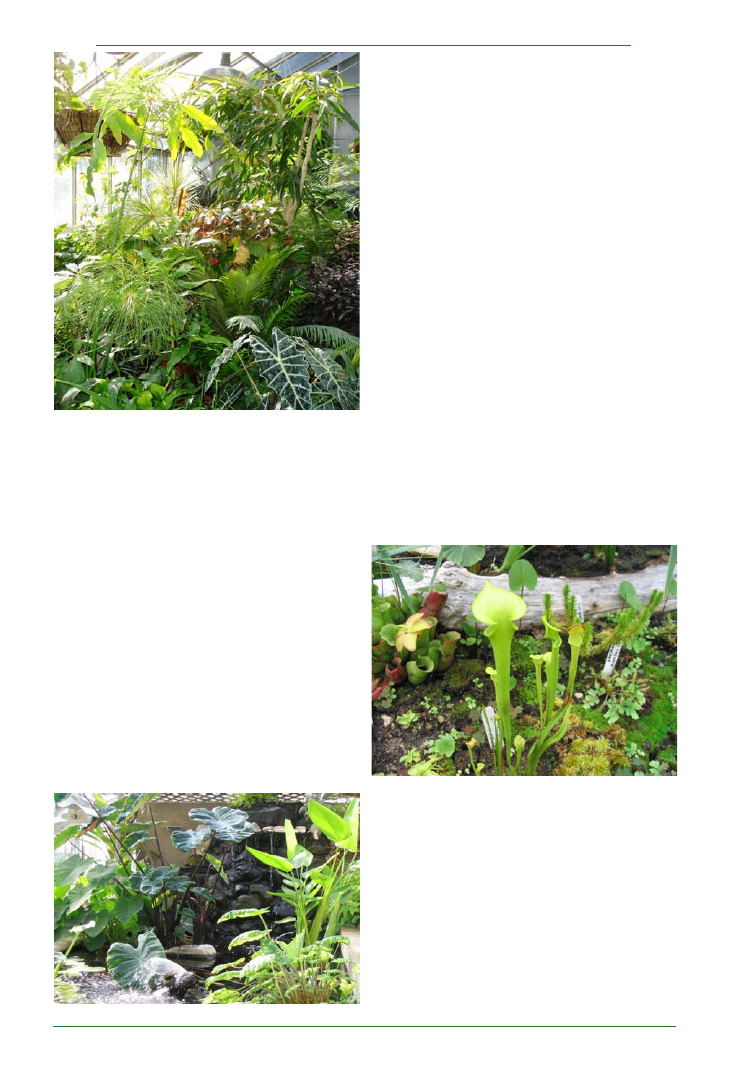
4 0
Plant Science Bulletin 53(2) 2007
Ron and Billie created an Aquatic House to replace
the unused fish tanks. Ron had no special funding
for this project, but the Physical Plant plumbers and
masons volunteered their time (in exchange for
morning coffee and baked goods) and local
businesses donated supplies (including a massive
amount of concrete). The Aquatic Learning Center
opened early in 1999. A large pond and waterfall
featuring a number of aquatic plants, a fine collection
of donated koi and some resident turtles dominate
the room. The projected creek has morphed into a
fern collection used in my plant diversity course. For
me, the highlight of this room is the Sphagnum bog;
easily the largest one in Iowa. Currently we are
watching the Venus fly traps bloom, as well as
Pinguicula and of course many species of Drosera
and Sarracenia.
In 1996 we documented the fact that nearly one
quarter of UNI students (including all 600 Biology
majors) visit or use the greenhouse as part of their
classroom activities. This and the fact that the
“plant” classes make heavy use of the greenhouse
allowed us to reclaim adjacent Physical Plant space
for a classroom. School tours, community classes
and garden club meetings increased the Botanical
Center’s profile. Ron continued to press for a foyer
for tours to gather, a proper botany classroom,
offices with windows and bathrooms that would
meet code, and in 2002 these were all realized as
part of a McCollum Science Hall addition.
Sadly, ill health forced Ron to retire in late 2002. The
new classroom was named in his honor in 2003. In
early 2003 Billie Hemmer took over as greenhouse
manager and Stephanie Witte replaced Billie as
horticulturist. Billie and Stephanie have continued
to focus on increasing the plant collection and have
also added class material to the plantings around
the greenhouse. They work more closely with the
Grounds Department in landscape planning, but
continue to be responsible for managing the campus
Preserves. In addition they have taken on a larger
role in supporting faculty research. As funding for
school tours has been reduced, they have begun to
take the greenhouse to the community by presenting
talks and activities at local area schools.
McCollum Science Hall is again undergoing
renovation, and the Head House, mechanicals,
research lab and greenhouse are included in this
project. When complete, we will truly possess a
Botanical Center, of which the greenhouses will
continue to be the focus. The “parking garage” still
floats around administration minds, but the
greenhouses are no longer considered a viable
site. There is talk of adding a 4
th
floor to McCollum
Science Hall, with new research greenhouses.
Regardless, the UNI Botanical Center and
greenhouses are a wonderful place to visit, full of
enthusiastic, dedicated staff and students, and
combining the ambience of a conservatory with a
high quality plant collection.
Jean Gerrath, Department of Biological Sciences,
University of Northern Iowa.
Orchid House
Pond

4 1
Plant Science Bulletin 53(2) 2007
The Lloyd Library and Museum
Cincinnati, Ohio
Maggie Heran, MLS, Director
(This is a revised version of an article that appeared in the
Council on Botanical and Horticultural Libraries
Newsletter, Number 105, May 2007)
The Lloyd Library and Museum, a privately-funded
independent research library, is consulted and
visited by both the national and international scientific
community as well as the general public. Although
it is a non-circulating, closed stacks collection, the
library serves its clientele through holding,
identifying, acquiring, preserving, and providing
access to its historic and current books and journals,
as well as archival materials, on a wide variety of
disciplines that fall under the broad subject areas
of natural history, botany, pharmacy, and medicine.
The Lloyd’s resources are, in fact, an eclectic blend
of a host of related sciences and their history,
including, but not limited to, chemistry, zoology,
forestry, pharmacognosy, phytomedicine,
ethnobotany, folk and traditional medicine, and
alternative healing practices. In addition, the library
holds materials on gardening, gardening history,
horticulture, agriculture, cosmetics, perfumery,
eclectic and sectarian medicine, and alchemy.
Despite the scientific focus, the collections have
relevance to the humanities, such as visual arts and
foreign languages, through resources that feature
botanical illustrations, original artworks, and travel
and exploration literature. With over 200,000
volumes and nearly 1000 linear feet of archives
(including papers of herbalists, pharmacists,
chemists, pharmacognosists, and materials
related to the founders of the library) the Lloyd
Library’s coverage of the works in its collection
areas continues to be nearly comprehensive.
The library is a product of the endeavors of three
men—John Uri, Nelson Ashley, and Curtis Gates
Lloyd—brothers who were all apprenticed as
pharmacists in the latter half of the 19
th
century.
Tradition holds that the nucleus of the library can be
found in the two books John Uri, the oldest Lloyd
brother, brought with him to Cincinnati in 1864 when
he began his apprenticeship with druggists W. J. M
Gordon and Brother. The books were Edward
Parrish’s 1864 edition of A Treatise on Pharmacy
and George Fownes’ 1864 edition of A Manual of
Elementary Chemistry, Theoretical and Practical.
As Lloyd’s career grew, so too did his book collection.
By 1885, the Lloyds owned their own pharmaceutical
business—Lloyd Brothers, Pharmacists, Inc., where
a portion of their manufacturing facility was dedicated
to the growing library. The Lloyds became avid book
collectors because they wanted the best resources
close to hand (in what we might today call a corporate
library) in order to produce the highest quality Eclectic
medicines, the products in which they specialized.
Eclecticism was one of many healing philosophies
of the 19
th
century opposed to what was then called
Regular Medicine whose practitioners adhered to
a very harsh regimen of purging, bleeding, and
blistering. While Eclecticism is not easily defined,
its therapeutics relied heavily upon medicinal plant
treatments which differed from other botanical
preparations of the era by being more highly
concentrated, using fresh rather than dried
specimens, and emphasizing use of native
American plants rather than the diverse materials
used by other pharmacists.
Young John Uri Lloyd
Fourth home of the Lloyd Library and Museum, 1908-
1969
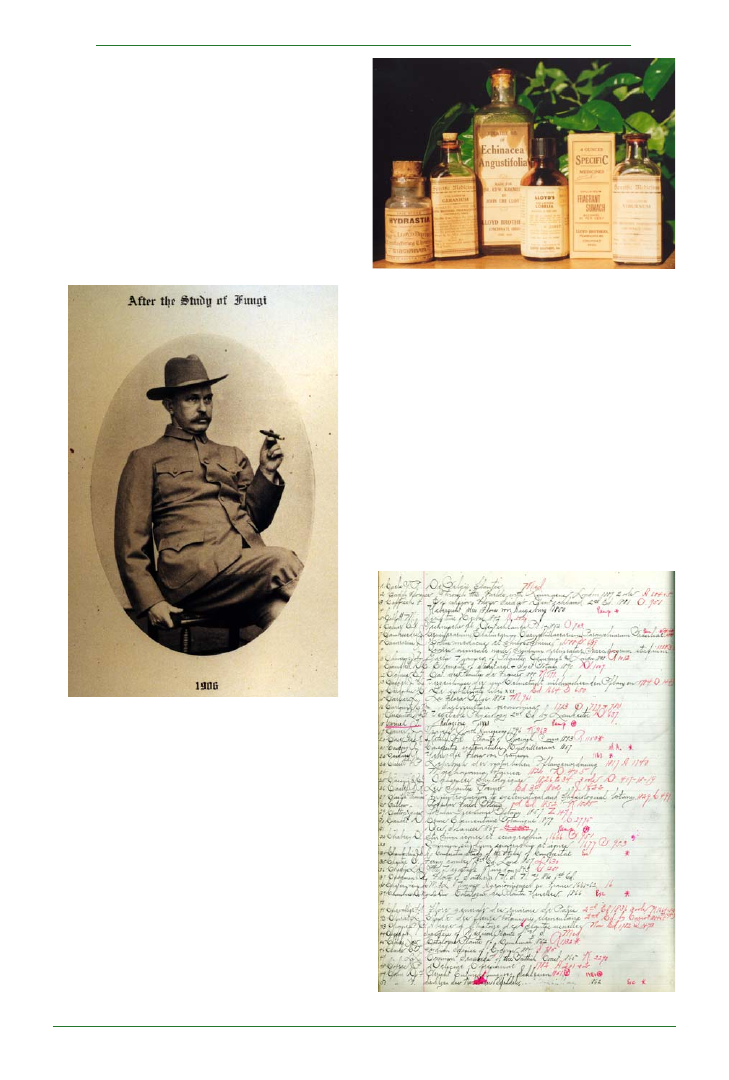
4 2
Plant Science Bulletin 53(2) 2007
By 1901, Lloyds’ research collection outgrew its
space in the manufacturing facility; then, rapidly,
outgrew two other buildings before 1908 when a
new building was erected near the pharmacy. This
structure housed the library for nearly 75 years. It
was 22 by 72 feet, with room initially for over 6200
linear feet of shelving. By the end of its usefulness,
it held some 11,500 linear feet of shelving containing
about 98,000 volumes. The current building,
designed with expansion in mind, was erected in
1970 with four floors and a basement equaling over
30,000 square feet of space.
The museum aspect of the Library was an outgrowth
of the herbarium created by Curtis Gates Lloyd,
who, in addition to being a trained pharmacist,
became a well-known botanist and mycologist.
The herbarium was divided and dispersed after
Curtis’ death, with the botanical specimens
transferred to the University of Cincinnati and the
mycological specimens transferred to the U.S.
Department of Agriculture, where it is now part of the
U. S. National Fungus Collections. Although these
collections are no longer at the Lloyd, the library
maintains its museum aspect by providing access
to historic pharmacy implements, original artwork,
book and art exhibitions, photographs, and artifacts,
such as bottled preparations from Lloyd Brothers,
Pharmacists, Inc.
Curtis Gates Lloyd, Mycologist
Medicine bottles from Lloyd Brothers, Pharmacists, Inc.
The library is indeed one of the Lloyds’ most enduring
legacies. And, as it grew, the Lloyds provided for its
future. In 1898, John Uri Lloyd drew up Articles of
Incorporation to insure the library’s legal standing
and establish its mission “to collect and maintain
a library on botanical, medical, pharmaceutical,
and scientific books and periodicals and works of
allied sciences”; and in 1917, Curtis Gates Lloyd
established the trust under which the library
continues to operate.
The Lloyds’ collected a significant number of
important fundamental resources upon which to
build. They developed “want lists” and made
Page from the Lloyd’s 1893 handwritten book catalog
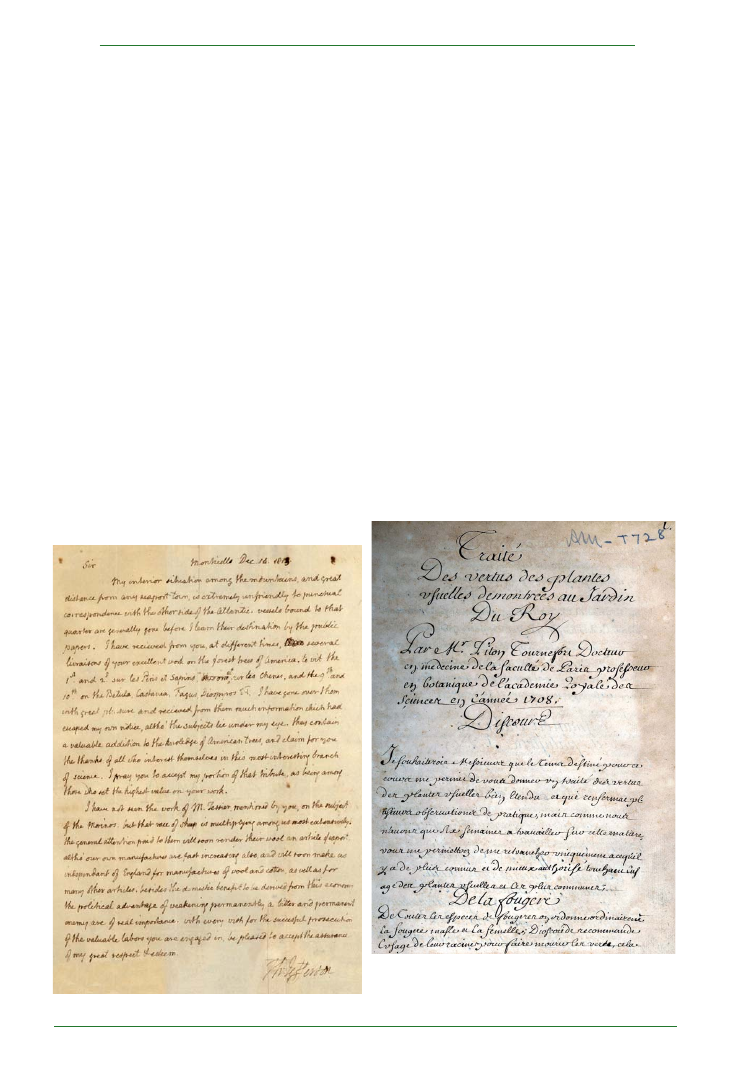
4 3
Plant Science Bulletin 53(2) 2007
.
purchases based on a keen knowledge of the key
literature, both historical and contemporary, in their
subjects of interest. The earliest catalog in the
Lloyd’s archives is handwritten by Curtis and dated
1893. [PHOTO #5] A short list of the titles in the
library at that time demonstrates that they collected
with purpose and expertise: Bigelow’s American
Medical Botany and three editions of his Florula
Bostoniensis; two editions of Benjamin Smith
Barton’s Elements of Botany; several titles and
editions by both Alphonse de Candolle and Augustin
Pyramus de Candolle; Dominique Chabrey’s
Omnium Stirpium Sciagraphia et Icones (a book
once owned and annotated by Jean-Jacques
Rousseau); several titles by Albrecht von Haller;
several titles by both Joseph Dalton Hooker and
William Jackson Hooker; a full page of the catalog
lists titles by Linnaeus; Leonhard Fuchs’ De Historia
Stirpium Commentarii Insignes and Historia
Generale des Plantes; titles by Herman Boerhaave
and Hieronymus Bock; William Woodville’s Medical
Botany; and, one of the original 25 copies of
Sibthorp’s Flora Graeca, for which there is also
evidence that Curtis had this on his “want list” and
was tracking prices at auction houses, such as
Christie’s. The Lloyd will feature books from this
catalog in the exhibition “Seeds of a Great Library:
Selections from Lloyd’s 1893 Book Catalog”
scheduled for June 1 through September 30, 2007.
With such an exemplary foundation, subsequent
librarians ably followed the precedent set and
continued to acquire rare, unique, and important
resources to add to the collection. Among the
hundreds of thousands of books and items acquired
since 1893, a few deserve special mention. The
Lloyd acquired its oldest book in 1937. Commonly
known as Mesue Vulgare, this edition of the
Antidotarium of Mesue was printed in Venice in
1493. It is a list of drugs compiled by an Arabic
physician who wrote the original manuscript
sometime around the 10
th
century. It was the most
popular compendium of drugs in medieval Europe
and is considered the very first important
pharmaceutical work ever printed. In 1927, the
Lloyd purchased the 1857 English edition of
François André Michaux’s North American Sylva
from Paris. Upon examining the book, a letter from
Thomas Jefferson to Michaux was found within its
pages. The letter is dated from Monticello December
14, 1813 and bears the signature of Jefferson. In it,
he praises Michaux’s latest publication on North
American trees and discusses exporting of wool
and cotton. One last unique item worth noting is a
handwritten manuscript by French botanist Joseph
Pitton de Tournefort. Written in 1708, Tournefort
describes the plants in the Jardin du Roi.
Letter from Thomas Jeffereson to Francois Andre
Michaux
Title page from Tournefort’s 1708 handwritten
manuscript describing the plants in the Jardin du Roi

4 4
Plant Science Bulletin 53(2) 2007
Throughout the Lloyd’s collections, one can find
many more examples demonstrating the
significance and uniqueness of its resources.
Today the Lloyd continues to add to these resources
through purchase and donations of both
contemporary and historic materials. Some recent
acquisitions of note include the papers of Dr. George
Rieveschl, Jr., the chemist who developed the well-
known antihistamine Benadryl; several medicinal
recipe manuscript books from apothecaries, both
foreign and domestic, living in the 18
th
and 19
th
centuries; a scarce practical pharmacology
handbook for physicians and surgeons published
in 1783 by Johann Essich; Jean Prevost’s 1666
Hortulus Medicus Selectioribus Remediis; a first
edition (1801) of L’Art du Parfumeur by Jean Louis
Fargeon, Marie-Antoinette’s personal perfumer;
Edward Tuckerman’s 1854 Lichenes Americae
Septentrionalis exsiccati consisting of
approximately 100 plates of mounted specimens;
and, a one-of-a-kind book titled Hemerocallis by a
local book artist.
Hemerocallis, 2003, by book artist carolyn Whitesel
Although the Lloyd does not have a natural
constituency, such as institutionally connected
faculty, students, or researchers, it serves a wide
variety of clients, locally, nationally, and
internationally. From historians and philosophers
of medicine and science to contemporary practicing
herbalists, many rely on the depth of the Lloyd
collection for both scholarly research and practical
applications. Through its rich resources, one is
able to trace the development of phytomedicine
from its earliest beginnings to today’s research on
naturopathic healing, complementary medicine,
and alternative therapies, as well as herbal
preparations and natural products. In addition, its
collections provide one of few places where
researchers can study the integral relationship of
the history of botany and pharmacy through
complementary and contextual materials.
In recent years, the Lloyd has instituted programming
to appeal to all segments of the general public. The
Changing Exhibits program often features works of
botanical illustrations, other visual arts, and on the
history of natural sciences, frequently accompanied
by a related lecture. Through a renovation in 2006,
the library now has space for a small gallery available
for art exhibitions. Several area colleges and
universities bring classes for orientation and special
projects. The library also offers meeting space and
group visits, as well as off-site presentations on the
Lloyd’s history and collections. In addition, the
library now has two children’s programs: Budding
Artists for children ages 6-10; and, Mother Nature’s
Story Time for children ages 3-6. These new
programs, along with increased emphasis on
publicity and advertising, as well as a newly designed
website with enhanced content, are reaching people
in new ways. We invite you to explore the Lloyd and
join those making use of its remarkable resources.
All photos courtesy of the Lloyd Library and Museum,
Cincinnati, Ohio.
For more information about the Lloyd Library and
Museum, please visit our website at
www.lloydlibrary.org
.
LINNAEUS
by Stephen Freer
Carl Linnaeus was born on the 23
rd
May 1707, at the
small hamlet of Råshult in theremote rural province
of Småland in southern Sweden. His father, Nils
Linnaeus, a clergyman, worked as assistant to his
father-in-law, the parish priest of Stenbrohult, whom
he soon succeeded in that living; so it was in the
parsonage of Stenbrohult that Carl’s early years
were spent. The situation was idyllic, with a church
on the shore of a lake, surrounded by meadows full
of wild flowers, and with distant views of mountains
and woods.
From the beginning, Carl loved nature, and had a
special interest in flowers, whether in the fields or
in his parents’ garden, the finest in the
neighbourhood. Nils was an accomplished Latinist
as well as an amateur botanist, and habitually
conversed with his son in Latin; and so Carl learnt
Latin at home as well as Swedish, and was familiar
with all the technical terms used by botanists at that
time. But at school, he did not do well at book-work,
and was regarded as more suitable for manual
work than for training as a pastor; this was a grave

4 5
Plant Science Bulletin 53(2) 2007
disappointment to his parents. Eventually, it was
decided that he should study medicine at Lund, in
the south-western province of Skåne, which had
been part of Denmark until 1658. And, so, in 1727
he entered the university, where he lodged with Dr
Kilian Stobaeus, a physician who possessed a
large library and collections relating to natural history,
including a herbarium.
But the medical course at Lund was not satisfactory,
and in the following year Carl moved to Uppsala in
central Sweden, where he met some of the most
learned men in the country, including Olof Rudbeck
the younger, professor of medicine, and Olof Celsius
the elder, professor of theology and dean of the
cathedral. He was invited to lodge with Celsius, and
so had access to an academic library, as he had at
Lund. Later, he transferred his abode to Rudbeck’s
house, where he acted as tutor to his host’s young
sons. He was appointed demonstrator at the
Uppsala Botanic Garden, and began his career as
a lecturer. Among his fellow-students, his closest
friend was Peter Artedi, a medical student who
shared his interest in natural history, and especially
in the classification of plants and animals. Artedi’s
career was cut short by premature death, but his
influence on the development of Linnaeus’ own
ideas was considerable, especially in the field of
zoology.
At that time, Linnaeus’ interests were by no means
confined to botany. He made a short journey to
Dannemora, where he observed the operation of a
primitive steam-engine in an iron-mine, and
collected mineral specimens; and he went to
Stockholm to see the dissection of a corpse. In
1732, he went on a longer and more adventurous
expedition to Lapland in the extreme north, to study
not only the flora and fauna of the region, but also its
climatical and geographical features, and the habits
and customs of the people, whose life-style differed
so conspicuously from that of most Europeans.
Soon after his return to Uppsala, Carl was invited to
a Christmas holiday with a friend, Claes Sohlberg,
whose home was at the mining town of Falun, and
took the opportunity to visit silver and copper mines,
and to lean about the processes of smelting and
assaying. In 1734, he became informally engaged
to Sara Lisa Moraea, a daughter of Dr Johan
Moraeus, the physician of Falun. Dr Moraeus
insisted that the marriage should not take place
until Linnaeus had more experience, and had
achieved a doctor’s degree, which he had not done
either at Lund or at Uppsala. Accordingly, Linnaeus
decided to travel abroad, and went in the company
of Sohlberg first to Hamburg, and from there to
Amsterdam. In the event, Carl was to remain in the
Netherlands for 3 years, and to become
internationally famous for the works which he
published during his time there.
From Amsterdam, he crossed the Zuiderzee to the
small town of Harderwijk in the Dutch province of
Gelderland, where there was a university which
granted degrees on the strength of a thesis alone,
without requiring the keeping of terms or attendance
at lectures; the whole process took only a few days.
Carl submitted a medical thesis, which he had
written previously, on the cause of intermittent fevers,
and duly obtained a doctor’s degree which would be
recognised elsewhere, and which qualified him to
practise and teach medicine.
After returning to Holland, he settled for a time at
Leiden, where he made the acquaintance of two
very distinguished physicians and botanists,
Herman Boerhaave and Jan Fredrik Gronovius the
younger, and of a younger man, soon to be famous,
Adriaan van Royen, who was in charge of the
university’s botanic garden. Sohlberg had returned
to Sweden, but at about that time, Linnaeus
encountered his old friend Artedi, who had just
returned from England, where he had been making
a special study of ichthyology. Both young men
moved to Amsterdam, where Artedi was employed
by the German-born apothecary, Albert Seba, and
Linnaeus by Jan Burman, the young professor of
botany. Not long afterwards, Artedi was accidentally
drowned in a canal; and Linnaeus was induced to
accept a post with George Clifford, a banker of
English aristocratic descent who was a director of
the Dutch East India Company, and the proprietor
of a country estate called the Hartenkamp, situated
between Leiden and Haarlem. There he was
employed as medical adviser and curator of the
extensive garden and park; and he had the
opportunity to study the strange animals in the
menagerie, and to cultivate exotic plants, including
bananas – the first to be grown successfully in
Europe.
In 1736, Linnaeus made a brief excursion to England,
where he met Sir Hans Sloane, the president of the
Royal Society, and Jacob Dillenius, a botanist of
German origin who was in charge of the Oxford
Botanical Garden.
Linnaeus remained at the Hartenkamp until 1738,
when he returned to Sweden by a devious route
through Paris; there he was entertained by the
Jussieu brothers, and became a corresponding
member of the Academy of Sciences. After a short
stay at Stenborhult, he proceeded to Falun, where
he became formally engaged to Sara Lisa. Since at
this stage he could see no opportunity of earning a
living as a botanist, he established a practise as a
physician in Stockholm; and the wedding was

4 6
Plant Science Bulletin 53(2) 2007
solemnised in 1739; in the following years a son,
Carl Linnaeus junior, and four daughters were
born. But Carl was not happy in his occupation; and
in 1741 he was glad to succeed Lars Roberg as
professor of medicine at Uppsala; there he was to
stay for the remaining 36 years of his life. Later, he
was able to exchange the chair of medicine for that
of botany; the duties included the charge of the
university botanic garden, and at last he had found
a job that was truly satisfying. In addition to his
house in the town, he bought a country property at
the neighbouring village of Hammarby, where he
had his own garden, and kept a menagerie of exotic
animals, including a pet racoon named Sjupp and
a monkey named Grinn.
His early thesis on the sexuality of plants was
dedicated to Rudbeck. The basic idea was not
entirely new, as it had occurred to Vaillant and
others; but Linnaeus developed it, and based his
system of classification on it. This was never
intended as a substitute for a truly natural system,
which would show the actual affinities of the various
genera and species. It was simply one of many
systems, designed as a key to identify the species.
It was adopted with enthusiasm by Erasmus Darwin,
the physician of Lichfield, who celebrated it
somewhat eccentrically in memorable verse; and it
was used extensively by professional and amateur
botanists for many years. It has now been
superseded by classification more in accordance
with nature: in this Linnaeus’ own hopes and
aspirations have been largely realised. The idea of
evolution was quite foreign to him, as he believed
that each species was separately created and
substantially unalterable; but in his awareness of
the close affinity of mankind with apes, he was in a
sense a predecessor of Erasmus’ more famous
grandson, Charles.
Linnaeus recognised Cesalpino as the first true
systematist; he owed much to the influence of Ray;
but it was Tournefort who provided him with the
largest number of generic names. The custom of
describing a genus by a single word was already
firmly established in his time; but species were
often differentiated by long descriptions of 12 or
more words, in which an attempt was made to
include every distinctive feature of the species.
Linnaeus’ great contribution was to limit the specific
name to a single word that adequately distinguished
the species from others of the same genus. Thus
the nomenclature became binominal.
1
Linnaeus’
Philosophia Botanica, which appeared in 1751,
marked a crucial stage in the development of this
method, and the single words, formerly dismissed
as ‘trivial’, became an essential part of the system.
This work had a wide influence with some of the
greatest minds of the 18
th
century, including
Rousseau and Goethe. It was followed two years
later by Species Plantarum, Linnaeus’ crowning
achievement, and the starting point of all modern
classification of plants. Similarly, the tenth edition
(1758) of his Systema Naturae (first published in
1735) is taken as the foundation of zoological
classification.
His principal works are in Latin, the lingua franca of
his time; his style is simple and matter-of-fact, for
the most part free of oratorical extravagance. His
own copies of his books are sometimes annotated
with corrections and additions in his own hand-
writing which is small, but very neat and clearly
legible. He also wrote more popular works in his
native language, such as accounts of journeys to
some of the provinces of Sweden, and the Baltic
islands of Öland and Gotland. In Swedish, he
attained a style of almost poetic simplicity and
beauty.
From his early days as a demonstrator in the
Botanical Garden, Linnaeus’ lectures had always
been very popular, and not only with botanists;
many of the townspeople of Uppsala came to hear
him discourse in Swedish, with a Småland accent;
and later, botanists came from all over Europe to
hear his more formal lectures in Latin. Some of his
published works are clearly based on lecture notes;
and some rhetorical passages immediately remind
us of the intonation and gestures of a demonstrator
rather than the habits of a writer. The same is true
of his meticulous descriptions of minute parts of
plants and animals. The world at large now regards
him primarily as a taxonomist, but in Sweden he is
still remembered as a great teacher. He worked
very closely with his pupils, and organised
expeditions into the countryside and woods, to
study the environment and collect specimens. The
manner of proceeding was carefully regulated, and
the clothes and equipment required were prescribed
in detail.
Here it may be mentioned that Linnaeus was the
inventor of the centigrade thermometer in common
use today. It is generally attributed to Anders Celsius
(a nephew of Olof); but Celsius made zero the
boiling-point of water, and 100 the freezing point. It
was Linnaeus who overturned this somewhat
perverse arrangement.
Linnaeus’ concerns were not purely scientific and
academic; he described the medical and household
uses of the various plants, as well as their physical
characteristics. In his study of exotic vegetables, he
considered the possibility of adapting them, by
selective breeding, to the Swedish climate, thus
helping the economy of a relatively poor country to
be more self-sufficient.

4 7
Plant Science Bulletin 53(2) 2007
Linnaeus’ relations with his colleagues were not
always easy, and in later life he was inclined to be
touchy, and resentful of real or imagined slights. His
rivalry with Nils Rosén, Rudbeck’s successor as
professor of medicine, lasted for many years. He
was sometimes at odds with other botanists, such
as Siegesbeck and Haller. He had great confidence
in his own judgement, and believed that he was
specially chosen by God to explain the mysteries of
the natural world. He had a firm belief in God as
creator and provider, but his works do not show
signs of any explicitly Christian belief.
Eventually, Linnaeus became a figure of national
importance. He enjoyed the patronage of the
influential politician, Count Tessin, and was
presented to the King and Queen; his catalogues
of the royal collections were published in 1754 and
1764. He was a Knight of the Order of the Polar Star,
and in 1761 he was ennobled as Carl von Linné (a
vernacular version of his learned Latin name), and
this is the name by which he is generally known in
Sweden and elsewhere. He never moved far from
his roots at Stenbrohult. In his younger days, he
travelled in Europe, but rejected opportunities to
visit Surinam and South Africa. As professor at
Uppsala, he encouraged his pupils – called
‘apostles’ – to undertake voyages all over the world
in search of specimens, but stayed at home himself.
Though tempted at times to settle permanently in
foreign parts – Holland, Germany, England, France
and even Spain – he was faithful to his own country,
where the experience of observing the onset of the
short but glorious Swedish summer was like no
other in the world. He remained the typical, essential
Swede.
Footnote No 1
The form binominal is preferable to binomial, as it
is more in accordance with the Latin derivation of the
term; and binomial is used by the mathematicians
in a quite different sense.
[Stephen Freer is a Cambridge classicist, who
worked for the Foreign Office at Bletchley Park in the
war, and then for many years for the Historical
Manuscripts Commission in London. He is the
translator of Linnaeus’ Philosophia Botanica (OUP
paperback 2005) and Linnaeus’ Musa Cliffortiana
(IAPT, due out in November 2007)]
www.stephenfreer.co.uk
CITES and the Herbarium Voucher
CITES (the Convention on International Trade in
Endangered Species of Wild Fauna and Flora)
Secretary-General Willem Wijnstekers, from the
international office in Geneva, Switzerland, gave a
plenary session address on the status of CITES
oversight of timber harvesting and lumber export at
the 3
rd
Global Botanic Gardens Congress convened
recently in Wuhan, China1. Regulatory labeling is
required for sustainably harvested plants and
particularly important for tropical timber tree species
that are used in international trade. According to Mr.
Wijnstekers, many tropical tree species are being
logged illegally, entering the world market through
the back door. The most memorable remark he
made in his speech is that we, as gardeners,
should be sure that our tropical wood garden
furniture is sustainably produced. Properly certified
goods should carry a valid CITES-approved label.
We, as green gardeners, should certainly be
considering the impact of all the materials we use.
However, the Secretary-General missed an
opportunity to connect with the audience on an
issue of more immediate concern to botanists and
horticulturists: CITES regulation of the shipping
and exchange of herbarium specimens of CITES-
listed plant species. Seated next to Mr. Wijnstekers
prior to his remarks, I asked “Is there any progress
on changing the regulations that control the status
of herbarium specimens in CITES?” He looked at
me blankly. Having heard many difficult stories and
complaints about how CITES was impeding
legitimate taxonomic research in certain respects,
I mistakenly presumed that this subject was already
under review. Surely if CITES, as the regulations are
written today, actually reduces serious scientific
study of the very plants it is intended to protect, one
would want to find ways to remedy this situation.
After a moment of thought, Mr. Wijnstekers said,
“There is no need. The current regulations and
permits are suitable for all situations.”
Again, this answer didn’t match the anecdotal
evidence I have heard as to the bureaucratic
difficulties encountered by many scientists,
particularly those working with orchids. This entire
plant family is protected by the CITES umbrella and
requires specific CITES documentation for
herbarium specimen exchange. Specimen transfer
with Certificate of Scientific Exchange (COSE)
permits is restricted to only those research institutes
with CITES registration. It was this, in part, which led
to such serious legal problems as those
experienced at Marie Selby Botanical Garden2.

4 8
Plant Science Bulletin 53(2) 2007
The next evening, after asking for more input from
various colleagues, I had the opportunity, again, to
ask Secretary-General Wijnstekers about transfer
of herbarium vouchers, he repeated, “Just get a
permit.”
Is Mr. Wijnstekers’ answer an oversimplification?
Or is the concern about the bureaucratic red tape
and potential liability (personal, professional and
institutional) really changing the direction of
taxonomic work in favor of plant groups that fall
outside of the jurisdiction of CITES? In other words,
is CITES impeding the study of the very plant taxa
that it was designed to protect?
The movement of herbarium materials from one
country to another is controlled by several layers of
governance and CITES constitutes only one of the
considerations in pursuing the legal transport of
endangered plant parts or products. Current CITES
regulations prohibit the movement of listed plants
(living or dead) into or out of the countries where they
occur without a CITES permit, even though they may
have been collected legally, with the full cooperation
and approval of the local government. The differing
laws or requirements of individual countries and
their scientific institutions are not being considered
in this dialogue, nor are the issues about the
transport of living plant material or for genetic property
rights and DNA. These elements further complicate
any movement of herbarium specimens. The CITES
permitting process, which seems to be simple in
theory, has often proved to be very difficult in practice.
In a prime example today, many orchid species
which face extinction and are desperately in need of
taxonomic study, cataloguing and conservation, go
unstudied because the hands of botanists all over
the world are tied with red tape.
Peter Wyse Jackson3, former Secretary General of
BGCI and author of the BGCI handbook on CITES
regulations for botanical gardens4, contributed his
thoughts on this matter. He indicated that botanical
institutions are taking one of three routes: trading
CITES-documented vouchers when possible,
trading vouchers with no documents quietly behind
the scenes or making no exchanges at all. Simply
put, many institutions are breaking the law to study
certain plants or they have stopped research on
CITES-listed plants entirely.
David Roberts5, at the Orchid Herbarium of the
Royal Botanic Gardens, Kew and ecological
statistician Andrew Solow, Director of the Marine
Policy Center at the Woods Hole Oceanographic
Institution are collaborating on statistical studies to
identify the impact of CITES on botanical research.
Based on a sample of the numbers of herbarium
specimens of orchids (CITES listed) and
bromeliads (a comparable group of mainly epiphytic
plants which are not CITES regulated) collected in
Brazil and Costa Rica, they have compared the
relative collecting rates of each family. While the
number of new herbarium specimens of
bromeliads has increased, the number of new
collections of orchids has decreased. They have
calculated that the rate of collecting orchids for
scientific study is significantly lower than it would
have been if CITES had not come into force in
1975. This analysis supports the notion that the
scientific study of some plant groups is being
seriously impaired by the existence of CITES.
The work of Roberts and Solow may indicate that
botanists have moved their research focus to plant
groups other than orchids, essentially taking the
path of least regulatory resistance. Peter
Jørgensen6, at the Missouri Botanical Garden,
states clearly “Nobody wants to touch the organisms
in the appendices; they have become taboo, which
means that we have also lost any means of
monitoring these large plants groups with many
apparently endemic species.” Current orchid
taxonomic work now relies on older specimens
collected prior to the establishment of CITES.
In support of this theory, Flora of China contributor
Mark Watson7, on the staff of the Royal Botanic
Garden in Edinburgh, Scotland, commented about
orchid species in China and Nepal in that “we just
don’t collect them or if we do, we don’t take them
home.” He continued by describing the monumental
difficulties in getting CITES permits in Nepal and
attributed it to the unstable political situation. Watson
indicated that if orchids are collected, the specimens
are deposited with botanical institutions within the
country of origin. When permits for the transport of
herbarium specimens are not obtainable, the
scientist must go to this country, making research
very costly and time-consuming. Many botanical
institutions lack the financial resources to use this
avenue of study and it is much more expensive than
simply mailing a set of vouchers.
At a breakout session later in the Wuhan Congress,
with Mr. Wijnstekers in the audience, several
scientists raised the issue of CITES impediments
to research more directly. A draft resolution8
recommending the exemption of orchid herbarium
specimens from CITES regulation was read by
Gloria Siu Lai Ping, the Senior Conservation Officer
at Kadoorie Farm and Botanic Garden in Hong
Kong. She is a member of the Orchid Specialists
Group (OSG) of the Species Survival Commission
of IUCN, the World Conservation Union. The
resolution was drafted during the III International

4 9
Plant Science Bulletin 53(2) 2007
Orchid Conservation Congress held in March 2007
in San José, Costa Rica. One of the major items on
the agenda of this conference was to analyze all the
factors threatening orchid populations. Other
botanists at Wuhan, including Irawati9, of the Bogor
Botanic Garden, Indonesia, also voiced concerns
about the negative effects of CITES regulation on
legitimate botanical research. Mr. Wijnstekers heard
them all. If this issue was not on the horizon before
the Wuhan Congress, it must be now.
According to Secretary General Wijnstekers10, more
than 170 participating countries are CITES
signatories and these countries must register their
individual scientific institutions (SIs) with CITES.
After registration, the SIs have the authority to issue
labels for herbarium specimen export.11 The COSE
permit is restricted to exchanges only between two
such registered scientific authorities. Notably, what
Mr. Wijnstekers failed to mention is that only one-
third of these countries12 actually have CITES-
registered scientific institutions. Most of these SIs
are focused on sciences other than botany.
In cases where a country has no registered scientific
institution, all CITES permits are processed through
that country’s Ministry of Environment or other similar
department designated as the CITES Managing
Authority. This elevated level of review results in a
very tangled, slow, political, difficult and frequently
unsuccessful and expensive permit process. Unlike
peer-to-peer communication between SIs, the
control of permits has been passed to bureaucrats
with little or no technical understanding as to the
significance of taxonomic study in understanding
global biodiversity. Botanists are now being reviewed
by regulators skeptically, in the same bad light as
pharmaceutical companies known for exploiting
genetic patrimony and live plant collectors who are
notorious for flaunting the laws.
Voicing other concerns about CITES impacts on
botanical research, Paul Kessler13, Prefect of the
University of Leiden, has commented that the
paperwork and expense for CITES compliance can
be considerable. While the process varies by country,
the Netherlands rules allow only five specimens
per form. If 100 specimens are shipped, it requires
twenty forms, each with an attached processing fee
and the cumulative cost can be substantial. About
his work on Asian tropical trees, Kessler no longer
collects CITES-listed plants because of the
headaches of permit procurement. He strongly
stated, “greedy plant collectors for living collections
are spoiling it for the rest of us. The point is
identification because the loss rate of orchid species
to extinction each year is huge. We do not even know
what we are losing.”
Kessler’s students, working in South East Asia,
have also run into permit difficulties with their field
research in plot studies. They survey precisely
measured areas and collect every plant species in
the quadrant. They don’t know what will be there
until the survey is done, yet they are required to list
all plants, to species level, to be collected prior to
commencement of the field work.14 It is an
impossible task.
Nicely summing it all up, Tim Entwisle15, Executive
Director of Botanic Gardens Trust Sydney said,
“While Australian botanic gardens are strong
supporters of the regulation of plant trade to protect
the rights of local communities and to preserve rare
and threatened flora, we also understand the great
importance of scientific research. Reasonable
access to herbarium specimens from around the
world is critical to good science, and good science
is critical to good conservation. If CITES cannot help
herbaria, then they are not doing their job properly!”
Finally, I would question, “are researchers running
into real roadblocks that reduce their effectiveness
in studying critically-endangered plant species?”
What are some of the actual field experiences of
those of you who are working on CITES-listed
plants? Is the difficulty of obtaining permits
burdensome enough to cause you to change your
research direction (or is this just idle chatter)? What
do you know about the situation of others working
on CITES protected plant species? I would welcome
your comments.
If you have had or know of any research experiences
in this area, please let me know. If you think the
importance of this subject is being overemphasized,
comments to that effect would also be helpful.
Pat Duncan Raven, Ph.D.
pat.raven@mobot.org
(Endnotes)
1 3GBGC was convened by Botanic Gardens
Conservation International (BGCI), April 16-20, 2007
2 Marie Selby Botanical Garden and individual
members of the garden’s administrative staff were
charged with CITES violations after handling
Appendix I orchid specimens brought to them by a
collector. In addition to accepting plants with flawed
import permits, Selby was cited for returning an
herbarium specimen made from this orchid to the
University of San Marcos, in Peru. While Peru was
the country of origin, the Peruvian university does
not have CITES registration and could not repatriate
the specimen according to current CITES

5 0
Plant Science Bulletin 53(2) 2007
regulations. In fact, there is no CITES registered
scientific institution in Peru. This element is only
one part of a much more complex legal situation
and is included here only for illustrative purposes.
3 3GBGC conference participant
4 A Review of International Conventions which
Affect the Work of Botanical Gardens, BGCNews,
Vol.3 No.2, 1999. This article is based on a
presentation by Peter Wise Jackson and may be
viewed at http://www.bgci.org/worldwide/article/
0176/
5 David L. Roberts and A.R. Solow, unpublished
6 Personal communication
7 3GBGC conference participant
8 The resolution from the III International Orchid
Conservation Congress (March, 2007): “The Orchid
Specialist Group of the Species Survival
Commission notes that the inclusion under CITES
of dried herbarium specimens, flowers fixed in
spirit and silica-gel dried tissues of orchids for
research purposes is seriously impeding the
gathering of information such as plant identification
and genetic variability that is fundamental to the
conservation of the orchid species in question. The
Orchid Specialist Group would wholeheartedly
support the removal of these types of material from
CITES control.”
9 3GBGC conference participant
10 Personal communication
11 CITES, 1979 amended, Article VII – Section 6.
The provisions of Articles III, IV and V shall not apply
to the non-commercial loan, donation or exchange
between scientists or scientific institutions
registered by a Management Authority of their State,
of herbarium specimens, other preserved, dried or
embedded museum specimens, and live plant
materials which carry a label issued or approved by
a Management Authority.
12 Fifty-seven countries out of 171 countries listed.
The register of the scientific institutions entitled to
the CITES exemption provided by Article VII,
paragraph 6, of the Convention may be found at a
link from http://www.cites.org/common/reg/si/e-si-
beg.shtml. The absence of a reference to any Party
means that it has not registered any scientific
institution with the Secretariat
13 Personal communication
14 This is probably due to the particular laws of each
host country rather than CITES requirements. For
example, Andean countries are governed by both
CITES and the more complicated laws of the
Acuerdo de Cartagena.
15 3GBGC conference participant
The Last of the Virgin Sod
We broke today on the homestead
The last of the virgin sod,
And a hounting feeling oppressed me
THat we’d marred a work of God.
A fragrance rose from the furrow,
A fragrance both fresh and old:
It was fresh with the dew of morning,
Yet aged with time untold.
The creak of leather and clevis,
The rip of the coulter blade,
And we wreck what God with the labor
Of a million years had made.
I thought, while laying the last land,
Of the jungles, glaciers and oceans
Which had helped to make these plains
Of monsters, horrid and fearful,
WHich reigned in the land we plow,
And it seemed to me so presumptuous
Of man to claim it now.
So when, today on the homestead,
We finished the virgin sod,
Is it strange I almost regretted
To have marred that work of God.
-Rudolph Ruste

5 1
Plant Science Bulletin 53(2) 2007
BSA Contact Information
All inquiries for the BSA Business Office should
be directed to:
Executive Director: William Dahl and / or
Administrative Coordinator: Wanda Lovan
BSA Business Office
Botanical Society of America, Inc.
4474 Castleman Avenue
P.O. Box 299
St. Louis, MO 63166-0299
Voice: 314-577-9566
FAX: 314-577-9515
E-mail:
bsa-manager@botany.org
Office hours are 7:30 am to 4:30 pm Central
Time
http://botany.org/
President: Christopher H. Haufler
E-mail:
vulgare@ku.edu
All inquiries about the Botany 2004 meeting (and
any other future meeting) should be directed to:
Mrs. Johanne Stogran, Meetings Manager.
Email:
johanne@botany.org
or
meetings@botany.org
Voice: 614-292-3519 Fax: 614-247-6444
http://www.botanyconference.org/
News from the Society
Note from the Office
The Botany 2007 Conference is fast approaching.
This is an important time for your BSA staff team, as
we have the opportunity for direct person-to-person
contact with you, the Society members. If you have
ideas on how we might improve services, outreach
programs or the promotion of botany in general,
please take some time to talk with us. We want to
hear what you have to say.
Communications:
Over the past few years the Society has done a great
deal to ensure you are up-to-date with BSA issues.
We have moved more and more of its
communications online via the BSA website at
botany.org
. We also use email in place of
printed mail wherever possible. We send important
items out via US Post to those without email to make
sure everyone receives what they need. In the main,
this seems to be a very efficient way to communicate.
As a backup system, we place all communications
on the BSA web site at
botany.org/news/
. You
will find a link on that page to the BSA & Sectional
Newsletters & e-Mails, Announcements and Botany
in the News.
If you are not receiving emails from me,
wdahl@botany.org
, please let me know and we’ll
see if we can find out why not and fix the problem.
We suggest you let your systems administrator
know you’d like communications from the BSA, and
place my email on your institution’s “white list.”
Jobs, Post-docs Opportunities, Internships and
Announcements
By the time this issues gets to you, the BSA web site
will be updated to better receive and display all job/
post-doc and intern opportunities. We will also have
an updated announcement system, including both
national and international plant conference updates.
Please look to the BSA web site for details. We look
forward to serving you with these new features.
BSA Web Site Committee
I’m sure you’ve noticed a few changes on the BSA
website over the past year. Thank you to the members
of the Web Committee and the staff who have made
this possible. The site will continue to evolve as a
means of serving the Society’s mission. We look at
three things when making changes to the BSA
website - #1 service for BSA members, #2
educational value, and #3 promoting botany to the
general public. We’d love to hear your ideas on how
we might improve in all three areas. The Web
Student Research in Plant Biology
and Conservation
http://chicagobotanic.org/school/symposia_SRPBC
The Chicago Botanic Garden is pleased to host the
first ever Plant Biology and Conservation Symposium
especially for graduate and undergraduate students
and postdocs. We are accepting abstracts for either
posters or 15-minute oral presentations.
Registration is open to anyone interested in plant
biology and conservation and related areas. For
program updates and abstract submission
guidelines,
http://chicagobotanic.org/school/
symposia_SRPBC_guidelines.php
please call Beth
Pinargote, Symposium Coordinator, at 847-835-
8278.
The deadline for receipt of abstracts is MAY 15,
2007. Authors will be notified in late May regarding
acceptance of their poster.
Friday, July 6, 2007
Prior to the Annual Meeting

5 2
Plant Science Bulletin 53(2) 2007
BSA Awards
Karling Award
Pamela Steele, University of Texas at Austin –
Advisor, Robert K. Jansen, Systematics and
Biogeography of the Neotropical Genus Psiguria
(Cucurbitaceae).
BSA Graduate Student Research Awards:
Natalie Feliciano, University of Massachusetts,
Amherst - Advisor, Jill S. Miller, Isolation of the
Pollen SLF Self-Incompatibility Gene in Lycium
Laura Burkle, Dartmouth College - Advisor, Dr.
Rebecca E. Irwin , The Effects of Nitrogen on Plant-
Pollinator Mutualisms
Rob Baker, University of Colorado, Boulder - Advisor,
Dr. Pamela Diggle, The Microevolution of Plant
Architectural Development: Cloning and
Sequencing Monkeyflower Branching Genes
Valerie Soza, University of Washington - Advisor,
Richard Olmstead, Molecular Systematics and
Evolution of Breeding Systems in Galium
(Rubiaceae)
Gilberto Ocampo, Rancho Santa Ana Botanic
Garden, Claremont CA - Advisor, J. Travis Columbus,
“Systematics of Portulaca L. (Portulacaceae),
including its position within the higher
Caryophyllales”
Patricia Ryberg, University of Kansas - Advisor,
Edith L. Taylor, Permineralized Glossopteris ovules
and ovulate organs from the Permian of Antarctica
and Australia
Tracy Misiewicz, Northwestern University - Advisor,
Nyree Zerega, Investigating the Evolutionary History
and Pollination Biology of the genus Dorstenia
(Moraceae)
Janelle Burke, Cornell University - Advisor, Melissa
Luckow , The systematics of the Neotropical genus
Antigonon (Polygonaceae) and its application to
the study of invasiveness in Antigonon leptopus
Cheng-Chiang Wu, Harvard University - Dr. Elena
M. Kramer, Gene Duplication and Functional
Evolution of Floral Homeotic Genes in Eudicots
Young Botanist of the Year Awards
Kathryn J. Antony , Barnard College, Columbia
University, New York, NY – Advisor, Hilary Callahan
Erica A. Fishel , University of Kansas, Lawrence, KS
– Advisor, Helen Alexander
George Hickman, Eastern Illinois University,
Committee will meet on Sunday morning, July 8
th
,
9:30 am, in Chicago. If you’d like to become involved,
check the meeting schedule for more details.
BSA Membership Committee
Being a member of the Botanical Society of America
is a great idea! Membership is at the highest level
in many years. More importantly, student
participation has never been higher! Thanks go out
to the Membership Committee for some innovative
ideas. I’m sure you’ll see more from this group as
the year progresses. Thank you also to others who
have put forward ideas in this area - they are
working. The Membership Committee will meet on
Sunday morning, July 8
th
, 11:00 am, in Chicago. If
you’d like to become involved, check the meeting
schedule for more details.
BSA Education & Outreach Committee
Thank you to the Education Committee for your
efforts over the past year. I’d also like to extend a big
thank you to the PlantingScience committee, and
the scientists who have acted as mentors for the
program. I can’t tell you enough how important this
one venture has been in establishing the BSA as a
scientific society with a significant and innovative
outreach initiative. The Education Committee will
meet on Sunday morning, July 8
th
, 10:30 am, in
Chicago. If you’d like to become involved, check the
meeting schedule for more details.
There will be other committee and topical meetings
during the conference. We will let you know about
these via email. If you are interested, please get
involved. Working together, we are making a
difference!
PlantingScience
I encourage you all to take a look at the developing
outreach program PlantingScience
(
www.PlantingScience.org
). It behooves us all to
take educational outreach that directly links the
development of research skills to the joys of doing
science. Thank you to the Advisory Committee and
the BSA Educational Director, Claire Hemingway
for keeping this program moving forward!
We’d love to have you, your labs and your students
participate in the program. We are currently exploring
ways to use Planting Science as a means of
enhancing your “Broader Impact” requirements in
NSF grants. If you are retired and would like to
become involved… please contact me to discuss
how this might work. Please take the time to look at
the site and consider how you might become
involved.
Thank you for your time!
Bill Dahl
BSA Executive Director

5 3
Plant Science Bulletin 53(2) 2007
Charleston, IL - Advisor, Janice M. Coons
Kelli Johnson , Ohio University, Athens, OH – Advisor,
Gar W. Rothwell
Nathan Jud , Ohio University, Athens, OH – Advisor,
Gar W. Rothwell
Elizabeth Kolar , Salisbury University, Salisbury, MD
– Advisor, Kimberly Hunter
Katherine LaJeunesse, Miami University, Oxford,
OH – Advisor, Martin H. Stevens
Jessica Lawrence, University of Cincinnati,
Cincinnati, OH, - Advisor, Guy N. Cameron
Elizabeth Levenda, Eastern Illinois University,
Charleston, IL - Advisor, Nancy Coutant
Meredith Mertz , Truman State University, Kirksville,
MO - Advisor, Jeffrey M. Osborn
Kyle Meyer, University of Wisconsin, Milwaukee, WI
– Advisor, Sara Hoot
T. Ryan O’Leary, University of Kansas, Lawrence,
KS – Advisor, Mark Mort
Sarah Owens, Miami University, Oxford, OH –
Advisor, Richard C. Moore
Richard Tate, Humboldt State University, Arcata, CA
– Advisor, Alexandru M.F. Tomescu
Emily R. Treadaway, James Madison University,
Harrisonburg, VA - Advisor, Conley K. McMullen
Michael Shane Woolf , James Madison University,
Harrisonburg, VA - Advisor, Conley K. McMullen
Vernon I. Cheadle Awards
Madelaine Bartlett, University of California, Berkeley
Patricia Ryberg, University of Kansas
Julia Nowak, University of Guelph
John Snider, University of Central Arkansas
Developmental & Structural Student Travel
Awards
Tatiana Arias, University of Tennessee
Natalia Pabon Mora, CUNY/New York Botanical
Garden
Maria Aurineide Rodrigues, Universidade de Sao
Paulo
Yannick Staedler, University of Zurich
Renate Wuersig, Purdue University
Mycological Section Student Travel Awards
Sarah Carrino-Kyker, Case Western Reserve
University, Advisor - Andrew Swanson
Dear Fellow BSA Members
I bring you greetings on behalf of the Executive
Committee of the BSA and will take this opportunity
to update you about ongoing activities and future
goals of your society. The note can be found on the
BSA web site at
https://botany.org/news/newsletters/
President070430.php.
Plans for the Annual Meeting in Chicago are very
exciting. With nearly 1000 abstracts submitted, this
year’s meeting is proving to be even larger than the
one held in Chico, CA last year (that year there were
838, which was a record number). Our Plenary
Speaker will be Judge John E. Jones, who presided
over the trial in Dover, Pennsylvania and whose
legal decision was a model of clear presentation in
support of science and evolution, and a stunning
defeat for intelligent design. I know Program Director
Karen Renzaglia and the BSA staff are working hard
to make sure that our meeting will proceed smoothly
and all participants will benefit from and enjoy the
meeting. I look forward to seeing you all there in July!
The BSA is making progress on many fronts. Our
membership numbers have increased
considerably, with a strong surge in student
members, and we are approaching 2700 members,
up from about 2300 only two years ago. The BSA
endowment has crested $3.5 million and has
contributed more than $225,000 to BSA activities
over the past four years. Interest in our web site
continues to be strong, with about 200,000 visits
each month. The American Journal of Botany has a
healthy impact factor in excess of 2.4, and, guided
by Editor-in-Chief Judy Jernstedt, Electronic Editor
Scott Russell, Managing Editor Amy McPherson,
and Production Editor Beth E. Hazen, continues to
be one of the more widely cited outlets for publishing
papers on plant biology. Your society is thriving and
working for you on behalf of botany worldwide.
The Botanical Society of America has accomplished
most of its current strategic plan. In August 2001, a
strategic planning session (cleverly named “Deep
Thought”) established a set of objectives for the
BSA. The major goals included: (1) hiring an Executive
Director and a staff to manage membership services
and enhance the public image of the BSA, (2)
spearheading educational outreach, (3) building
coalitions with other professional organizations,
(4) expanding our international activities, (5)
recruiting future botanists, and (6) raising
endowment funds.
Since that session (as reviewed above) a green
glow of success has risen over the BSA image, the
trajectory of our membership, and our endowment
funding. These outcomes have been made possible

5 4
Plant Science Bulletin 53(2) 2007
in large part because of changes that were initiated
following the 2001 planning session. In 2002, Bill
Dahl was hired as our Executive Director, and we
now have a fully operational office that includes a
technology manager (Rob Brandt), an administrative
coordinator (Wanda Lovan), and an education
director (Claire Hemmingway). With this staff, the
BSA has been able to make advances that both
streamline our operations and expand our outreach.
For example, most of our business functions are
online and our use of paper has dropped
dramatically. Electronic membership renewal rose
from 30% in 2003 to more than 85% in 2007, and our
response times to inquiries are extremely fast
relative to peer organizations. In the realm of
education outreach, PlantingScience has taken
plants and plant biologists into 19 schools, 26
classrooms, and involved over 1500 students in
plant experiments. PlantingScience sessions
average three weeks – expanding science
experiences for students whose experiments
normally last one class period or less. Botanists
donate approximately 1.5 hours per session, twice
a year, to create an incredibly wide reaching and
high impact outreach program. We have maintained
and deepened our relationships with other
organizations. The American Fern Society, The
American Society of Plant Taxonomists, The
American Bryological and Lichenological Society,
and The American Institute of Biological Sciences
have long and valued histories with the BSA, and we
have broadened our association with the
international community of botanists, as well as
with Mycologists and Phycologists. This year’s
annual meeting is being held in conjunction with the
American Society of Plant Biologists, next year we’ll
be meeting with the Canadian Botanical Association/
Association Botanique du Canada,
and in 2009, we’ll be meeting with the Mycological
Society of America. In addition, we are reaching out
to provide membership and other services to
societies including the American Fern Society and
the Society for Economic Botany.
We are embarking on a new strategic planning
process. Building on the “deep thought” plan that
has been driving our activities over the past five
years, we seek input from the membership as we
move the BSA into the future. The past five years
have established a strong foundation on which to
build, and opened many new doors for the coming
years. We need your guidance as we make
recommendations for the BSA to propel our activities
and agendas.
• What do you think should be some of the goals for
the BSA in the next 5-10 years?
• What emerging issues, opportunities, or
responsibilities should the BSA address?
• How should the BSA manage its endowment to
best advantage for the future of botany?
• Are there ways that the BSA should become
involved in political agendas, educational initiatives,
and emerging research opportunities?
We value your perspectives and opinions and seek
your guidance as we generate a forward-thinking
plan that will carry the mission of the BSA forward.
Please send any ideas you have to me, to other
members of the Executive Committee (listed below),
or to members of the BSA Council. Soon we will
form a Strategic Planning Committee and charge
it with the challenge of developing a document that
will help us become an even more effective voice for
research and education about plants. We
encourage you to become partners in crafting the
future of the BSA.
Sincerely,
Christopher Haufler
President
Members of the Executive Committee include:
President, Christopher H. Haufler
E-mail:
vulgare@ku.edu
President Elect, Pamela Soltis
E-mail:
psoltis@flmnh.ufl.edu
Past President, Edward L. Schneider
E-mail:
eschneider@sbbg.org
Secretary, Stephen G. Weller
E-mail:
sgweller@uci.edu
Treasurer, Kent Holsinger
E-mail:
kent@darwin.eeb.uconn.edu
Program Director, Karen S. Renzaglia
E-mail:
renzaglia@plant.siu.edu
Council Representative, Pamela K. Diggle
E-Mail:
Pamela.Diggle@colorado.edu
Graduate Student, Mackenzie Taylor
E-Mail:
mtaylo37@utk.edu
Botanical Society of America
4475 Castleman Avenue
St. Louis, MO 63110
Mission: The Botanical Society of America exists to
promote botany, the field of basic science dealing with the
study and inquiry into the form, function, development,
diversity, reproduction, evolution, and uses of plants and
their interactions within the biosphere.
The objectives of The Society are to: sustain and provide
improved formal and informal education about plants;
encourage basic plant research; provide expertise,
direction, and position statements concerning plants and
ecosystems; and foster communication within the
professional botanical community, and between botanists
and the rest of humankind through publications, meetings,
and committees.

5 5
Plant Science Bulletin 53(2) 2007
BSA Science Education
News and Notes
BSA Science Education News and Notes is a
quarterly update about the BSA’s education efforts
and the broader education scene. We invite you to
submit news items or ideas for future features.
Contact: Claire Hemingway, BSA Education
Director, at
chemingway@botany.org
or Marshall
Sundberg, PSB Editor, at
psb@botany.org
.
PlantingScience —BSA-led student research and
science mentoring program
Another exciting session recently wrapped up in the
PlantingScience program. The spring session
included a case study of Carol Packard’s classroom
at Sisters Middle School, as well as a pilot of inter-
collegiate peer-mentoring between Emporia State
University and Nazareth College. We are looking
forward to learning how to better serve learners at
various levels in the program.
As always, we thank you for contributing to education
reform efforts. The teachers participating in
PlantingScience greatly appreciate your efforts too.
Below is a note of thanks that we recently received:
I must tell you that this is one of the [best] projects
I have ever done with my students. They are really
taking to the experience and have gained valuable
insight into germination. The best part for me is the
contact that they have with their mentors and the
excellent advice they received. It seems to have
much more merit when it comes from someone
other than the teacher all of the time. I have enjoyed
letting my students freely explore how science
works and even if they learn very little about plants,
the experience of understanding how a real scientist
would approach an experiment has been invaluable.
I want to thank you and all of the mentors for a
wonderful project and very useful and well organized
website. I hope you will allow us the opportunity
again.
Sincerely,
Todd Johnson, George Washington High School,
Chicago, IL
Check out the following websites that have
recently profiled PlantingScience:
Coalition on the Public Understanding of Science
(COPUS)
http://www.ucmp.berkeley.edu/COPUS/index.php
Kid’s Garden News of the National Garden
Association
h t t p : / / w w w . k i d s g a r d e n i n g . c o m /
2007.kids.garden.news/current.html - res
Spotlight on BSA Member Contributions to
Science Education
And the BSA Education Booth Exhibit Competition
Winner is…
Bruce K. Kirchoff, Associate Professor of Biology
Department of Biology at University of North Carolina
Greensboro
The Botanical Society of America is pleased to
announce Bruce Kirchoff won the 2007 BSA
Education Booth Exhibit Competition Award. During
the upcoming Botany and Plant Biology 2007
meetings, be sure to visit the Education Booth in the
Exhibit Hall. Bruce and winners of the ASPB Booth
Competition will showcase their education and
outreach activities. We are delighted to support
Bruce’s highly innovative Image Quiz, an active
visual learning approach to plant identification.
“Programs in the Image Quiz family are designed
to rapidly and efficiently help users become visual
experts. Unlike novices, visual experts are able to
quickly recognize patterns. This allows chess
masters to recognize meaningful chess
configurations, and plant systematists to identify
plants from a glimpse out the window of a moving
vehicle. The Image Quiz programs help users
achieve this mastery in a fraction of the time that is
normally required. They do this by adapting learning
techniques from areas of cognitive psychology
concerned with expertise. The programs are
designed to promote holistic processing, the visual
processing mode used by experts. They do so
through a series of active learning activities. Active
learning engages brain areas associated with visual
expertise, while passive learning does not. The
training techniques are based on research
protocols that were used to define holistic
processing. Image Quiz adapts these protocols to
a variety of visual domains.”
The central program is Woody Plants of the
Southeast: A Field Course on the Computer. It will
be published this summer by Missouri Botanical
Garden Press. Prototypes of the following programs
will also be available on demonstration computers
at the Education Booth: Amino – A program to teach
chemical intuition through the three dimensional
structure of the amino acids; WholeMath – A visual
introduction to mathematical equations and graphs.
This program is intended to supplement high school
algebra; Ovary – An application I use to teach ovary
anatomy to students entering my laboratory; Lupinus
– A research application that uses the same display
engine as Woody Plants of the Southeast. It is being
developed in collaboration with Dr. Ellen Simms
(UC Berkeley) as a means of character discovery in
Lupinus seed coats.

5 6
Plant Science Bulletin 53(2) 2007
At the Education Booth, you will have informal
opportunities to try Image Quiz and talk with Bruce
about it. Bruce will also offer a Sunday morning
workshop on Image Quiz for lucky 25 registrants.
Learn more about Image Quiz at http://
www.uncg.edu/~kirchoff/
Science Education Bits and Bobs
Faculty salaries decrease 1% in 2005-2006—
Faculty salaries failed to keep pace with inflation for
the third straight year, according to the 2007 NEA
Higher Education Almanac and summarized in
Advocate. Data in this review of full-time faculty
salary and benefits across the nation’s colleges
and universities are taken from the National Center
for Education Statistics at the US Department of
Education. Delving into the detailed salary
comparisons (state-by-state, institution type,
gender, and unionization effects) is enlightening if
not uplifting in all cases.
http://www.nea.org/he
NSTA updates stance on laboratory investigations—
The National Science Teachers Association’s new
position statement on lab investigations reflects
current findings on science laboratory instruction
and heightened safety standards. Guidelines for
college and K-12 levels are provided in the Integral
Role of Laboratory Investigations in Science
Instruction. A few of the college level
recommendations include: all student should have
opportunities to experience inquiry-based science
laboratory investigations; all introductory courses
should include labs; labs should correlate closely
with lectures; and labs should help students learn
to work independently and collaboratively. The
revised NSTA statement was influenced heavily by
the National Research Council’s America’s Lab
Report. BSA-member Susan Singer was lead
author on this comprehensive survey of high school
laboratory experiences. To learn more, download
the NSTA position statement and access America’s
Lab Report through the National Academies Press
website through the links below.
http://www.nsta.org/positionstatement&psid=16
http://www.nap.edu/catalog.php?record_id=11311
What do contemporary college graduates need to
know and be able to do?—The Association of
American Colleges and Universities seeks to focus
discussion on these questions through its Liberal
Education and America’s Promise (LEAP) program
and publications. “Every student will need wide-
ranging and cross-disciplinary knowledge, higher-
level skills, an active sense of personal and social
responsibility, and a demonstrated ability to apply
knowledge to complex problems,” states the
College Learning for the New Global Century. This
report includes survey results of what business
leaders seek in college-educated employees and
recommendations for high school to college
planning. Classroom practitioners and college
presidents alike will find The Principals of Excellence
useful guides.
http://www.aacu.org/advocacy/leap/documents/
GlobalCentury_final.pdf
What do your students know or think they know
about natural selection —
Comparing knowledge gains and misconceptions
related to natural selection among college biology
students, Nehem and Reily found students in active-
learning classes held fewer misconceptions and
better grasp of key concepts than students in
traditional classes. Most (94 and 83%) of the
students in each class reported previously covering
natural selection in school. In both classes of
second-semester biology majors, however, the
level of understanding of evolution was alarmingly
poor. The authors note, “It should be of great
concern that only 30 percent of biology majors in the
active-learning group (and 14 percent in the
postcourse comparison group) lacked
misconceptions postcourse.” Student
preconceptions of goal-directed evolution were
particularly resistant to change. The authors used
five open-response essay questions to elicit student
understanding (See Box 1 in the article). None of
these questions focused specifically on plant
examples.
Do you use a series of open- or closed-response
questions to gauge pre- and post-course
understanding of plant evolution? If so, we would
love to hear what you have found!
Nehm, R. H. and L. Reilly. 2007. Biology majors’
knowledge and misconceptions of natural selection.
BioScience 57(3): 263-272.
New evolution education journal in 2008 —On
Darwin’s 198
th
birthday, Spinger announced a
forthcoming new quarterly, peer-reviewed journal
to be called Evolution: Education and Outreach.
The editors-in-chief will be the father and son team
of Niles and Greg Eldredge, who combine their
experience as a paleontologist at the American
Museum of Natural History and a high school
science teacher to support evolution education in
formal and informal learning environments. There
is no question that such a journal is needed to
confront the confusion over evolution students
demonstrate and the attacks by proponents of

5 7
Plant Science Bulletin 53(2) 2007
Intelligent Design and such ilk. Look for the first
issue in March 2008.
h t t p : / / w w w . s p r i n g e r - s b m . c o m /
index.php?id=291&backPID=131&swords=evolutioneducation
outreach&L=0&tx_tnc_news=3145&cHash=8415869a28
Editor’s Choice. Botany in Science Education
Journals
Lau, J.M. and R.W. Korn 2007. Clustered stomates
in Begonia: An exercise in data collection and
statistical analysis of biological space. The
American Biology Teacher 69(2): 106-108. The
authors illustrate how to use an investigation of the
spatial arrangement of stomates on Begonia leaves
to hone student skills in collecting and analyzing
data.
Segnew, S. and K. G. Scholthof 2007. Environmental
microbiology: Bacteria and fungi on the foods we
eat. The American Biology Teacher 69(3): 149-
157. Microbiology and botany converge in this
laboratory investigation of the relationship between
plant pathogens and environmental/food safety
issues.
Fagen, A.P., R. Schoen and J.B. Labov 2007.
Leadership summit to effect change in teaching
and learning: Undergraduate education in
agriculture. CBE-Life Sciences Education 6: 25-
26. This feature summarizes the summit meeting
of 300+ leaders from food science and agriculture
hosted by the National Academy of Sciences in
October 2006. A full report is expected fall or winter
2007.
Littlehohn, Patty 2007. Building leaves and an
understanding of photosynthesis. Science Scope
April/May : 22-25. The author presents a hands-on
leaf model building activity for middle school students
and assessment ideas.
Bednarski, Marsha and Fenn Holt 2007. The DEP
saves the beans: A performance assessment
task for acid rain. Science Scope April/May : 50-54.
Focusing on experiments to test the effects of acid
rain on bean seedlings, the authors describes a
template for performance assessment tasks and a
scoring rubric.
Wandersee, James H. and Renee M. Clary. 2007
Learning on the Trail: A Content Analysis of a
University Arboretum’s Exemplary Interpretive
Science Signage System. . The American Biology
Teacher 69(1): 16-23. Do you have an outdoor
nature center or trail system that is open to students
or the general public? If so you’ll want to study this
article for advice on how to create effective signage
to promote learning on the trail.
Announcements
Personalia
Peter H. Raven to receive
World Ecology Award from UMSL
Peter H. Raven, president of the Missouri Botanical
Garden, will receive the 2007 World Ecology Award
from the Whitney R. Harris World Ecology Center at
the University of Missouri-St. Louis.
Sánchez, José and Maria José Quiles. 2007.
Studying Photosynthesis by Measuring
Fluorescence. Journal of Biological Education
41(1): 34-37. This paper, for upper division plant
biochemistry or plant physiology students,
describes an experiment to plot the absorption and
action spectrum of photosynthesis and to investigate
the inhibitory effect of heat, light light intensity and a
herbicide on photosynthesis.
G. Bowen, Wolff-Michael Roth. 2007. The Practice
of Field Ecology: Insights for Science Education. .
Research in Science Education 37(2):171-187.
“In the past several years a number of authors have
suggested that science education could benefit
from insights gained by research in the social
studies of science that documents and theorises
science as it is actually done. There currently exist
two gaps in the literature. First, most research in
science studies are concerned with the practices
enacted in male-dominated scientific disciplines
including physics and chemistry; there is little
research concerning field ecology, where there are
many female graduate students. Second, little work
has been done in translating findings from science
studies to science education. In this paper, we
present findings from our own ethnographic work in
field ecology. Our research shows that many
traditional claims about the nature of scientific
research are not consistent with how ecological
understandings are actually constructed. These
practices are perhaps more accessible to female
students because of how the work and community
are constructed. Field ecology may be the one
science discipline with features that make it
particularly attractive for enculturating a diverse
student population currently not enrolling in science.”

5 8
Plant Science Bulletin 53(2) 2007
UW-M EMERITUS PROFESSOR IS
AWARDED HONORIS CAUSA
PH.D. DEGREE FROM MEXICO’S
SECOND LARGEST PUBLIC
UNIVERSITY
Hugh H. Iltis, Emeritus Professor and Director of the
Wisconsin State Herbarium at the Department of
Botany of the University of Wisconsin-Madison was
awarded this past Wednesday 28 February 2007,
an Honoris causa Ph.D. degree form the University
of Guadalajara, in the state of Jalisco, Mexico. With
close to 180,000 students, the University of
Guadalajara system is the second largest education
institution in Mexico and one of the largest in Latin
America. Participants in the event where the Rector
General, José Trinidad Padilla López, Executive
Vice-Rector, Raúl Vargas, the Secretary General
Carlos Briseño and the Rector of the Centro
Universitario de la Costa Sur campus, Mtro. Enrique
Solorzano. During the same ceremony Dr. Gonzalo
Halffter one of the historic leaders of UNESCO’s
Biosphere Reserve program was also awarded an
honorary doctorate.
Hugh H. Iltis was born in Brno, Czechoslovakia,
emigrated to the United States in 1939, and received
his Ph.D. from the Missouri Botanical Garden-
Washington University, St. Louis, in 1952. He has
devoted his life to the study of the flora of Wisconsin,
the Neotropical species of the Caper Family
(Capparaceae), and Zea, the genus of the cultivated
maize and the ancestral teosintes. As co-describer
of the fourth known species of Zea, namely Z.
The award will be presented during a gala dinner at
6:30 p.m. May 4 at the Missouri Botanical Garden,
4344 Shaw Blvd. in St. Louis. The dinner is $250 per
person. Call (314) 516-5442 for reservation
information.
The World Ecology Award is presented to an eminent
individual who has raised public awareness about
global ecology and made significant contributions
to environmental protection and biodiversity
conservation. Past award recipients include Jane
Goodall, Harrison Ford, Richard Leakey, Teresa
Heinz Kerry, Ted Turner, Jacques Cousteau and
John Denver.
“Dr. Raven’s support of UMSL, the Harris Center
and his renown as a world leader in botany, ecology
and biodiversity conservation make him an obvious
choice for this honor,” said UMSL Chancellor Tom
George. “His commitment to education,
conservation and botanical research serves as an
inspiration to us all.”
Raven is a world leader in botany and ecology for
global biodiversity conservation. For over 35 years,
he has guided the Missouri Botanical Garden to
become a world-class center for botanical research,
conservation, education and horticultural display.
Raven said “I am greatly honored to receive this fine
award. It brings back memories of founding the
center in 1989 with then Chancellor Marguerite
Ross Barnett, an inspiring academic leader and a
delightful friend and colleague. She would be very
pleased with the strides that have been made over
the years in developing such a strong program in
world ecology, and the Missouri Botanical Garden
is delighted to be associated with it.”
The garden is a leader in botanical research in Latin
America, Africa and Asia, with strong programs in
North America as well. Education programs at the
garden reach more than 100,000 students in St.
Louis each year and provide professional
development for teachers. More than 750,000 people
visit the garden annually.
Described by Time magazine as a “hero for the
planet,” Raven champions research around the
world to preserve endangered plants and promotes
the cause for biodiversity conservation and
sustainable development. He is the recipient of
numerous prizes and awards, including the
prestigious International Prize for Biology from the
government of Japan and the Volvo Environment
Prize. Raven has held Guggenheim and John D.
and Catherine T. MacArthur Foundation Fellowships.
He has written numerous books and scientific
publications. Raven is the Engelmann Professor of
Botany at Washington University in St. Louis. Raven
earned his doctoral degree from the University of
California-Los Angeles in 1960.
The Whitney R. Harris World Ecology Center has
become, through its partnerships with the Missouri
Botanical Garden and the Saint Louis Zoo, the
premier institution for graduate studies in tropical
ecology and biodiversity conservation. With
graduate students from over 20 countries working
throughout the tropics, the center supports the
largest group of tropical biologists in the world.
For more information on the Whitney R. Harris
World Ecology Center, call (314) 516-5219 or visit
http://www.umsl.edu/~biology/hwec/.

5 9
Plant Science Bulletin 53(2) 2007
diploperennis, Iltis became godfather to the
establishment of the Sierra de Manantlán Biosphere
Reserve in Western Mexico. A strong advocate of
Biophilia, the gene-based human need for contact
with nature and natural patterns, and a well-known
fighter for nature preservation and population
control, he was a professor of botany at the University
of Wisconsin-Madison and the director of the
herbarium from 1955 to 1993. Now emeritus, he is
still active in the herbarium. For his contributions in
the fields of plant taxonomy and nature conservation
Dr. Iltis has received numerous awards including
the Presidential Certificate of Merit (1987, Mexico);
recognition by Conservation Council of Hawaii
(1990); Sol Feinstone Environmental Award (1990);
National Wildlfe Federation Merit Award (1992),
Society for Conservation Biology Service Award
(1994); University of Guadalajara’s Luz María
Villareal de Puga Medal (1994); Asa Gray Award
(1994); and Merit Award from the Botanical Society
of American (1996), among others.
Dr. Iltis was the initiator in 1979 of the academic
cooperation program between the University of
Wisconsin-Madison and the University of
Guadalajara, first through his botanical research
initiatives and later, in 1988, by promoting a formal
institutional cooperative agreement. This
collaboration later grew with the participation of the
Gaylord Nelson Institute for Environmental Studies
and the Department of Wildlife Ecology. More
recently, on March 2005 UW System President
Kevin P. Reilly and Wisconsin Governor Jim Doyle,
signed a memorandum of understanding for
implementing the “Jalisco-Wisconsin Consortium”
promoted by UW-Madison’s Global Health program,
through the School of Medicine, the Animal Sciences
program, and the University of Guadalajara’s Centro
Universitario de los Altos led by Dr. Armando Macías.
Wisconsin and Jalisco formally maintain a “sister
state” relation since 1990. More than 35 students
and 20 faculty members from over 12 departments
and institutes of the University of Wisconsin have
participated for the past two decades in this
successful international academic cooperation
program.
AIBS EDUCATION AWARD
Carol A. Brewer is the 2007 recipient of the
Education Award, American Institute of Biological
Sciences, which is presented to an individual (or
group) who has made significant contributions to
education in the biological sciences, at any level of
formal or informal education. Brewer is associate
dean of the College of Arts and Sciences at the
University of Montana. Her efforts to improve scientific
literacy reach diverse audiences through projects
that interconnect the general public, educators, and
scientists. Especially noteworthy in this regard is
her work heading the educational initiatives of the
National Ecological Observatory Network. She
encourages collaboration between scientists and
educators, trains teachers to use their schoolyards
for ecological investigations with students, and
practices new assessment strategies to clearly
connect teaching and learning.
THE RUPERT BARNEBY AWARD
The New York Botanical Garden is pleased to
announce that Valquiria Ferreira Dutra, of the
Universidade Federal de Viçosa is the recipient of
the Rupert Barneby Award for the year 2007. She
will be studying the genus Mimosa in the “campos
rupestres” in Eastern Brazil.
The New York Botanical Garden now invites
applications for the Rupert Barneby Award for the
year 2008. The award of US$ 1,000.00 is to assist
researchers to visit The New York Botanical Garden
to study the rich collection of Leguminosae. Anyone
interested in applying for the award should submit
their curriculum vitae, a detailed letter describing
the project for which the award is sought, how a visit
to the NYBG would help accomplish the goals of the
project, and the names of 3 referees. Travel to the
NYBG should be planned for sometime in the year
2008. The application should be addressed to Dr.
Fabián A. Michelangeli, (e-mail:
fabian@nybg.org
<mailto:fabian@nybg.org
>). Institute of Systematic
Botany, The New York Botanical Garden, 200
th
Street
and Kazimiroff Blvd., Bronx, NY 10458-5126 USA,
and received no later than December 1, 2007.
Electronic applications are preferred.
Announcement of the recipient will be made by
December 15
th
.
Anyone interested in making a contribution to THE
RUPERT BARNEBY FUND IN LEGUME
SYSTEMATICS, which supports this award, may
send their check, payable to The New York Botanical
Garden, to Dr. Michelangeli.
Iltis on left of photo

6 0
Plant Science Bulletin 53(2) 2007
Symposia, Conferences, Meetings
Visiting Field Museum’s Collections
The Field Museum’s John G. Searle Herbarium has recently undergone a major space renovation with
15,000 sq. ft of new, compactorized storage, bringing the entire collection into a state-of-the-art, motorized
facility. The renovation included the completion of a new Botany Library and Reading Room. The Botany
Department’s holdings also include extensive collections of fungi, lichens, mosses, liverworts, ferns, and
the Economic Botany Collection dating from the Columbian World Fair held in 1893. This year, Chicago
will be the location of two major meetings; the first, the 48th Annual Meeting of the Society for Economic
Botany to be held at the Chicago Botanic Garden, 4-7 June 2007, and the second, Botany & Plant Biology
2007 joint congress to be held at the Chicago Hilton, 7-11 July 2007. Anyone wishing to visit Field Museum’s
botanical collections during these dates should make advance arrangements with Christine Niezgoda
cniezgoda@fieldmuseum.org
, Economic Botany and Flowering Plant Collection Manager; Robert Lucking
rlucking@fieldmuseum.org
, Cryptogamic Collection Manager; or Matt von Konrat
mvonkonrat@fieldmuseum.org
, Bryophyte Collection Manager.
- Michael O. Dillon, Chair & Curator of Flowering Plants, Botany Department, The Field Museum, 1400
South Lake Shore Drive, Chicago, IL 60605
dillon@fieldmuseum.org
An invitation to the 2007 annual Joint Field Meeting of theBotanical
Society of America — Northeastern Section,Torrey Botanical Society,
and Philadelphia Botanical Club:
The 2007 Joint Botanical Field Meeting will meet on the campus of Davis and Elkins College in Elkins,
West Virginia, from Sunday, June 17 to Thursday, June 21. Our program will include three all-day field trips
plus four evening lectures on pertinent topics.
Elkins is a gateway to the high Allegheny Mountains of West Virginia. Much of this magnificent, scenic region
is conserved within the Monongahela National Forest. Our field trips will visit Canaan Valley State Park,
Dolly Sods Wilderness Area, and other interesting botanical sites. Canaan (pronounced kin-naine) is a
high, cool valley at about 3000 ft. above sea level, with an average growing season of less than 100 days.
It supports a varied flora, with plants such as balsam fir (Abies balsamea) and bunchberry (Cornus
canadensis) growing near the southern extreme of their range. Dolly Sods features spectacular rock
outcrops in addition to its remarkable flora. We will examine some of the characteristic plant communities
of this part of West Virginia, including spruce forests, heath barrens, and sphagnum glades. There will
be plenty of ferns and fern allies, and this should be the blooming time for several native orchids. If you
visited the area before, come back and see how your favorite plants are surviving in the 21st century!
The price for the meeting is $250 based on double-occupancy. It includes lodging for 4 nights, 4 breakfasts,
box lunches on 3 field trips, and 4 dinners, including our traditional Wednesday night banquet. Our lodging
accommodation is a college dormitory with double-occupancy rooms (two twin beds) and communal
bathrooms. A few single-occupancy accommodations are also possible ($290), and reduced rates are
available for commuters ($55 or $185).
For further information or a registration form please contact:
Larry Klotz, chairperson
lhklot@ship.edu
717-477-1402

6 1
Plant Science Bulletin 53(2) 2007
REGISTRATION FOR 2007 JOINT BOTANICAL FIELD MEETING
Registration deadline: May 15, 2007.
Thirty (30) dormitory rooms (double occupancy) are reserved. Early registration ensures availability.
Double occupancy is strongly encouraged in order to maximize attendance.
Name(s) (Mr. Ms.) ______________________________________________________________
Address _____________________________________________________________________
Phone(s) day: ____ - _____- ________ evening: ____ - ____ - _______ Email: ______________
Registration options:
Full registration (double occupancy)
____ @ $250.00 = $ _____
— same without bed linen (bring your own bedding)
___ @ $226.00 = $ _______
Specify a roommate: ________________________ (Otherwise we can assign.)
Full registration (single occupancy)
____ @ $290.00 = $ _____
— same without bed linen (bring your own bedding)
____ @ $266.00 = $ _____
Commuter without lodging
____ @ $185.00 = $ _____
Commuter without lodging, meals, and transportation
____ @ $ 55.00 = $ ______
Total:
$ _____
Send your check with full payment (to “Botanical Society of America”) plus this registration form to:
Karl Anderson
46 North Childs Street
Woodbury, NJ 08096
Please indicate a person to notify in case of emergency: _______________________________
Phone(s) day: ____ - ____ - _______ evening: ____ - ____ - _______
In making this application, participants affirm that they are in good health, are physically able to
keep up with the group in the ordinary course of field activities, accept as their personal risk the
hazards inherent in any outdoor activity, and will not hold the Botanical Society of America, or other
sponsoring organizations, or the trip leaders responsible for the same.
Signature(s): __________________________, __________________________ Date:
_______________
(Date received: _______________)

6 2
Plant Science Bulletin 53(2) 2007
Positions Available
DEPARTMENT HEAD OF EDUCATION
LONGWOOD GARDENS, INC.
www.longwoodgardens.org
Kennett Square, Pennsylvania
MISSION STATEMENT
Longwood Gardens Inc., a tax-exempt charitable
organization, is dedicated to preserving the spirit
and beauty of the early twentieth-century gardens of
Pierre S. du Pont. Longwood is a display garden
promoting the art and enjoyment of horticulture for
the public, while providing opportunities for research
and learning. We are committed to excellence,
good management and fiscal responsibility.
ABOUT LONGWOOD GARDENS
Longwood is one of the world’s largest and among
the most well recognized display gardens. It consists
of a complex system of more than 200 buildings and
other structures exceeding 540,000 square feet,
linked by more than 104 miles of utility and
communications infrastructure, all located on 1,058
acres near Kennett Square, PA, 25 miles south of
Philadelphia. It is a self-contained community
supported by its own water, sewer and emergency
electrical generating systems. Consistent with its
core mission as a display garden, it collects,
propagates and makes available for the enjoyment
of the general public a unique display from worldwide
origins. It strives to maintain the highest standard
of quality and excellence in all aspects of its work to
emulate the vision of its founder.
Longwood employs approximately 160 full time
employees. Currently it also receives the benefit of
work by more than 170 part time employees, 30
instructors, 50 students, and 483 volunteers
engaged in every aspect of its operations. Its
current annual operating budget exceeds $29
million. The education budget is $2.4 million and is
staffed by 11 full time and 17 part time employees.
On average during the past ten years, Longwood’s
on-site earned income has covered approximately
54% of its annual operating expenses. The
remainder of the operating income is derived from
the earnings and capital gains from the Gardens’
endowment.
HISTORICAL BRIEF
Pierre S. du Pont (1870-1954) – industrialist,
conservationist, farmer, designer, engineer,
impresario and philanthropist – was the great-
grandson of Eleuthere Irenee du Pont who arrived
from France in 1800 and founded a gunpowder
company two years later. Pierre turned the family
business into a corporate empire, the E. I. duPont
de Nemours & Company, and used his resulting
fortune to develop Longwood Gardens.
His vision for the future was built on a few sound
principles, allowing those who followed to have
the freedom to adapt to changing conditions
without distorting the founder’s stated intention
that it be “for the sole use of the public for purposes
of exhibition, instruction, education and enjoyment”.
The first principle was Preservation. Following his
deep personal beliefs, he once proposed that
historic trees become semi-public property, that
they be registered and that even the owners be
restricted from cutting, trimming or injuring them.
Today, Longwood goes to great lengths to preserve
and replant trees as well as care for the gardens,
woodlands, meadows and wetlands that comprise
this extensive estate.
The second principle was Horticulture. Pierre
was fascinated with growing ordinary plants
extraordinarily well for display purposes. His
visits to more than 20 Italian villas and 50 French
chateaux focused his attention on architectural
qualities and water effects. He built his gardens
feature by feature; the scale was grand, the
accessories unforgettably theatrical, including an
Open Air Theatre with secret fountains shooting
out of and around the stage floor; a massive
Conservatory and Main Fountain Garden; a 10,000-
pipe Aeolian Skinner organ and a 30 x 36-foot
analemmatic sundial.
The third principle was Education. Creating
perhaps Longwood’s farthest-reaching legacy,
Pierre directed that an educational program be
established to educate the citizenry in the science
and art of horticulture and gardening. The
educational programs came into being with
international students in 1956 and quickly
expanded to summer laboratories for college
students, the Professional Gardener Training
Program, college internships and a high school
grounds keeping program. In addition, for more
than 40 years Longwood has helped underwrite
and its staff participates in a graduate program in
arboretum/botanical garden management at the
University of Delaware.
EDUCATION PROGRAMS AT LONGWOOD
The adult programs at Longwood include the
Longwood Graduate Program in conjunction with
the University of Delaware, the Professional

6 3
Plant Science Bulletin 53(2) 2007
Gardener Program, internships and courses in
core horticultural education.
Adult continuing education program have two
components. First, the continuing education
program offers college-level professional certificate
courses. The Certificate Courses include 20
different specialties such as perennials, annuals,
bulbs, conifers, botany and vines. The adult
continuing education program also includes non-
certificate education courses, lectures and
workshops that connect to Longwood’s seasonal
public programs and special exhibitions. Additional
continuing education courses are offered in garden
design, botanical art and floral design.
The Professional Gardener Program is a two-year,
tuition-free program that is offered every other year
to approximately sixteen individuals who have
obtained at least a high school diploma and have
one year of garden work experience. Students work
in all horticultural areas of the garden and receive
classroom instruction from Longwood staff and
outside instructors. Graduates are sought by public
gardens, commercial horticultural enterprises and
estate gardens.
The internship program includes the College
Internship Program, International Gardener Training
Program and High School Summer Internship
Program. The internships are hands-on
experiences to prepare individuals for careers in
horticulture and related arts and sciences.
This spring, the Garden’s K-12 Education Program
is set to debut a new initiative that incorporates the
opening of the new Children’s Garden and focuses
on curriculum-based programs useful for
classroom instruction. Kennett Consolidated
School District is partnering with Longwood for ten
such programs as a pilot project and is providing a
Teacher Advisory Board beginning in March at its
inaugural Educator’s Open House. The K-12
program will officially be offered to all public schools
in the region in October 2007.
Longwood’s library and archives includes 20,000
holdings that currently serve as an educational
resource center for Longwood’s staff, interns,
professional gardeners and volunteers. The
archives include over 100,000 documents, images
(slides and photos), maps and other artifacts that
are a part of Longwood’s rich history.
THE POSITION
Reporting to the Director of Longwood Gardens, the
Department Head of Education, (equivalent to
Director level position at other institutions) assures
the effective operation of the Education Department
comprised of Student Programs (internships,
professional gardening program), Continuing
Education (certification courses and general
continuing education to support programs) and
Library and Archives. Leadership of staff, budget
administration, and the coordination of department
functions within the Gardens are critical functions of
this senior level management position.
Duties and Responsibilities:
1.
Support Longwood’s mission and
principles through learning opportunities for all age
groups.
2.
Provide strategic guidance and planning
for the advancement of Longwood’s educational
programs.
3.
Develop, administer and control operating
and capital project budgets for department functions.
4.
Lead professional staff in their
performance and development.
5.
Lead planning and program development
for the department and communication education
throughout the Gardens.
6.
Lead and participate in committees and
task forces that research, plan and implement
changes and development at Longwood.
7.
Serve on outside professional and
community groups that plan and coordinate
educational and promotional opportunities in the
region.
8.
Provide teaching and instruction for
educational programming as needed.
CANDIDATE PROFILE
We seek a proven leader of public education
programs whose background includes a
successful track record of innovation and growth.
Ideally this person would have experience creating
and implementing programs ranging from K-12 to
college level adult education. The use of collections
(museums, botanic gardens, zoos and science
centers) as a central medium for designing
educational experiences is highly desired.
The qualified candidate will be able to demonstrate
a solid knowledge of and ability to develop
professional dynamic relationships with teachers,
faculty, administration and others in the public
school sector in order to create a positive and
productive partnership. At the higher education
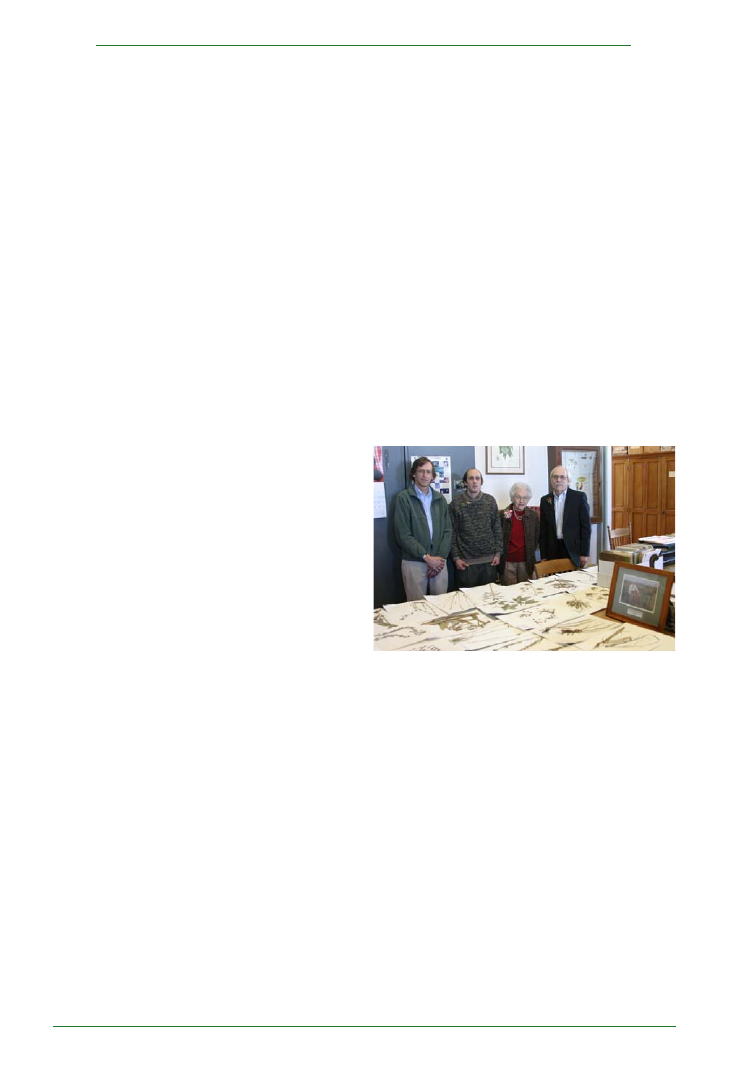
6 4
Plant Science Bulletin 53(2) 2007
level, it is expected that this person would participate
in the coordination of certificate and degree-oriented
program strategies to grow new initiatives and
strengthen current offerings. Experience in adult
education program expansion, particularly the
creation of innovative offerings that may be
considered eclectic or cutting-edge, is desired.
This person must have at least five years of
management-level responsibility for professional
staff supervision, budgetary accountability at a large
program or departmental level, external relations
including outreach, and working with committees of
board of directors or program advisory groups. A
bachelor’s degree from an accredited college or
university is required; an academic degree at the
masters or doctorate level is highly preferred.
Leadership and recognition in professional
membership organizations at the local, regional
and national level would be a plus. Evidence of
continuing professional education in such areas
as collections-based educational programming,
marketing, teacher training and related topics is
desirable.
For more information, please contact:
S. Ross Hechinger
Principal, Eastern Region
Kittleman & Associates
1250 24
th
Street, NW, Suite 300
Washington, DC 20037
LG-DOE@kittleman.net
Phone: 202-467-2790
Fax: 202-4672791
Longwood Gardens, Inc. is an equal opportunity/affirmative
action employer. Applications from members of historically
underrepresented groups are especially encouraged.
Other
Women Pioneers in Plant Biology
From Lee Kass:
The bio’s I was invited to submit about Barbara
McClintock and Harriet Creighton are now posted
on the Women Pioneers in Plant Biology, American
Society of Plant Biologists webpage:
h t t p : / / w w w . a s p b . o r g / c o m m i t t e e s / w o m e n /
pioneers.cfm#McClintock
h t t p : / / w w w . a s p b . o r g / c o m m i t t e e s / w o m e n /
pioneers.cfm#Creighton
Countryman Family Gift to Pringle
Herbarium
The University of Vermont’s Pringle Herbarium
received a valued addition to its permanent
collection this year with the donation of the
private herbarium collection of the late William
Douglas Countryman, who died in 2005 at the
age of 84.
Countryman, a member of the biology faculty at
Norwich University from 1948 to 1974 and chair
of its Biology Department from 1961 to 1969,
was an expert in the flora and fauna of Vermont,
particularly aquatic plants and rare, threatened,
and endangered species. His interest in the
collection and preparation of diagnostic
specimens led him to build a major personal
herbarium collection, some 10,000 specimen
sheets of which will be available to students,
faculty, and the public in the Pringle Herbarium
in UVM’s Torrey Hall.
The Countryman collection joins over 270,000
sheets of mounted and accessioned plants
which make the Pringle Herbarium the third
largest in New England. Central to the
herbarium are the extensive Mexican
collections of its namesake, Cyrus G. Pringle
(1838-1911), whose aggressive exchange
program with a suite of approximately two dozen
international and national herbaria between
1885 and 1911 brought a
large geographically and taxonomically diverse
representation of the orld flora to the herbarium.
At the same time, the herbarium is the definitive
David Barrington, director of the University of Vermont
Pringle Herbarium, left, honored the William D.
Countryman family recently with a reception marking
the family’s donation of Countryman’s personal
herbarium to UVM. Beside Barrington are Chris
Countryman, Anne Countryman and William
Countryman, Jr.
PHOTO CREDIT : Cheryl Dorschner

6 5
Plant Science Bulletin 53(2) 2007
repository for the flora of Vermont, including the
largest Vermont flora collection in the world.
Countryman’s widow Anne and sons William,
Jr., and Chris formally resented the gift to the
Pringle Herbarium at a ceremony and reception
on December 12, 2006. Anne Countryman said
the family decided the collection belonged at the
University of Vermont, where is would be
accessible to as many students as possible.
“He wanted this material to be available to
inspire students,” she said. “That’s what he
wanted more than anything else.”
Pringle Herbarium director David Barrington
said the gift from the Countryman family “brings
one of the most important private collections in
Vermont here where it belongs.” He said he was
privileged to know Dr. Countryman well over
many years and singled out his “extraordinarily
deep and broad understanding of natural history
— and his sense of humor” as the personal
traits for which he will be remembered most.
With the donation of the Countryman collection
to the Pringle Herbarium, he said, Dr.
Countryman solidifies his place among “the
greats of Vermont botanists.”
Call for Nominations
Editor of Chinquapin
The Newsletter for the Southern
Appalachian Botanical Society
The Southern Appalachian Botanical Society (SABS)
is seeking nominations (including self-
nominations) for the position of editor of the society’s
quarterly newsletter, Chinquapin. Chinquapin
provides members with news of plants in the east,
society news, book reviews, and other topical
information of interest to people in the SABS, and to
people who are interested in plants in general. We
wish an editor who can generate both a hard copy
for mailing and an online version for our website
(www.newberrynet.com/SABS). The editor also
becomes a member of the Executive Council of the
SABS.
Qualifications include membership in SABS and a
background in plant research, with a minimum of at
least a Masters degree in the botanical sciences,
or, equivalent experience working with plants for a
number of years. Successful candidates should
also have extensive word processing skills,
including WORD and/or WordPerfect, and good
organizational and communication skills.
Knowledge of Microsoft Publisher is also desirable,
but not required.
Nominations may be sent via email or regular mail
to:
Dr. Howard S. Neufeld, President
SABS
Department of Biology
572 Rivers St.
Appalachian State University
Boone, NC 28608
email:
neufeldhs@appstate.edu
Tel: 828-262-2683
Nominations should be received by March 31, 2007,
but the position will remain open until filled. For
further information on the position, please contact
Dr. Howard Neufeld.
Call for Papers
CBE—Life Sciences Education
Announces a Special Issue:
Issues in Developmental Biology
Education
Exciting new discoveries in the field of developmental
biology—from findings about the molecular
mechanisms of axis specification and induction, to
new insights into the pluripotency of cells in the early
embryo, to powerful new imaging techniques for the
dynamic analysis of development—present
abundant opportunities to engage students of all
ages in understanding how mature organisms
arise from a fertilized egg. Unlocking the mysteries
of their own development is an inherently engaging
topic for most students, and the societal implications
of research in developmental biology are enormous.
Nevertheless, few students have had the opportunity
to delve into the cellular and molecular insights that
have emerged in the field of developmental biology
in the last two decades. As such, the developmental
biology community is increasingly exploring
innovative strategies to teach developmental biology
to students at all levels, to forge educational
collaborations across institutional boundaries, and
to translate knowledge emerging from
developmental biology research into engaging
educational materials.
CBE—Life Sciences Education (CBE-LSE) will
publish a special issue devoted to these topics,
titled Issues in Developmental Biology Education.
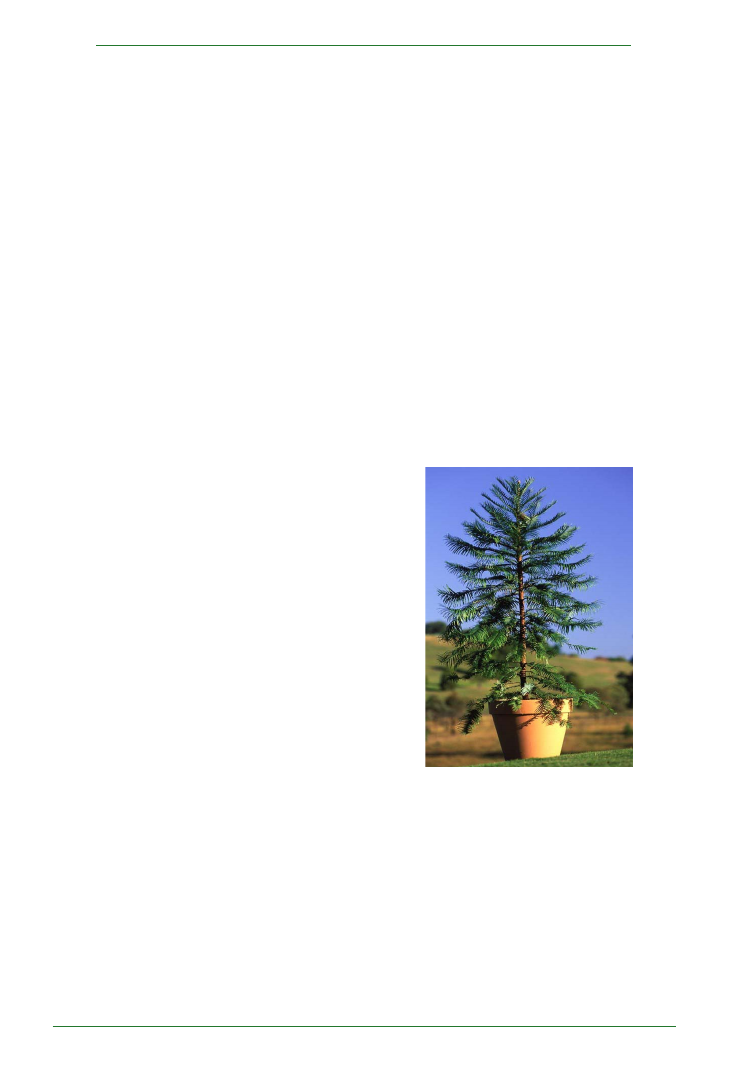
6 6
Plant Science Bulletin 53(2) 2007
The special issue will highlight innovative
approaches to the teaching and learning of
developmental biology. Authors are encouraged to
submit research articles and essays on topics
including, but not limited to, the following areas of
interest in developmental biology education:
·
Undergraduate laboratory activities
·
Partnership and outreach in
developmental biology education
·
Developmental biology resources on the
Internet
·
Innovative approaches to developmental
biology lecture courses
·
Revision of undergraduate developmental
biology curriculum
·
The role of developmental biology in
undergraduate/K–12 education
·
Involving developmental biologists in K–
12 education
·
The interface of developmental biology
and bioethics
In addition, this special issue will include invited
commentaries on the potential implications of our
knowledge of embryonic development for general
approaches to teaching and learning.
Issues in Developmental Biology Education will be
published online in Winter 2007. Submissions
must be received by July 1, 2007. All manuscripts
will be subjected to peer review. For author
instructions and details about the online submission
process, please visit:
http://www.lifescied.org/
preview_misc/ifora.dtl.
For more information,
contact Thea Clarke at cbe@ascb.org.
CBE-LSE (
www.lifescied.org
.) is an online,
innovative, quarterly journal owned and published
by the American Society for Cell Biology. CBE-LSE
publishes original, previously unpublished, peer-
reviewed articles on life science education at the K–
12 outreach, undergraduate, and graduate levels.
The journal places a strong emphasis on the
assessment of educational techniques; see the
instructions for authors for more information. The
target audience includes those involved in K–12
outreach; community college, comprehensive
college, and university teachers; and graduate
students, postdocs, and students in teacher training
at any level. All published articles are available
freely online without subscription. In addition, more
than 7,100 readers have signed up to receive
quarterly e-mail alerts of new content. Articles are
indexed in PubMed and available through PubMed
Central.
Jeff Hardin, PhD
Issue Editor
An Ancient Tree Now Grows in
Brooklyn:
Brooklyn Botanic Garden Debuts
The Wollemi Pine
“Living Fossil” Is Added to the
Garden’s Trail of Evolution Exhibit
As part of its mission to share with the public
information on plant conservation, Brooklyn Botanic
Garden (BBG) announced it has secured a
specimen of the extremely rare Wollemi pine
(Wollemia nobilis), which will be added to the
Garden’s permanent plant collections and featured
on public display beginning Friday, January 19,
2007. Referred to as a “major botanical find of the
century,” the Wollemi pine was believed to be extinct
for 2 million years. But in 1994 a small grove of trees
was discovered in Australia’s Blue Mountains by
New South Wales National Parks and Wildlife
Service Officer David Noble, setting off worldwide
excitement for a majestic plant that managed to
survive through 17 ice ages over the past millennia.
Since its rediscovery, scientists and horticulturists
have studied the Wollemi pine to learn how this
ancient species was able to survive. At the same
time, because fewer than 100 trees exist in the wild,
a burgeoning plant-propagation and
commercialization initiative has been launched-
the cornerstone of the conservation strategy to
preserve these trees in their native habitat. Royalties
from the sale of cultivated Wollemi pines will go
toward conservation efforts. Brooklyn Botanic
Garden is offering a limited number of the trees so
that visitors will be able to participate in the
Wolle - in - a - pot

6 7
Plant Science Bulletin 53(2) 2007
conservation effort by purchasing this ancient and
rare tree to take home. All trees sold in the U.S. are
sold under the National Geographic brand.
BBG’s own Wollemi pine will be displayed in the
Steinhardt Conservatory’s Trail of Evolution, which
traces the development of plant life from its origin
four billion years ago to the present day. The Wollemi
pine belongs to the ancient coniferous family
Araucariaceae, whose fossil record dates back
over 200 million years to the time of the dinosaurs.
The intrepretive information for the Garden’s Trail of
Evolution presents data on the evolution of plants,
and one of the panels emphasizes the living-fossil
characteristic of the family. Visitors can see the
beauty of the tree itself that, at maturity, showcases
bark that looks like bubbling chocolate and multiple
trunks with fernlike foliage.
“The discovery of a plant long thought to be extinct
and only known through fossils is an exciting and
remarkable story that fires the imagination,” said
Scot Medbury, president of Brooklyn Botanic Garden.
“Plants that have outlived the dinosaurs present a
thrilling tale for children and collectors alike, and
Brooklyn Botanic Garden is delighted to be able to
showcase the Wollemi pine for our visitors. We look
forward to nurturing these young plants so that
future generations will be able to enjoy them,”
Medbury added.
“The addition of the Wollemi pine to BBG’s plant
collections also offers us an important opportunity
to demonstrate the Garden’s extensive plant
conservation efforts and the excellent environmental
stewardship initiatives that we have been working
on with Botanic Gardens Conservation International
(BGCI) and the Center for Plant Conservation (CPC),”
explained Medbury. “Through this exhibit, the Garden
can communicate the alarming rate at which far too
many plants are facing extinction.”
The Garden’s Education Department will offer fun,
instructional activities for children and their families
in order to spark the thrill of discovery and offer a
chance to be part of the living history of the Wollemi
and other ancient endangered plants, as well as to
inspire a plant conservation commitment. On
weekends, there will be interactive Wollemi pine
Discovery Carts in the Steinhardt Conservatory.
Children can investigate modern-day plants that
were part of the landscape when dinosaurs roamed
the earth and make a leaf rubbing from one of these
“living fossils.”
The Garden will provide comprehensive and
informative material on the award-winning BBG.org
website, and the volunteer Garden Guides will
provide visitors with a compelling tour of the Trail of
Evolution in the Steinhardt Conservatory.
The Wollemi pine exhibit in the Steinhardt
Conservatory will be on display beginning January
19.
Young visitors
WEB LIBRARY OF BOTANICAL
REFERENCE, RARE BOOKS NOW AT
+500,000 PAGES
Three years ago, the creators of Botanicus.org set
out to build one of the world’s largest digital libraries
to allow free and improved access to historic
scientific literature.
And they have certainly succeeded. The Missouri
Botanical Garden-based Web encyclopedia recently
surpassed the 500,000-page milestone,
encompassing over 1,000 volumes online, and
counting.
Botanists, researchers, students, and anyone
interested in natural history and beautiful rare books
can search this digitized library of books that date
from 1480 to 1980, including important botanical
literature by Charles Darwin and Carl Linnaeus.
Users can search by title or author, and volumes are
fully text searchable as well. New technology allows
zooming in for close up views of illustrations and
text, and new tools have been implemented for
locating scientific data within the texts themselves,
such as plant names and geographic locations.
“We’ve used emerging technologies to digitize and
present these historic titles online, letting users
interact with them in ways impossible with a bound,
paper-based book sitting on a library shelf,” said
Chris Freeland, application development manager.
The Garden has been digitizing its research library
materials since 1995, focusing primarily on

6 8
Plant Science Bulletin 53(2) 2007
beautifully illustrated volumes from its fine rare
book collection. The Botanicus project was funded
by a $950,000, three-year grant in 2004 from the
W.M. Keck Foundation. The project team used the
Garden’s TROPICOS database to identify 500 of the
most heavily cited botanical journals and books,
and prioritized them for digitization.
“We wanted to build a highly interactive and
searchable digital library of rare legacy botanical
literature essential for research in plant biodiversity,
and make it freely accessible to any researcher in
the world,” said Doug Holland, curator of library
services and technology.
Digitizing, indexing, and annotating historical
scientific literature is vital to future research in
systematic botany, the science of plant identification.
Like other natural history disciplines - but unlike the
physical sciences - systematic botany is built upon
and requires frequent reference to the literature of
its past. To conduct carefully documented and
authenticated research, botanists must spend
weeks in the library searching the published
botanical literature for data to develop a new project
or substantiate their recent observations.
Comprehensive collections of botanical literature
are only available in a handful of libraries, and all of
them are in North America and Europe. Over 67,000
systematic botanical publications exist, but only
those most recently published are in digitized form.
“For botanical researchers, these library-centered
literature searches can delay hypothesis
development or recognition and publication of their
new plant discoveries,” said Holland. “For those
traveling in remote parts of North America or
stationed overseas, a lack of access to library
resources compounds these difficulties. Further,
no matter how scrupulous the search, when
scientists must work manually through an array of
journals and books it is impossible to be sure that
all historical facts have been located and all
published observations have been seen.”
Botanicus is being used as a model for use in the
emerging Biodiversity Heritage Library Project, said
Freeland. The project is a collaboration by 10 of the
world’s largest natural history libraries to scan and
make all botanical and zoological descriptive
literature freely available.
PLANTS OF MERIT ARE THE
FOCUS OF A PHOTO CONTEST
(ST. LOUIS): The Plants of Merit will be “ready for their
close up” this spring and summer! If you like to take
photographs in the garden, consider focusing on these
exceptional plants when the Missouri Botanical Garden’s
Plants of Merit program holds its first-ever, six-month
photography contest beginning Mar. 1.
Plants of Merit are chosen for their easy-to-grow, disease
resistant qualities and outstanding ornamental value;
however, they are not widely planted in lower Midwestern
landscapes. The Missouri Botanical Garden in St. Louis
partners with Powell Gardens in Kansas City, Mizzou
Botanic Garden in Columbia, and the University of Missouri
Extension in this regional program that selects various
annuals, perennials, shrubs, vines and trees each year for
recognition. The purpose is to increase home gardeners’
success and promote regional horticultural diversity,
explained Mary Ann Fink, Plants of Merit coordinator.
For a complete list of all eligible plants, search
www.plantsofmerit.org
<
http://www.plantsofmerit.org
/
> and click on the link to “view just a list of all the Plants
of Merit.”
“We’re offering photographers a chance to have their
work reproduced and displayed at the Garden,” said Fink.
“We also hope to expand our Plants of Merit image library
with all of the photographs we expect toreceive.”
Winning photographs from the contest will be reproduced
as note cards and exhibited at the Kemper Center for Home
Gardening in late 2007. Winners will be selected by a panel
of judges that includes members of the Plants of Merit
Advisory Committee, Garden staff, and a professional
photographer.
Photographers of any age, both amateur and professional,
are eligible to enter at no charge. Simply submit an eight-
by-ten inch printed color photograph of any Plant of Merit,
either current or emeritus status. A compact disk must also
accompany the printed photograph. One person may
submit more than one photograph, but only photograph per
Plant of Merit. Photos must not contain people. E-mailed
files will not be accepted. Submitted photos and compact
disk will not be returned.
The Plants of Merit program will retain all copyrights
to submitted entries for its image
library. Photos may
be reproduced in brochures or other printed materials,
online, or in the media.
Entries must be postmarked from Mar. 1 through Aug. 31,
2007. Mail to Plants of Merit Photo Contest, c/o Kemper
Center for Home Gardening, Missouri Botanical Garden,
P.O. Box 299, St. Louis, MO 63266-0299.
Complete contest rules are online at
www.plantsofmerit.org
. No purchase is necessary
to enter. Void where prohibited by
law. Terms of the
contest are governed by official rules; see official contest
rules for details. For questions, call (314) 577-9443.

6 9
Plant Science Bulletin 53(2) 2007
Deforesting the Earth: From Prehistory to Global
Crisis: An Abridgement. Williams, Michael. 2006.
ISBN: 0-226-89947-0. (Paper, U.S $25.00) 543 pp.
The University of Chicago Press, Chicago, Illinois
USA 60637.
Reading this book is akin to reading the history of
humans on planet earth from 10,000 bp to the
present — but with the singular focus on how we
have dealt with our forest resources over time. As
such “Deforesting the Earth” provides ample grist
for anthropologists to activists, botanists to
boatbuilders, historians to hemispheric planners,
theologians to theoreticians. As the author states
in the preface: “perhaps more of the earth’s surface
has been affected by this process than by any other
single human activity”. This is a big-picture book
that the author deems “an essay in both landscape
history and environmental change” – and, I might
add, builds this chronicle on a wealth of detail.
If the heft of this thick paper-back book is intimidating,
chill out – this is just the abridged version of the full-
length tome published in 2002 (which I have not
seen). Fortunately the writing is fluid and, as noted
on the back cover, “accessible to a general
Ecology
Deforesting the Earth: From Prehistory to Global Crisis: An Abridgement. Williams, Michael.
- - Richard Jagels.................................................................................................................................................69
Emerging Threats to Tropical Forests. Laurance, William F. and Carlos A. Peres (eds.)
- - Kenneth Young................................................................................................................................................ .70
Economic Botany
Native Treasures: Gardening with the Plants of California. Smith, M. Nevin.
- - Linda M.K. Johnson...........................................................................................................................................72
Natural Enemies – An Introduction to Biological Control. Hajek Ann, - - Suzane Koptur........................73
The Organ Pipe Cactus. Yetman, David A - - Root Gorelick.........................................................................74
Plant Exploration for Longwood Gardens. Anisko, Tomasz. -- Joanne Sharpe......................................75
Saffron (Crocus sativus) Production and Processing. . M. Kafi, A. Koocheki, M. H. Rashed, and M. Nassiri,
editors - - Lytton John Musselman......................................................................................................................76
Education
Flowers: How They Changed the World. William C. Burger. - - Joseph Armstrong...................................76
The Leaf. Jensen, L. - - Beverly J. Brown...........................................................................................................78
The Intelligibility of Nature: How Science Makes Sense of the World. Peter Robert Dear. - - Tadeuz
Anisxewski................................................................................................................................................................78
Physiology
Dictionary of Plant Tissue Culture. Cassells, A. C. and P. B. Gahan -- Henry R. Owen..........................78
Plant Hormone Signaling (Annual Plant Reviews), Volume 24. Peter Hedden and Stephen Thomas (eds).
- - Beronda L. Montgomery....................................................................................................................................80
Plant Roots: Growth, Activity and Interaction with Soils. Gregory, Peter. 2006
- - Dorothea Bedigian............................................................................................................................................82
Structure
Esau’s Plant Anatomy: Meristems, Cells, and Tissues of the Plant Body – Their Structure, Function,
and Development, 3
rd
ed. Evert, Ray F. - - William Louis Stern....................................................................83
The Structure and Function of Plastids: Advances in Photosynthesis and Respiration, Volume 234.
Robert R. Wise and J. Kenneth Hoober (eds). - - Beronda L. Montgomery.................................................85
Books Reviewed

7 0
Plant Science Bulletin 53(2) 2007
Emerging Threats to Tropical Forests. Laurance,
William F. and Carlos A. Peres (eds.). 2006. ISBN
0-226-47022-9 (PaperUS$40.00) 563 pp. The
University of Chicago Press, 1427 E. 60th Street,
Chicago, IL 60637.
Despite numerous publications and a high profile
in terms of environmental issues, losses of tropical
forests and their associated biological diversity
continue. This edited book examines the various
threats arrayed against tropical biodiversity,
providing an updated and global perspective, while
striving to stress poorly known and complex drivers
of change. It is fairly well balanced geographically,
nicely produced and edited, and referenced with a
joint listing of about 1300 citations to the relevant
literature.
The editors, William Laurance and Carlos Peres
are tropical biologists dedicated to conservation-
relevant research on tropical forests and biota. They
have facilitated the involvement of 49 contributors
with this book project, and have had the chapters
peer reviewed and then organized into six sections.
They identify four areas of concern, namely 1) change
caused by atmospheric and climate processes, 2)
synergistic effects of interacting change processes,
3) pathogens and invasives, and 4) cryptic threats.
readership”. The organization is logically
chronological, so a reader can temporarily skip
sections and focus on certain time periods – but
with the risk that he will be drawn backward rather
than forward to assuage his curiosity.
The book begins with a short chapter on the post-
glacial era. As someone interested in paleoecology
I could have wished for more information here – but
then the book might have approached 1,000 pages.
The next two chapters focus on the early shaping of
the forest, first with fire and then with agriculture.
This first section on “Clearing in the Deep Past”
concludes with a chapter each on the classical
world (focused on Rome and Greece) and the
medieval world (mostly Europe, but with a nod to
China). It is here that we begin to see the devastating
effect on forests from the rapidly growing enterprises
of shipbuilding, metal smelting and urbanization.
Williams concludes this section with an interesting
comparison between China, where a rapidly
expanding peasant population was devastating
indigenous natural resources, and Europe, that
“broke out of its vicious circle of subsistence when
it was able to reach out and garner the resources of
the wider world”. One can readily see parallels with
the United States as it protected its forest resource
during the past century by importing its wood from
the forests of Southeast Asia, Africa and Latin
America.
Part II expands outward from Europe and covers the
period of about 1500 to 1920, beginning with the
“age of discovery”. New European technology
(printing presses gobble paper), population growth
(the plagues subside) and a fascination for new
products (coffee and tea become Europe’s “soft
drugs”) all lead to deforestation and population
disruptions in the wider world of the tropics. As one
observer noted: “these two vegetables [coffee and
tea] have brought wretchedness and misery upon
America and Africa”.
One of the more cogent sections in the book for plant
ecologists and conservation biologists is part III,
The Global Forest – where the author deals with
changes since 1900. As grim as we may portray
tropical forest destruction today, it pales in
comparison to the devastation wrought in post-
colonial America – a period that culminates in
Teddy Roosevelt’s “timber famine” speech of 1905.
The formation of the U.S. Forest Service under
Gifford Pinchot’s direction begins the turnaround of
this trend as abandoned and degraded agricultural
land in the eastern U.S. gives way to restored
forests. While this is happening, however, the
situation grows worse in other parts of the world,
driven to a large extent by increasing wood demands
from the developed world. But history has a way of
returning to haunt us. Current U.S. admonitions
about tropical forest destruction are countered in
places like Brazil by citing the past U.S. forest
destruction as their role model!
The book ends with an epilogue: Backward and
Forward Glances. Here the author loosens his belt
a bit and provides a more personal perspective —
and critiques other books on the subject. Among a
number of references, he frequently cites FAO (Food
and Agriculture Organization of the United Nations)
publications. Having recently spent three months
on a consultancy in the forestry division at FAO
headquarters in Rome, I can attest to the immensely
valuable global perspective of FAO documents.
Check out their website (www.fao.org.). A weakness
I found in this section was the absence of any
meaningful discussion of global climate change –
but perhaps Williams is holding that for a sequel.
In summary, if you are looking for a book that
focuses on the deep biological consequences of
deforestation, this is not the treatise for you. But if
you wish to broaden your biological background to
include cultural and historical perspectives this
book is your ticket.
-Richard Jagels, Forest Biology, University of Maine.

7 1
Plant Science Bulletin 53(2) 2007
These respective sections are then bundled
between an introductory essay and two concluding
sections that evaluate possible solutions and outline
what should be done in terms of both research and
conservation efforts.
Given future global climate change, it is likely that
the most threatened tropical environments are on
islands and coasts that will be affected by sea level
rise, and also in tropical highlands, where some
species distributions will shift upward while other
species will find their environmental requirements
no longer satisfied. Only one chapter, by Williams
and Hilbert on Australian rain forests, looks at the
alarming case for upland species facing
compressed potential ranges, while none look at
tropical mangroves or other coastal environments.
This research void is recognized by the editors in the
conclusions; they suggest that a “land and sea”
approach would help link terrestrial changes to
concurrent effects offshore. Most of the chapters
that examine climate do so for tropical rain forests
that are being altered by changed ecohydrological
conditions or fire regimes, and apparently also by
increased growth and turnover of some plant life
forms due to higher carbon dioxide concentrations
in the atmosphere. Shugart and colleagues evaluate
the case for tropical savannas, pointing out that the
lessened rainfall expected by many climate models
for the lowland tropics will increase fire-caused
shifts to nonwoody vegetation while also interacting
in complex ways with human land use systems
associated with the grazing of livestock.
Synergies are of concern because two (or more)
interacting processes can produce nonlinear or
otherwise hard-to-predict changes. The authors in
this section mention how forest patches are exposed
to increased fires on their edges and are much
more likely to be overhunted, in addition to losing
species because the surface area of habitat is
reduced. Like other sections in the book, this one
offers some chapters that are data papers and
others that serve as literature reviews. Peres and
Michalski use spatial and regression analyses to
assess forest fragmentation effects in Brazil, while
Olupot and Chapman quantify the length of the
human-caused edge effect that alters conditions
into Bwindi Impenetrable National Park in Uganda.
Increased pathogen activity and diseases can be
due to climate change altering distributions and
biophysical conditions, while human-caused
changes are increasing the spread of fungi,
microbes, and vectors. Both Cunningham et al. and
Walsh provide useful perspectives, especially on
the sobering spread of Ebola among the remnant
populations of African apes. Synergies have created
novel circumstances that threaten primates,
amphibians, and plants, among others. In many
cases, human health and/or economic interests
are also directly threatened.
The section on “cryptic” threats is somewhat less
cohesive given their ambiguous nature and the
poor level of current understanding. Examples
explored include the effects of surface fires in rain
forests, of roads, and of illegal logging. Terborgh
and Nuñez-Iturri predict large spatial changes
among forest trees resulting from altered seed
dispersal caused by loss of certain vertebrates due
to hunting and habitat fragmentation. Develey and
Metzger use landscape metrics to analyze
quantitatively how fragmentation affects bird species
diversity and composition among the remaining
patches of Atlantic rain forest in Brazil. These authors
and others in this section show that altered
landscape patterns in turn change population
processes such as recruitment, mortality, and
persistence, but often with consequences that are
subtle or species specific.
The section on solutions for these emerging threats
includes six chapters that contain much wisdom
acquired from considering financial aspects of
funding conservation and protection programs, from
planning for climate change mitigation, and from
implementing integrated conservation and
development projects. Fagan et al. propose
=increasing the stakes by asking the global
environmental community to lobby for the
protectionof 50% of the world’s tropical forests,
rather than settling for a fraction of that amount.
There are ssessments by Niesten and Rice of the
use of various conservation incentives and by Turton
and Stork of the promise and limitations of using
tourism to foment forest conservation. These
chapters do not repeat truisms or generalities
found in some pleas for tropical forest conservation,
but rather are based on the experiences and
research of the authors, avoiding oversimplification
and also defeatism.
Overlooked in this otherwise splendid collection,
are some of the utilized landscapes of the tropics
that also contain biodiversity of concern. For example,
tropical agricultural and forestry systems are not
considered in depth, and the rather different
concerns of indigenous people are not elucidated.
The cover photograph of the book showing a recently
burned tropical forest, for example, is in fact
somebody’s garden or agricultural field—beware
of blaming the victims when it comes to tropical
deforestation. In their chapter, Whitten and Balmford
provide a means to evaluate the magnitude of
opportunity costs borne by local people living nearby
a protected tropical forest. For that matter, some
habitat fragmentation of tropical forests exists
independently of human effects, for example in

7 2
Plant Science Bulletin 53(2) 2007
Native Treasures: Gardening with the Plants of
California. Smith, M. Nevin. 2006. ISBN 0-520-
24426-5 (paperback, US $24.95). 278pp. University
of California Press. Berkeley and Los Angeles,
California, USA.
As a native plant enthusiast and a life-long East
Coast resident, I’ve grown very comfortable in the
realm of eastern deciduous woodland natives. So
the prospect of reading through M. Nevin Smith’s
Native Treasures: Gardening with the Plants of
California was like being awarded a virtual field trip
to learn about “native” plants that are mostly exotic
to my experience.
Smith prefaces his work with a disclaimer of sorts
– the book is neither a “how-to” guide nor an
encyclopedia of California natives, but more of a
gentle introduction to gardening in California with
interjections of the author’s musings on various
local conditions and groups of valued plants. The
format of the book compliments these goals. First,
Smith tells the readers what they need to know
about gardening in California using its native
botanical bounty, and then he tells us what he wants
us to appreciate about that menu of plants that is
available horticulturally.
The first fifth of the work is dedicated to general
gardening principles and how to apply them to the
plants of California. The Introduction is really an
overview of the Golden State in all its ecological
diversity. The variation in habitat throughout the
state is linked with differences in topography, soils,
underlying geology and patterns of rainfall,
temperature and fire. The interaction of these
influences leads to vast differences in the ecological
parameters of regions within the state – coastal,
near-coastal, basin, mountain, desert – and to
great diversity in the plants that grow in each of these
areas. I was very pleased to see Smith point out that
“Californian” does not necessarily mean “Native”
since the habitats are more important than the
political boundaries. He revisits these regions in
his discussions of design and site considerations,
and there may have been less repetition in the text
if he had tackled the issues region by region from
the onset.
The author spends a bit of space sharing his
rationale for growing natives: they are a celebration
of local origins, they handle the environmental
extremes that California offers, and they “capture an
impression” of the natural landscape. He is not a
purist about using natives nor does he advocate
constructing little “plant zoos” in our gardens while
the habitats of origin are destroyed.
The remainder of the basic information focuses on
design considerations, the importance of educating
oneself about local conditions and suitable plants,
and lastly, how to propagate plants both sexually
and asexually. These chapters serve as a review
about gardening challenges – soils, irrigation, pests
and diseases – and seem to best meet the needs
of individuals with some gardening experience, but,
as a review, clearly not those needs of novices. For
many of the points he makes, Smith suggests a
California native plant solution. The chapter on
propagation does a more complete job as a crash
course in plant multiplication. Smith covers the
pros and cons of seed versus vegetative propagation
as well as the methodology for each, and he evens
remembers to discuss an important consideration
for many natives – seed pretreatment.
Smith devotes the remaining four-fifths of Native
Treasures to those plants that hold special places
in his treasury. This section, entitled “A Few of My
Favorite Things”, is subdivided into chapters on
trees, shrubs, “two genera’ (sages and
buckwheats), subshrubs and herbaceous
perennials, bulbs and corms, and finally annuals.
The breadth of coverage within each chapter varies
widely. Only oaks and madrones are explored in the
Trees chapter, while thirteen shrub genera and over
fifteen annuals are described in their respective
chapters. With each plant group, Smith presents
savanna-forest ecotones and in many mountainous
areas. As a result, a longer term perspective on
forest fragmentation would be useful, distinguishing
consequences in ecological time frames, as is
done in this volume, from the different results of
fragmentation that have played out over evolutionary
time in terms of diversification.
This edited collection will provide a thought provoking
and current overview of the sources of risk to the
biodiversity of tropical forests. It would make for a
useful volume for a graduate or advanced
undergraduate seminar class. Its summaries of
emerging threats constitute a report card on how
well scientists and conservationists are doing in
grasping the magnitude and complexity of human-
caused changes in the tropics.
-Kenneth R. Young, Department of Geography and
the Environment, University of Texas, Austin, TX
78712

7 3
Plant Science Bulletin 53(2) 2007
Natural Enemies – an introduction to biological
control. Hajek Ann, 2004. ISBN 0-521-65385-1
(Paper US$50.00) 378 pp. Cambridge University
Press, 40 West 20th St, New York, NY 10011-4211.
This book includes every kind of natural enemy
used to control insects and plants that are problems
for human beings. Ann Hajek first makes the case
for biological control, as an environmentally sound
alternative to chemical control (to which most
organisms evolve resistance). She takes us
through a brief history of the development of
biological control, including the standard
experimental protocols used in the different lines of
research. She first reviews successes in classical
biological control, then presents two newer forms
of control jointly termed augmentation (inundative
and inoculative biological control) and discusses
how products are made available for commercial
use. My interests in tritrophic interactions led me to
appreciate her chapter on conservation and
enhancement of natural enemies, especially her
general review of methods of enhancement of insect
carnivore populations, providing a basis for more
detailed compendia (e.g., Wackers, Van Rijn, and
Bruin 2005).
Hajek uses many examples and includes many
suggestions for further reading after each chapter.
The book is richly illustrated with very nice drawings
and figures from a variety of talented artists.
Fascinating and horrific parasitoids, strange
nematodes, and virus-stricken caterpillars are all
brought to life (or maybe I should say, death!) in
pictures as well as in Hajek’s descriptions of the
natural history and science of these interactions.
I expect that this book could be well utilized in a
course on the topic of Biological Control in a
department of Entomology or Agriculture, but also
it can help any botanist or ecologist understand this
complex topic with ease. My students and I have
learned a lot to help us in our own studies of biotic
plant defense, especially when we encounter an
unexpected twist in an interaction we are studying.
I recommend this very fine compendium to anyone
interested in species interactions, community
ecology, invasion biology, or conservation biology
-Suzanne Koptur, Professor of Biological Sciences,
Florida International University.
their “Common Features”, their “Uses and Culture”,
propagation information, and details on multiple
taxa in the group. The consistent format makes
each chapter easy to browse for information and the
accompanying photographs of selected plants
make that browsing a visual treat.
It is abundantly clear that Smith in enamored of his
plants! The poetry and enthusiasm of his description
of the seasonal aspects of oaks is usually reserved
for showier groups like roses and orchids. Not only
does he seduce the readers into the need for an oak
in their yards, the author also provides them with a
wealth of information about siting and mycorrhizae
to ensure the survival of that majestic genus. He
spends pages expounding on the wild lilacs
(Ceanothus) despite the fact that only a few of them
have achieved true popularity in the nursery trade.
He warns of their “wandering tendencies and certain
cultural quirks” while extolling the ease with which
they blend with other plants in the garden. In “Two
Genera”, Smith confesses to his ongoing love affair
with the genus Salvia and his “long friendship” with
the buckwheats. And, happily, in “Small Matters”,
Smith addresses the challenges and rewards of
growing some of those annual species that have
made their way into the seed trade – California
poppies, Phacelia, Nemophila, and Lupines,
among others.
Smith finishes up with a Resources section that
clearly underlines his commitment to education
about natives. In addition to other horticultural
books on California’s natives, Smith includes a
listing of appropriate floras, journals, and places to
visit to see these plants in action. Also, as one would
anticipate, he includes numerous internet sources
for seeds, plants, and native plant organizations.
The introductory materials of the book served as a
wonderful reminder as to why anyone anywhere
gardens with native plants – to create a sense of
place for both the human and non-human
inhabitants, to celebrate the treasure that is the local
flora and the fauna that it draws, and to meet basic
environmental needs – erosion control, privacy,
shade – using a palette of native species. As a
horticulturist, I appreciated Smith’s collection of his
“Favorite Things” to remind me how many plants in
the horticultural trade originate on this continent and
how different the floras of the two coasts are. Smith’s
book serves as an educational tool for those non-
Californians among us and as an inspiring resource
for those challenged with gardening in the Golden
State.
- Linda MK Johnson, Department of Biology,
Chemistry and Environmental Science, Christopher
Newport University, Newport News, VA, 23606, USA.
Deuternomy 11:15
I will provide GRASS in the fields for your
cattle, and you will eat and be satis
fied.

7 4
Plant Science Bulletin 53(2) 2007
The Organ Pipe Cactus. Yetman, David A. 2006.
University of Arizona Press. $9.95 (USD)
paperbound, 70 pages. ISBN 978-0-8165-2541-6.
This short book provides a sound and succinct
account of the organ pipe cactus (Stenocereus
thurberi), especially its interactions with humans
(and to a much lesser extent, interactions with the
lesser long-nosed bat). Yetman discusses this
charismatic cactus species as though he knows it
personally, which – after almost a half century
acquaintance – he undoubtedly does know
intimately. The organ pipe is a 1-10 metre tall cactus
that branches profusely from the base and is probably
the most characteristic plant species of the Sonoran
Desert.
At first blush, this appears to be a pretty picture book
with cursory factoids about the organ pipe cactus
that one could readily compile from a litany of sources.
But appearances are deceiving. Yetman has written
a rich yet accessible book from his perspective as
an ethnobotanist. He clearly knows and has worked
with many of the experts in the field.
The organ pipe population of El Pitayal (named for
the organ pipe cactus, whose common name in
Mexico is pitaya), located in southernmost Sonora,
provides several fascinating conundrums. Why
does this southern population flower and fruit much
later than more northern populations? In virtually all
other plant species, we see the opposite pattern,
probably due to temperature gradients. The El
Pitayal population is of extremely high density, with
huge plants, but essentially no seedlings. Why this
peculiar demography? Is this an example of negative
density dependent selection? What determines
regeneration rates, especially of such long lived
perennials? Yetman shows that there is no seedling
recruitment in El Pitayal, even in areas where
livestock are excluded. However, he describes
nearby areas lacking livestock exclosures where
seedlings abound. Organ pipe cacti at El Pitayal
could provide several fascinating research projects,
if not research careers.
This book is peppered with many interesting and
unexpected pieces of information, of which I list a
small sample of three. First, organ pipe cacti in the
Pinacate Volcanic Region (immediately south of
Organ Pipe Cactus National Monument) grow
extensively along the routes that bats take from their
roosts to their feeding sites. The organ pipe cacti
effectively map the bat’s routes, almost certainly
due to the bats dispersing seeds in their feces.
Unfortunately this observation by Bill Peachey
appears to have never been published, other than
possibly in a meeting abstract. Second, for most
species of cacti, cuttings are best taken in warm
weather when plants are actively growing. Yetman’s
work in a Mayo village shows that the opposite is
true for organ pipes, where antithetically cuttings
taken in the cold of late winter root far better than
those taken in late spring or early summer. Third,
“many Mayo reported that the scorched peel of the
fruit is applied directly to the anus for hemorrhoids,
rightly cautioning that it must first be scorched
enough to burn off the spines.” I know organ pipe
cacti fairly well, having lived in southern Arizona for
several years and traveled in Sonora, but never
knew these tidbits.
This is wonderful natural history and human history
book, but does lack the precision of most biological
science books. Lots of the data is either anecdotal
or with very small sample sizes. Some things are
stated by Yetman without question, such as that
organ pipes have only been part of the Sonoran
Desert flora for the last few million years. This is a
bit misleading insofar as the Sonoran Desert has
only been around for a few million years. Plus, there
are no fossil cacti, except for in packrat middens that
are no older than 40,000 years old. These are not
complaints, but just reminders of the context in
which this book was written.
The only faults with this book are in details of
production of the figures and references. Except for
the front and back covers, no photo credits are given.
I suspect the author took all remaining photos, but
this was never stated. At the start of each chapter
is a pair of photos that are repeats of photos
appearing elsewhere in the book. The book would
have been approximately five pages shorter without
these repeated images, which is about ten percent
of the length of text. Format of references varies, e.g.
author’s first names are only sometimes
abbreviated. Even one of Yetman’s own citations is
incorrect: Yetman and Van Devender was published
in 2001, not 1991. But these are small complaints.
This is lively, entertaining, and informative reading
from someone who truly understands this plant and
its roles in people’s lives. The photos are all in
colour, of good quality, and beautifully integrated
with the text. This book sells for just under $10 (US),
so there is hardly an excuse not to purchase it.
-Root Gorelick, Department of Biology, Carleton
University, Ottawa, Ontario K1S 5B6 Canada.
Psalm 104:14
As for man, his days are lige GRASS; he flourishes
like a FLOWER of the field.

7 5
Plant Science Bulletin 53(2) 2007
Plant Exploration for Longwood Gardens. Anisko,
Tomasz. 2006. ISBN-13: 978-0-88192-738-2. 334
pages. Timber Press, Portland Oregon.
This book is an “armchair” tourist guide for anyone
who has ever felt the excitement of searching for
plants worldwide or even locally, or who has simply
wondered how some of the unbelievably colorful
nursery plants such as New Guinea Impateins
have come to appear in local gardens. The title
doesn’t begin to capture the excitement documented
in this very interesting and extremely well-illustrated
book.
The author, Tomasz Anisko, is plant curator at the
Longwood Gardens, a well-known botanical garden
in Pennsylvania. He has written a book to celebrate
the 50
th
anniversary of Longwood’s opening to the
public by describing 50 different plant exploring
trips that Longwood explorers have been involved
in since 1956. Such emphasis on exploration has
resulted in the expansion of Longwood Gardens’
collection from about 3,000 taxa to over 10,000. It is
a long, but fascinating book which takes the reader
around the world, starting with a 10-month trip to the
Himalayas with professional plant collector
Kingdom Ward and his wife Jean Kingdon Ward in
1956 and ends with a three-week trip to Chile by the
author and Tim Thibault, a curator of the Rancho
Santa Ana Botanic Garden in 2003. In between are
accounts of 48 other explorations by various groups
of horticultural explorers to all six continents in
search of seeds, cuttings and even whole plants of
display or research material. Just reading the book
is a fascinating journey.
What makes this book so readable is its style of
presentation. There are excellent color relief maps
throughout with each stop named and highlighted
in red. Each trip account is concise (average 6
pages) and describes the purpose, planning,
participants, route and a sample of plant material
encountered. There are excellent (mostly color)
photos of habitats, scenery, people and plants on
almost every page.
What really makes it all come alive are the incredibly
literate excerpts from the field notes and letters of
the explorers. The archives of Longwood Gardens,
USDA and others have provided vivid descriptions
of the excitement of discovery as well as the
discomforts and disappointments inevitable in such
undertakings. The text is made even more lively
through the use of intriguing subtitles for sections
describing the segments of each trip. Examples
include “Sleeping on dynamite” (in Kashmir),
“Surrounded by reminders of war” (in Korea), “Silver
goes to Longwood” (in Australia), “Holy week in
Madrid” (in Europe) and “Keeping ahead of the dust”
(in Central America).
Russell Seibert, the first director of Longwood
Gardens was the moving force behind many of the
earlier trips which usually involved collaboration
with other organizations such as the New Crops
Research Branch of the US Department of
Agriculture. He recognized the importance of
discovering new material, but was also interested
in expanding the ranges of existing horticultural
plant groups such as Camellias and
Rhododendrons through enhanced breeding
programs using collections from the colder limits of
their ranges. He emphasized the importance of
connecting with staff and educators at various
horticulture-related institutions and nurseries
throughout the world.
Later groups of diverse collaborators often returned
to the same general areas explored earlier, but with
a more direct focus based on earlier findings.
Through the chronological sequence of collecting
over a fifty-year period, one becomes aware of the
changing conditions in various parts of the world as
well as the effects of improvements in travel and
communication. Collaboration with faraway
colleagues becomes easier through cell phones
and the internet. Earlier logistic difficulties often
involved getting permission to get into remote sites,
while later explorers deal with the challenges of
getting permits to bring plant material back into the
United States.
One does not have to be a taxonomic expert to enjoy
this book. The author limits the plant names to a
select few of those collected and many of the
scientific names mentioned describe genera that
are very common in the garden. There are excellent
photos of some of the more beautiful or obscure
finds. I would recommend this book to anyone with
an interest in garden plants.
-Joanne Sharpe, Coastal Maine Botanical Gardens,
Boothbay Maine

7 6
Plant Science Bulletin 53(2) 2007
Flowers: How They Changed the World. William C.
Burger. 2006. ISBN: 1-59102-407-2: cloth (US$23).
337 pp. Prometheus Books, Amherst, New York,
USA.
Do we take enough time to smell the roses?
Botanists do not write enough articles or books
about botany for a general audience. Botanists
write lots of books and articles for other botanists,
and the scientific prose is often pretty dense and dry
even for us, and we speak the language. Botanists
also write dully thorough and thoroughly dull
textbooks, although they are not alone in this. But
then botanists wonder why more people are not
interested in botany. Botanists manage to make
botany a dull subject even for people who enjoy
gardening and landscaping as a pastime or hobby,
and that is nearly one-half of the adult population.
Even physicists have done a better job of popularizing
than botanists. Perhaps the scholarly demands of
being a professional academic or the priorities that
arise from our academic reward system prevent
botanists from presenting their knowledge in a form
palatable to the general public, but thankfully some
botanists decide to turn over a new leaf once they
retire.
Saffron (Crocus sativus) Production and
Processing. M. Kafi, A. Koocheki, M. H. Rashed, and
M. Nassiri, editors. 2006 Enfield, New Hampshire:
Science Press.244 pages + viii. Illustrated. ISBN 1-
57808-427-X. No price given.
I was drawn to this volume because of my research
on Bible plants (Musselman, 2007) which took me
to the saffron harvest in the Andulacia region of
Spain and consequently to growing saffron in my
home garden where, each first week of November,
the beautiful, heavily scented flowers appear with
their massive stigmata drooping between the purple
petals. As soon as the flowers open, I remove the
crimson stigmata and dry them gently to produce
the threads which constitute the spice saffron. My
experience as a saffron farmer is limited so I am
keen to learn more about growing this Bible plant,
a sterile triploid propagated only by corms. I thought
this book might help.
A more accurate title for this book would be Saffron
Production and Processing in Iran as all the work
reported here is based largely on the saffron industry
in that country. According to the authors, Iran is the
largest producer of this valuable spice, the most
expensive spice, even more costly than cocaine.
Because of demand, production is spreading to
new areas and at least one international
organization has advocated increased production
in areas where few other crops can grow. Its
requirement of little water makes it a promising crop
in many parts of the arid world. While there are
undoubtedly applications that can be made in other
saffron growing regions, this small well produced
book would be of greater value if it were more
inclusive. The recent (2005) I International
Symposium on Saffron Biology and Biotechnology
(International Society of Horticultural Science,
Leuven, Belgium) is a better investment for the
reader looking for a more global treatment of saffron
culture. The CD contains numerous contributions
from Iranian scientists as well.
Saffron (Crocus sativus) Production and Processing
gives an overview of the saffron industry and a
review of some related species in the genus Crocus
with pictures of varying quality. Other chapters deal
with overall agronomic practices, micropropagation,
indigenous knowledge (meaning how different
farmers cultivate their crop and treat the product
rather than ethnobotany per se) and physiology.
Two chapters that I found particularly interesting
were those dealing with pests and a chapter on
processing, composition, and standards. I would
never have envisioned porcupines and bandicoots
as pests of saffron but in Iran they seriously damage
the plants, digging and eating the corms—
remarkable considering the toxicity the corms and
leaves. Because saffron is such a high value crop,
the threads are often contaminated with stamens or
other materials. There are strict standards imposed
by Spain on saffron production and the authors refer
to the requirements of Britain and the United States
regulating saffron quality. In top quality saffron, for
example, using the British standard, in the majority
of the threads the stigma must be longer than the
style.
Saffron is a strikingly beautiful plant, a highly desired
spice, and a crop with considerable lore and a
promising future. This volume contributes towards
understanding the plant and its culture.
-Lytton John Musselman, Department of Biological
Sciences, Old Dominion University, Norfolk, Virginia
23529-0266
Reference Cited
Musselman, L. J. 2007. Figs and Dates, Laurel and
Myrrh: Plants of the Bible and the Qu’ran. Portland:
Timber Press. In press.

7 7
Plant Science Bulletin 53(2) 2007
William Burger’s book, Flowers: how they changed
the world provides a welcome exception to the
botany-is-dull rule. The author manages to pack a
lot of botany, ecology, paleontology, systematics,
and evolutionary biology into this little volume, and
yet it remains eminently readable and accessible to
an interested amateur for whom it was written.
Since the conceptual forest is not hidden among
factual trees, students of all ages will learn more
biology and botany from this book than most
textbooks. Any introductory botany textbook will tell
you what deciduous leaves and endosperm are,
but I have never ever seen any explain the
significance of these innovations after defining the
terms. And considering that human life depends
upon endosperm for some 50-70% of their calories,
this seems a pretty big omission. This illustrates
the primary difference between Flowers and so
many botany books, which dutifully present the facts
bereft of concept.
To be sure all the nitty-gritty botanical details are not
presented in Flowers, but the reader will come away
with an understanding of what we know, how we
know it, and in the process gain an appreciation for
those fascinating creatures that we study. Flowers
reminds me of Paul Colinvaux’s Why big fierce
animals are rare (Princeton University Press, 1978).
This classic little volume explained clearly much
more ecology than the title would or could suggest.
The same is true for Flowers. Although the author
does deliver on his title and explain how we humans
owe our biology and very existence to flowering
plants, so much more is covered that one is tempted
to list, but the main topics will have to suffice.
What exactly is a flower? Several answers are
provided. The detailed examinations might make
you want to head out into your garden and begin
dissecting flowers yourself. Of course, a lot of
traditional botany was learned just that way. Floral
diversity results in a diversity of fruit that function to
protect and disperse seeds in a variety of ways.
Plants have enemies and they defend themselves.
Plants interact with some animals and fungi in a
mutually beneficial manner, and flowering plants
have taken these interactions much further than
other plants. Plants have a long history traceable to
cyanobacteria that today reside within plant cells as
chloroplasts.
Flowering plants have features that allowed them
nudge aside gymnosperms and seed ferns, and
some of these same features produced a
diversification of pollinators and seed dispersers
as flowering plants themselves rapidly diversified,
and all of this took place over 100 million years ago,
which is still recent history in a geological sense.
Ultimately some of these features shaped the minds
and bodies of fruit-foraging primates setting them
upon the road to the appearance of humans. I knew
that the shoulder rotation and limb flexibility that
allows us to throw spears and baseballs so well
developed among brachiating arboreal ancestors,
but I never considered its relationship to angiosperm
tree architecture. The advent of agriculture changed
things for humans and flowering plants, and as a
society, as a species, we certainly do not act as if we
understand anything at all about this most important
of biotic interactions. And although we tend our
domesticated lawns, nobody would ever suspect
that the evolution of grasses and grass dominated
communities may have had a big impact on the
Earth’s climate.
The book I received was an uncorrected, shoddily-
bound, and rather crudely illustrated pre-publication
review copy; the final version must be an
improvement and I hope the author and publisher
take the time to do this well. Flowers is not perfect.
Lots of botanical jargon was purposefully avoided
to an overall advantage. Some attempts to sit on the
general reader-botanical fence produced awkward
phrases like “in the grasses Poaceae or Gramineae
family” and “in the grass family (Poaceae or
Gramineae)”. Clearly these are unnecessary
because simply saying the grass family certainly
suffices [recommendation: delete]. In describing
aroids the phrase “enveloping leaf-like structure
called the spathe” was used, but why not just say
“enveloping bract” since bracts were introduced
previously? A small section on sex, sex cells, and
meiosis is an exception to the rest of the book.
These topics are not well explained and will leave
the general reader wondering about the utility of sex
and concept of chromosome repair.
Here and there I question some of the explanations.
Is the long proboscis of hawkmoths really to keep
moth wings at a distance from the corolla? I thought
depth of the nectar in the corolla tube or nectar spur
and the positioning of the pollinia were the selection
pressures on proboscis length. The seed habit did
not “get rid of the two stage life cycle”, but it did alter
it greatly. Kingdoms are referred to in a very outdated
manner. Flowers badly needs an index as a means
of directly accessing the many diverse topics. Each
chapter is supplied with end notes that direct readers
to other well chosen bits of botanical literature, and
sometimes to specific scientific articles. In other
places you will find yourself wondering where
specific information came from, and without citations
you cannot find out, but then for most readers it will
suffice to know the information came from a botanical
authority passing along the understanding and
knowledge accumulated over a long scientific
career.

7 8
Plant Science Bulletin 53(2) 2007
The Intelligibility of Nature: How Science Makes
Sense of the World. Peter Robert Dear. The
University of Chicago. 2006. ISBN 0-226-13948-4.
242 pp.
Science and scientists throughout history have
tried to understand and describe our world and
nature. Moreover, science tries to construct not only
a picture of the world and life processes but also a
sense of their existence and gradually discover
The Leaf, Jensen, L. 2002. Imation Enterprises
Corp., Oakdale. MN DVD, ISBN 5112241181.
Available from Wards Biological, $34.95
As more attention is paid to diverse learning styles,
more resources are becoming available for aural,
visual, and kinesthetic learners. Jensen’s
animations are a welcome contribution to plant
biology education in this category. Previously he
authored a series of animations of lifecycles of
moss, ferns, gymnosperms and angiosperms,
which presents detailed information on these life
cycles. The Leaf DVD is 11:30 minutes long, but
packs an incredible amount of information into that
time period. The movie is a 3D animation divided
into four parts: Part One: Organization of the Leaf
(2:30 min.), Part Two: The Guard Cells (2:00 min.),
Part Three: Mesophyll and Veins (3:00 min.), and
Part Four: Examples of Leaf Variations (4:00 min.).
Part One introduces the basic organization of the
leaf with a tour through of the structure and function
of the epidermis, spongy and palisade mesophyll,
bundle sheaths, xylem, phloem, lower epidermis,
trichomes, and guard cells. Part Two covers the
structure and function of the guard cells with a
particularly nice sequence explaining how and why
guard cells open and close. Part Three reviews the
basic structure of the mesophyll, gives an overview
of photosynthesis, and illustrates the pressure flow
hypothesis. Oxygen, water, carbon dioxide, and
carbohydrates are represented by uniquely colored,
relatively-sized spheres with the exception of the
carbohydrates. These are in the form of flesh-
colored oblong shapes and reminded me strongly
of diplobacilli, which I found distracting. Part Four
discusses leaf morphology, structure of shade
versus sun leaves, and leaf adaptations to dry and
wet environments, doing an admirable job of linking
environmental characteristics to leaf adaptations.
The illustrations of compound leaves are particularly
helpful in clarifying terms such as palmate and
pinnate.
The topics covered are the essential terms needed
to discuss leaves as organs, their structure, and
their functions. The colors are vivid; the audio is
crisp. The overall content level would be suitable to
middle school through non-majors college biology.
I would consider using it for a brief introduction in a
majors course, possibly by turning the sound off
and doing my own narration, and/or using the
pause feature to elaborate as necessary. Since all
the functionality of a DVD movie is built in to the
interface this would be relatively easy using either
a mouse or a remote control.
I have used these animations in classes of both
majors and non-majors. Typically I would discuss
any questions the students have from the text, then
show the appropriate section of the animation.
Repeatedly I have observed an “Aha!” look on
students’ faces and written feedback from the
students stresses the helpfulness of this type of
succinct, colorful animation. While the pace may be
a bit quick, using the pause feature can compensate
as desirable for the particular group of students.
This is an excellent teaching resource and I will
continue to use this DVD in courses. I hope that Dr.
Jensen can secure funding to expand this type of
resource to other topics in plant biology.
Beverly J. Brown, Nazareth College of Rochester,
4245 East Avenue, Rochester, NY 14618
bbrown6@naz.edu
People who love plants, but are not botanists,
should enjoy and benefit from this book. Flowers
may not be as breezy a read as Pollan’s The botany
of desire, but although Pollan does a good job for an
amateur, he doesn’t deliver the depth of scientific
and botanical understanding that Burger does.
Flowers can change the way people look at flowers,
plants, and maybe botany. Maybe by example
Flowers can even change the way botanists
communicate to others about what they know and
how they know it.
Joseph E. Armstrong, Department of Biological
Sciences, Illinois State University, Normal, IL 61790-
4120.

7 9
Plant Science Bulletin 53(2) 2007
clear logical chains of facts and processes in our
chaotic world. Scientists living in different times and
societies constructed numerous theories of nature,
often not only controversial but contradictory as well.
The historical process of the intelligibility of nature
is therefore teeming with human intellectual
products: theories, models, formulas and
definitions. Although the basic task of science is to
reveal the truth, not all intellectual production by
scientists has been and is the truth. Therefore, a
systematic ordering of the candid explanation of
nature is one basis for science development from
ignorance to knowledge. Sometimes it is difficult to
make a clear differentiation between the two. In the
history of science many revolutions occurred which
resulted in rejecting the validity of many theories
accepted as knowledge by the previous generation.
The development of science is connected with
logical criticism and a desire for new discoveries.
Although this development is observable in the time
continuum from past to present, it is a never-ending
process. Following each new discovery there is
continuing pressure to find a single absolute truth.
Today this can be understood by the fact that some
scientific theories will be corrected in the future and
in spite of the oceanic waves of scientific papers
published each year, there is no guarantee that the
truth these papers espouse will also be the truth in
the future. Such conclusions should be kept in mind
when considering Professor Peter Dear’s The
Intelligibility of Nature, which is a solidly perceived
critical work. Although the text is a work on science
history and logic as a process of science
development, it also looks at the present and future
of science. The rapid development of molecular
biology and the interaction between species is a
good example of this perspective. Scientists were
certainly wise in the past, as they are today and will
in the future be. Science continuously corrects itself.
Examples of these historical self-corrections are
presented in Dear’s book. Moreover, relations
between realism and instrumentalism in science
are described as well as those between natural
philosophy and practical techniques as components
of science.
The Intelligibility of Nature is an excellent treatise
on the dualistic character of science in history and
especially on the scientific revolution from the
seventeenth to twentieth centuries. Science is
described by the author as natural philosophy, on
one hand, and as instrumentality, on the other.
Furthermore, Dear clearly states that science also
has power over matter and even people. Scientists
and their science make theoretical and practical
discoveries. Science has two faces, one purely
theoretical and the other applied when theory is
constructed for practical purposes. These faces do
not contradict and are the result of the historical
development of science.
Peter Dear’s book is a concise treatise profoundly
presenting knowledgeable insights into the
historical intelligibility of nature from the birth of
modern science in the seventeenth century to the
1950s. The intelligibility of nature proceeds in a
similar direction in the process of scientific
development. One example is the progression from
the work of Galileo to that of Newton, the so-called
mechanical understanding of the universe, in which
the world and nature are depicted as a machine. A
second direction is presented by Dear as a period
of understanding nature and our world as a
classified unit, in which everything has own place.
The period starts both from and with Newton. Such
an intelligibility of nature was developed by E.F.
Geoffrey in France, J. Ray in England, the Swedish
physician C. Linnaeus and many others. This was
followed by the chemical revolution, beginning with
the works of A. Libations and G.E. Stahl in Germany
and ending with the discovery of the atom by J.
Dalton, who was not a chemist. The following step
in this intelligibility was the period of C. Darwin and
G. Mendel, with its understanding of the origin of
species and its further experimentation with the
understanding of natural dynamic forces. This period
was initiated by the works of Faraday, Joule and
other Victorian physicists. The modern model for
understanding nature was presented in the works
of Albert Einstein, Bohr and quantum mechanics.
The process of the intelligibility of nature historically
revolutionized science and at the same time opened
new horizons and perspectives for philosophy,
instrumentality and application. This historical
process has made it possible to comprehend
science and eliminate any nonsense in it. This is
the main conclusion drawn by Dear in his
synthesized analysis of the intelligibility of nature
from Galileo and Copernicus to the understanding
of the human being in the universe as presented by
John Barrow and Frank Tipler in 1986.
Peter Dear’s book is fascinating. It presents the
subject concisely, objectively and interestingly. It
attracts a large circle of readers and raises intriguing
points for discussion. For the biologist and the
botanist, nature is more than just forces, structures,
spaces, forms, construction units, material, atoms
and the exchange of energy and quanta. Nature is
impossible to understand without cells, the nuclear
phenomena of cell division, the vital activity of
organisms and respiration. Though this point of
view is given only a cursory glance in the book, the
reader can be certain that biology, botany and the
other life sciences make sense of nature and the
world. On the other hand, the sense made by the
biology can be better understood after a reading of
this book.
-Prof. Dr. Tadeusz Aniszewski, University of
Joensuu, Finland.

8 0
Plant Science Bulletin 53(2) 2007
Plant Hormone Signaling (Annual Plant Reviews),
Volume 24. Peter Hedden and Stephen Thomas
(eds). Blackwell Publishing Ltd., Oxford, United
Kingdom. 2006.
A number of seminal advances have been made in
field of plant hormone biology in recent years.
These advances have included the identification
and characterization of a number of plant hormone
receptors. This timely, highly relevant book reviews
recent progress in our understanding of hormone
synthesis, perception and action in plants.
Hormones covered range from the classical plant
hormones abscisic acid, auxin, cytokinin, ethylene
and gibberellin to more recently discovered
compounds that exhibit hormonal functions in plants
including brassinolides, jasmonates and salicylic
acid. In addition to exploring the biosynthesis and
molecular actions of plant hormones, the book
includes chapters that cover the developmental
processes regulated by hormones in plants. In this
regard, the text provides a comprehensive overview
Dictionary of Plant Tissue Culture. Cassells, A. C.
and P. B. Gahan. 2006. ISBN 13: 978-1-56022-919-
3 (paper US$29.95) 265 pp. Food Products Press,
an imprint of The Haworth Press, Inc. 10 Alice Street,
Binghamton, NY 13904.
To begin this review, Alan Cassells and Peter
Gahan should be commended for compiling and
creating a very valuable reference book for the ever-
widening field of Plant Tissue Culture (PTC). This
book should be a staple in every laboratory involved
in basic or applied research on the culture of plant
cells, tissues, and/or organs in vitro.
As a graduate student in the early to mid-eighties,
I observed the expansion of PTC techniques, set
into play three decades earlier, to have applications
to a broad array of botanical areas of study, including
plant physiology, morphology, anatomy,
biochemistry, pathology, breeding, cell biology,
molecular biology, development, propagation,
germplasm preservation, and genetic
manipulation. As such, PTC had become more
than a collection of several techniques; it had become
a technology in its own right. All of these sub-
disciplines are represented in a balanced fashion
in the authors’ compilation. Thus, researchers
involved in any of these fields would benefit from this
reference.
As PTC technologies have progressed, like other
disciplines within biology, their terminology
increases. In many instances, terms used in other
disciplines are redefined in their new context.
“Cloning” is but one example of a term that has
several different meanings depending on the context
in which it is used. In Dictionary of Plant Tissue
Culture, the authors define “clone” as a population
of cells or plants with identical genotypes and
“cloning” as a multiplication of clones. They note
further, however, that “In micropropagation genetic
stability may be dependent on the in vitro cloning
strategy used” and provide three citations for further
information and also refer the reader to “see
somaclonal variation”. Another example of a term
with different definitions depending on its context is
“callus”. In other reference books, I have seen this
term incorrectly defined as an undifferentiated mass
of cells. Cassells and Gahan define it as “a growth
of nonspecialized plant cells”. The cells, however,
may well be differentiated at the cell or tissue level,
but have not organized themselves into a functioning
organ, such as a root or shoot axis. Perhaps a more
accurate description would be “a growth of
unorganized cells”.
Over four hundred references to primary research
studies or compilations of PTC techniques are
included in the bibliography, but also cited under
individual terms in this dictionary, making it
especially valuable to researchers who may be
investigating a technique or topic which is new to
them, but also to students or lab technicians who
are interested in assembling their own library of
PTC publications. Although almost one in seven of
the references are by one of the two authors, it
represents a considerable number of researchers
and research laboratories.
The terms are frequently cross-listed to aid the
reader. In addition, three dozen figures or tables are
included to illustrate, or provide additional details
about, a number of techniques or topics, such as
sterile filtration, culture medium components, plant
growth regulators, explant sources, bioreactor
designs, and pathogen indexing procedures. I would
encourage the authors to increase the number of
illustrations in the next edition of their dictionary,
even to the degree of making it an “encyclopedic”
dictionary. The authors could even provide contact
information (with an email address) in their second
edition to request suggestions for additional terms,
tables, illustrations, and references from other PTC
scientists.
In summary, I will be referring to this text in my Plant
Tissue Culture graduate course syllabus and lecture
outlines and, as such, it is a very valuable addition
to my “laboratory reference library”. I would encourage
all PTC labs to include it in their reference collections
as well.
-Henry R. Owen, Professor of Biological Sciences,
Eastern Illinois University, Charleston, IL 61920.
(
hrowen@eiu.edu
)

8 1
Plant Science Bulletin 53(2) 2007
of hormone biology in plants from hormone
perception to cellular and organismal hormone
responses.
“Plant Hormone Signaling” opens with a preface
that places the subsequent chapters in a historical
context as the editors give a brief chronological
overview of plant hormones and what is known
about their biological activities. General themes
addressed in the text include hormone metabolism
(i.e. biosynthesis, degradation or catabolism, and
conjugation), receptor isolation and identification,
hormone-regulated signaling and ubiquitin-
dependent proteosomal degradation, hormone
regulation of gene expression, interactions between
hormone signaling and other signaling pathways,
hormone transport and hormone actions (i.e.
hormone regulation of reproductive development,
seed germination and dormancy).
The biosynthetic pathways of many of the classic
plant hormones are well understood. As detailed in
this volume, a great deal is known about the synthesis
of abscisic acid, a carotenoid derivative; both
tryptophan-dependent and tryptophan-independent
auxin biosynthetic pathways; regulation of the levels
of brassinosteroids through transcriptional control
of brassinosteroid metabolism genes;
biosynthesis of ethylene, a methionine derivative;
and gibberellin biosynthesis. Synthesis of other
hormones including jasmonates and salicylic acid
are also well studied. In addition to reviewing the
biosynthetic pathways of each of these compounds,
authors of included book chapters also address the
metabolism of these hormones through conjugation
and catabolism. Together with synthesis, both
conjugation and catabolism are reviewed in detail
as is their roles in the regulation of hormone signaling
pathways.
Receptors for a number of plant hormones have
been identified recently. Among hormone receptors
reported in recent literature and discussed in this
volume are the following: a nuclear ABA receptor;
auxin receptor TIR1, which is an F-box protein
involved in ubiquitin-dependent degradation of
repressors of auxin-dependent signaling;
brassinosteroid-binding membrane-bound leucine
rich repeat receptor-like kinase receptors;
membrane-bound histidine kinase cytokinin
receptors; a number of ethylene receptors, which
include ER-membrane localized hybrid histidine
kinases; and a soluble, nuclear gibberellin receptor,
which also is linked to ubiquitination and protein
degradation responses. Although receptors for other
plant hormones remain to be definitively
characterized, a number of other putative receptors
are being investigated as detailed in this volume.
For example, a protein involved in JA signaling that
has significant similarity to bona fide auxin receptor
TIR1 may be a good JA receptor candidate. Also,
salicylic acid-binding proteins (SABPs) have been
reported. In addition to hormone receptors, a number
of downstream components of hormone signaling
pathways have been identified and are discussed.
Notably, as introduced above for auxins and
gibberellins, ubiquitin-dependent proteasomal
degradation has been implicated as important for
hormone signal at a number of steps in different
hormone pathways from degradation of hormone-
binding receptors to degradation of transcriptional
regulators.
In addition to reviewing the most recent knowledge
about hormone synthesis, perception and signaling,
this volume reviews past and current findings about
hormone action. This coverage includes the role of
specific hormones in particular physiological
processes and provides extensive information about
classic and emerging plant hormones. Hormone
action depends on hormone localization in plants.
Distribution of plant hormones can depend up
concentration gradients, diffusion (e.g. ethylene) or
active transport (e.g. auxins). Of the plant hormones
investigated, the most is known about the active
transport of auxins, including a number of the
components involved its uptake, efflux and
unidirectional transport. This volume provides up-
to-date information on auxin transport and the
transport of other hormones including ABA and GA.
Information about other plant hormones, such as
BR, that do not appear to be transported and how
they are regulated locally is also addressed in
satisfying detail. Furthermore, a review of the roles
of plant hormones in specific aspects of plant growth
and development and in regulating reproductive
development in plants is included. This review
includes a thorough examination of the roles of
specific hormones in these processes, as well as
an assessment of the relevance of interactions
between signaling pathways in the regulation of
specific aspects of plant growth and development.
“Plant Hormone Signaling” concludes with an
extensive index that adds significantly to the
usefulness of this volume as a reference text for the
plant biochemistry researchers and professionals
to whom the book is targeted. In summary, this
volume compiles the latest information on plant
hormone signaling from hormone synthesis to
action. The abundant details incorporated about
components in plants with hormonal functions from
classic to recently identified molecules results in a
noteworthy text that will be a rich resource for plant
biologists for years to come.
Beronda L. Montgomery, Michigan State University,
East Lansing, MI 48824

8 2
Plant Science Bulletin 53(2) 2007
Plant Roots: Growth, Activity and Interaction with
Soils. Gregory, Peter. 2006. ISBN 1-4051-1906-
3 (Cloth US$199.99) 498 pp. Blackwell Publishing
Professional, 2121 State Avenue, Ames, IA. 50014-
8300.
Underground and hidden from view, plant roots are
often forgotten even by botanists, who focus instead
on foliage leaves, frilly flowers, harvested fruit and
the finale, and/or starting point, seeds. A new
contribution to the botanical literature focuses
exclusively on roots. Author Peter Gregory, Director
of the Scottish Crop Research Institute, is a root
specialist. Between 1988 and 1993, he worked as
a research scientist for CSIRO in Perth, Western
Australia, returning to Reading as Head of the
Department of Soil Science from 1994 to 1996, and
Dean of the Faculty of Agriculture and Food there
from 1996 to 1998. His research interests concern
the interaction of plant roots with soil and the
production of food crops. These interests have
provided him with work opportunities for extended
periods in Australia, Syria, India, Nepal and West
Africa.
Root anatomy and function are the subjects of this
book. Chapter titles reveal the extent of coverage:
Plants, roots and the soil; Roots and the architecture
of root systems; Development and growth of root
systems; The functioning root systems; Roots and
the physico-chemical environment; Roots and the
biological environment; The rhizosphere; Genetic
control of root system properties, and Root systems
as management tools. Each chapter provides
numerous references, diagrams, graphs and
tables, and one includes a series of color
photographs.
Gregory accents rhizosphere biology and genetics,
with less about responses to tillage, reflecting the
growth in research in those areas over the past
three decades. Most detailed root research is
devoted to crops. However, some primarily
ecological studies are also included. This book will
be a useful reference tool for plant, crop and soil
scientists, plant physiologists, and ecologists. It
serves one function well, describing the roots as
biological organs. It will benefit libraries in
universities, agricultural colleges and plant
research institutes.
For me, the book has some drawbacks. The Index
is very incomplete, hence not very useful; many
species included in the book are absent from the
Index. Additionally, terms the Index lack include:
medicine, root bark and woody. There is no mention
whatsoever, in Plant Roots, about the special
contribution to plant medicines found in roots,
especially, root bark. A few examples that could
have been mentioned include literature by Ameyaw
et al. (2005); Balick and Mendelsohn (1992); Brown
(1995); Dalziel 1955; Duke, (1992); Graham et al.
(2000); Levingston and Zamora (1983); Macphillamy
(1963); Ogwal-Okeng, Obua and Anokbonggo
(2003); Watt and Breyer-Brandwyk (1962). One
clear example is that of Rauwolfia roots. The
pharmaceutical derivatives are used mainly as
antihypertensives and as sedatives. Folk medicinal
uses of the root bark and roots are extensive,
particularly for their aphrodisiac, emetic, purgative,
antipsoric, dysenteric, sedative, abortive and
insecticidal properties. In India, R. serpentina root
preparations have been used for centuries in the
relief of disorders of the central nervous system, as
an anthelmintic and for the treatment of intestinal
disorders as well as the stimulation of uterine
contractions (Levingston and Zamora, 1983).
Important specialties such as phytoremediation,
receive only brief mention, at the end of the book,
covered in only a single page, with the closing
comment that “this remains a topic to be researched,”
presumably by the author. There is already
considerable literature that documents such use
(e.g., major research contributions by L. V. Kochian
at Cornell, discussed in Becker, 2000; and reviewed
by Brooks, 1998; Brown and Hall, 1990; Krämer,
2005; Matthew, 2005; McCutcheon and Schnoor,
2003; Pilon-Smits and Pilon, 2002).
Examples of phytoextraction from soils abound,
including:
·
Arsenic, using sunflower (Helianthus
annuus) (Dushenkov et al., 1997; Gulz, Gupta and
Schulin, 2003), or Chinese Brake fern (“Pteris spp”],
a hyperaccumulator. Chinese Brake fern stores
arsenic in its leaves (Wilkins and Salter, 2003).
·
Cadmium and zinc, using alpine
pennycress (Thlaspi caerulescens) (Watanabe,
1997) a hyperaccumulator of these metals at levels
that would be toxic to many plants.
·
Lead, using Indian mustard, Brassica
juncea (Begonia et al., 1998), Ragweed, Ambrosia
artemisiifolia (Raskin, 2000), Hemp Dogbane,
Apocynum cannabinum (Lasat, 2000) or Poplar
trees (Pierzynski et al., 2002) which sequester lead
in their biomass.
·
Salt-tolerant barley and/or sugar beets
used for the extraction of sodium chloride to reclaim
fields.
·
Uranium, using sunflowers, exploited after
the Chernobyl accident (Adler, 1996; Raskin, 2000).
Literature Cited:
Adler, T. 1996. Botanical cleanup crews: using plants to
tackle polluted water and soil. Science News 150(3): 42.
July 20, 1996.
Ameyaw, Y., F. A. Aboagye, A. A. Appiah and H. R.
Blagogee. 2005. Quality and harvesting specifications of
some medicinal plant parts set up by some herbalists in the
Eastern Region of Ghana.
http://www.siu.edu/~ebl/leaflets/
eghana.html

8 3
Plant Science Bulletin 53(2) 2007
Esau’s Plant Anatomy: Meristems, Cells, and
Tissues of the Plant Body – Their Structure,
Function, and Development, 3
rd
ed. Evert, Ray F.
2006. ISBN 0-471-73843-3 (Cloth US$150.00).
601 pp. Wiley Interscience, John Wiley & Sons, Inc.
111 River St., Hoboken, NJ 07030-5774.
Beyond doubt, this is the best exposition of plant
anatomy available today in the English language.
It is base upon that long-standing paragon,
Katherine Esau’s 1965 second edition of Plant
Anatomy. Long awaited by botanists, Evert’s is no
mere revision of that work; it can stand by itself as
a major contribution to botanical science!
The introduction sets forth an overview of the
structure and development of the plant body. This
is followed by a detailed discussion of cytology,
including the morphology and formation of the cell
wall. Meristems and differentiation come next, with
Balick, M. J. and R. Mendelsohn. 1992. Assessing the
economic value of traditional medicines from tropical rain
forests. Conservation Biology 6: 128-130.
Becker, H. 2000. Phytoremediation: using plants to clean up
soils. Agricultural Research 48(6): 1-6.
Begonia, G. B., C. D. Davis, M. F. T. Begonia and C. N. Gray.
1998. Growth responses of Indian mustard [Brassica
juncea (L.) Czern.] and its phytoextraction of lead from a
contaminated soil. Bulletin of Environmental Contamination
and Toxicology 61(1): 38-43.
Brooks, R. R. 1998. Plants that hyperaccumulate heavy
metals: their role in phytoremediation, microbiology,
archaeology, mineral exploration, and phytomining. CAB
International, Oxford; New York.
Brown, K. 1995. Medicinal plants, indigenous medicine and
conservation of biodiversity in Ghana. Pages 201-213 In T.
M. Swanson (ed.) Intellectual Property and Biodiversity
Conservation. Cambridge University Press, Cambridge.
Brown, M.T. and I. R. Hall. 1990. Ecophysiology of metal
uptake by tolerant plants. Pages 95-104 In A. J. Shaw (ed.)
Heavy Metal Tolerance in Plants: Evolutionary Aspects.
CRC Press, Boca Raton, FL.
Dalziel, J. M. 1955. The useful plants of west tropical Africa.
Appendix to the flora of west tropical Africa. J. Hutchinson
and J. M. Dalziel (eds.) Flora of west tropical Africa. 2nd
reprint ed. (1st ed. 1937). Crown Agents for Overseas
Governments and Administrations, London.
Duke, J. A. 1992. Handbook of Biologically Active
Phytochemicals and Their Activities. CRC Press, Boca
Raton, FL.
Dushenkov, S. D. Vasudev, Y. Kapulnik, D. Gleba, D.
Fleisher, K. C. Ting and B. Ensley. 1997. Removal of
Uranium from water using terrestrial plants. Environmental
Science and Technology 31(12): 3468-3474.
Graham, J. G., M. L. Quinn, D. S. Fabricant and N. R.
Farnsworth. 2000. Plants used against cancer – an
extension of the work of Jonathan Hartwell. Journal of
Ethnopharmacology 73: 347-377.
Gulz, P.A., S.K. Gupta and R. Schulin. 2003. P-enhanced
phytoextraction of arsenic from contaminated soil using
sunflower. Proceedings of the 7
th
International Conference
on the Biogeochemistry of Trace Elements (7th ICOBTE),
15-19 June 2003, Uppsala, Sweden. Book of Abstracts.
Vol I-II: 148-149.
Krämer, U. 2005. Phytoremediation: novel approaches to
cleaning up polluted soils. Current Opinions in
Biotechnology 16:133-141.
Lasat, M. M. 2000. Phytoextraction of metals from
contaminated soil: a review of plant/soil/ metal interaction
and assessment of pertinent agronomic issues.
Phytoremediation: State of Science, USDA EPA http://
www.engg.ksu.edu/hsrc/JHSR/vol2no5.pdf
Levingston, R. and R. Zamora. 1983. Medicine trees of the
tropics. Unasylva 140: FAO Corporate Document Repository
http://www.fao.org/docrep/q1460e/q1460e02.htm
Macphillamy, H. B. 1963. Drugs from plants. Plant Science
Bulletin 9(2): 1-6. http://botany.org/
plantsciencebulletin/psb-1963-9-2.php
Matthew, A. M. 2005. Phytoremediation of heavy metal
contaminated soil. PhD dissertation, Oklahoma State
University, Stillwater, OK.
McCutcheon, S. C. and J. L. Schnoor. 2003.
Phytoremediation: transformation and control of
contaminants. Wiley-Interscience, Hoboken, NJ.
Ogwal-Okeng, J. W., C. Obua and W. W. Anokbonggo.
2003. Acute toxicity effects of the methanolic extract of
Fagara zanthoxyloides (Lam.) root-bark. African Health
Sciences 3(3): http://www.atypon-link.com/MMS/doi/pdf/
10.5555/afhs.2003.3.3.124?cookieSet=1
Pierzynski, G. M., J. L. Schnoor, A. Youngman, L. Licht and
L. E. Erickson. 2002. Poplar trees for phytostabilization of
abandoned zinc-lead smelter. Practice Periodical of
Hazardous, Toxic, and Radioactive Waste Management
6(3): 177-183.
Pilon-Smits, E. and M. Pilon. 2002. Phytoremediation of
metals using transgenic plants. Critical Reviews in Plant
Sciences 21(5): 439-456.
Raskin, I. and B. D. Ensley. 2000. Phytoremediation of
toxic metals: using plants to clean up the environment.
J. Wiley, NY.
http://www.aspb.org/publicaffairs/briefing/
phytoremediation.cfm
Watanabe, M. E. 1997. Phytoremediation on the brink of
commercialization. Environmental Science & Technology
31: 44.
Watt, J. M. and M. G. Breyer-Brandwijk. 1962. Medicinal
and Poisonous Plants of Southern and Eastern Africa. 2
nd
ed. E & S Livingstone, Edinburgh/London.
Wilkins, C. and L. Salter. 2003. Arsenic hyperaccumulation
in ferns: a review. The Royal Society of Chemistry,
Environmental Chemistry Group Bulletin July: 8-10.
H
t t p : / / w w w . r s c . o r g / i m a g e s / s c a f 0 0 3 0 7 0 3 _ t c m 1 8 -
9785.pdf
-Dorothea Bedigian, Research Associate,
Missouri Botanical Garden

8 4
Plant Science Bulletin 53(2) 2007
special attention to apical meristems and an
explanation of plant hormones and their effects on
regulating growth and development. Auxins,
cytokinins, ethylene, abscissic acid, and the
gibberellins are examined and their roles in plant
development are reported. Tissue systems - -
parenchyma, collenchyma, and sclerenchyma - -
their origins, structure, functions, and locations in
the plant are treated in detail. A special section is
devoted to the epidermis consisting of a description
of the cells and the cuticle; there is a thorough
portrait of stomata, their origin, form, function, and
relations with surrounding epidermal cells.
Trichomes, silica cells, bulliform cells, and cystoliths
are defined and located. An extensive review of
xylem, both primary and secondary, follows.
Tracheary elements, their origin, structure, and
function, are treated, along with fibers and
associated parenchyma.
The Baileyan hypotheses of phylogenetic
specialization of vessel elements and fibers are
outlined and discussed as well as the effects of
macroclimatic environmental factors on these cells.
Deviations from the major trends of specialization
are examined and evaluated.
Wood holds an important place in the global
economy and it is fitting that Evert has devoted an
entire section to secondary xylem and variations in
wood structure. The overall configuration of wood,
the axial and radial systems, are stressed and
features such as storied structure, reaction wood,
and the effects of aging on the conductive function
of wood are developed. Conifer wood is compared
to wood of flowering plants. The cells of conifer and
angiosperm woods and their origins are reviewed
as these pertain to the identification of woody plants.
The origin of the vascular cambium from
procambium in plants with secondary growth is a
main feature of discourse. Fusiform and ray initial
comprise tow aspects of the cambial system and
the derivatives of each are examined. Storying of
cambial initials is demonstrated to be directly
associated with the formation of storied structure
that occurs in some woods. The vascular cambium
and its activity in producing growth rings in seasonal
climates are analyzed.
Phloem comprises the food conducting tissues of
vascular plants and the various cell types that
contribute to this function are described. The peculiar
cytology of phloem conductive cells, the contrast
between the sieve cells of gymnosperms and sieve
tube elements of angiosperms is reported in detail.
The development, cell wall structure, and contents
of phloem conductive cells are surveyed along with
the mechanisms of callose formation in sieve tube
elements, and nuclear degeneration in sieve cells.
The mechanisms of phloem transport in
angiosperms and gymnosperms are investigated
as are the trends of specialization in sieve elements.
Cells associated with phloem conductive cells,
companion cells in angiosperms, parenchyma and
fibers are profiled. The sieve elements of seedless
vascular plants are also described. Differentiation
in the secondary phloem and the formation of fibers,
sclereids, and fiber-sclereids is shown, and
relationships of phloem conductivity according to
its position in the inner and outer bark are discussed.
Periderm, its formation and origin from the
phellogen, the sites of origin of the phellogen, and
the variable appearance of first and subsequent
periderms are discussed. The protective tissue of
the woody monocot stem are contrasted with the
dicot periderm and shown to differ in both origin and
structure. Lenticel morphology in woody
angiosperms and the relationship of lenticels to the
presence of stomata is pointed out.
External and internal secretory structures - - glands,
salt bladders, two-celled and multicellular glands
in dicots, hydathodes, nectaries, osmophores, and
glandular trichomes - - are presented in detail. The
cytology of cells comprising resin ducts and laticifers
is described, especially the laticifers of the Para
rubber tree, the major source of commercial rubber.
Illustrations are superb, showing off and
supplementing the text. Many are taken from already
published works and others are original. In all
cases reference is made to the original sources.
Each chapter concludes with a list of references
cited in the text of that chapter. An unusual appendage
is a final list of other pertinent references not cited
in the text. A unique feature of Evert’s work is the
bold-faced statement that heads each major section
which briefly summarizes what is to be found in that
section. The book concludes with a glossary of
terms, author and subject indices.
Evert is passionate about the need among botanists
to keep the whole organism in sight as they scurry
to reduce understanding of plants to the lowest
common denominator at the expense of losing their
grasp of the interrelationships and interdependence
among the parts of plants. Evert’s book, with its
integration of anatomy, development, physiology,
chemistry, and molecular biology seeks to provide
a firm foundation in understanding the meristems,
cells, and tissues of the plant body. This has been
achieved magnificently in “Esau’s Plant Anatomy,”
a volume that will stand preeminently in plant science
during the years to come.
-William Louis Stern, The Kampong, 4013 Douglas
Road, Coconut Grove, Florida 33133.

8 5
Plant Science Bulletin 53(2) 2007
The Structure and Function of Plastids: Advances
in Photosynthesis and Respiration, Volume 234.
Robert R. Wise and J. Kenneth Hoober (eds).
Springer, Dordrecht, The Netherlands. 2006.
“The Structure and Function of Plastids” covers the
most well known function of plastids, including
photosynthesis, in addition to other essential plastid
functions, such as aromatic amino acid synthesis.
The target audience for this comprehensive
reference volume on plastid biology includes
beginning and experienced plant biologists. The
text opens with a section entitled “A dedication to
pioneers of research on chloroplast structure” in
which the earliest documentation of the observance
of plastids and plastid ultrastructure is traced.
Following this historical framework, four sections
covering topics from plastid origin, development
and evolution through plastid metabolism,
photosynthesis and plastid specialization are
presented.
Section I of this volume entitled “Plastid Origin and
Development” contains signification information
and detailed micrographs of the diversity of plastids
and plastid functions found in nature. The
endosymbiotic origin of plastids, transfer of genes
from a plastid progenitor genome to the plant cell
nucleus and the origins of the diverse plastid forms
observed in plants are reviewed. The details of
chloroplast development and carbon fixation are
presented in plentiful detail. A significant aspect of
the development of functional chloroplasts is the
import of nuclear-encoded plastid proteins. A great
deal of knowledge has been gathered about protein
import into plastids and this information is well
summarized in the text, including coverage of protein
import across both outer and inner chloroplast
membranes. The summary of these processes
includes sufficient details about the proteins and
diverse mechanisms involved. Plastid division and
specific details of the machinery and mechanisms
involved in division are also discussed.
Section II, “The Plastid Genome and its Interaction
with the Nuclear Genome”, initiates with a
discussion of the immense amount of work that has
gone into investigating the plastid genome. Recent
proteomic work conducted to identify thylakoid-
localized proteins is reviewed. This work and other
studies have led to an understanding that
chloroplasts contain components needed for
expression, processing and translation of plastid-
localized genes. Many of components and the
machinery involved as well as the molecular details
of these plastid processes are reviewed. As
functional plastids depend upon both nuclear and
plastid genomes, many studies have addressed
the interactions between and co-regulation of these
two genomes. Thus, in addition to focusing on the
abovementioned processes derived from the plastid
itself, plastid-to-nucleus signaling, i.e. the
interactions between plastids and nuclei that result
in co-regulation of genes derived from both
compartments that are essential for plastid function,
has been a well-researched topic in plastid biology
and is well reviewed in this volume. Although
signaling between the nucleus and plastids occurs
in both directions, the text largely focuses on the
retrograde plastid communication during which
plastid-derived signals communicate the status of
the plastid to the nucleus. Plastid signals purported
to function in this retrograde pathway include redox
signals and tetrapyrroles (e.g. Mg-
protoporphyrin).The utilization of metals by
chloroplasts, including in metal-dependent redox
sensing, is discussed in proficient detail. This
review includes a discussion of metal sensing,
transport and utilization in plastid processes.
“Photosynthetic Metabolism in Plastids”, the third
section, explores the impact of environmental
aspects such as light and other factors on carbon
assimilation and other aspects of plastid
metabolism. A review of the effect of light on the
ferredoxin/thioredoxin redox pathway is discussed
first, followed by a discussion of the impact of
respiratory pathways on plastid function. To increase
carbon fixation and limit photorespiration,
specialized mechanisms are utilized by many
organisms including carbon dioxide (CO
2
)
concentration near Rubisco to maximize carbon
fixation. The text includes a detailed description of
CO
2
-concentrating mechanisms in cyanobacteria,
algae and plants. Plastid function depends upon
the import of a number of substrates for chemical
reactions. Likewise, plastid function results in the
production of a number of components via
photosynthesis. A thorough discussion of transport
of plastid products and photosynthate is included.
The most recognizable component of chloroplasts
is chlorophyll. Chlorophyll synthesis and its
regulation are covered in significant detail in the
fourth section entitled “Non-Photosynthetic
Metabolisms in Plastids”. Additionally, the following
topics receive detailed consideration – carotenoid
biosynthesis and its regulation; lipid synthesis,
lipid functions, and lipid metabolism and transport
in plastids; and biosynthesis and metabolism of
sulfur compounds in plastids. Additionally, the role
of calcium and calcium signaling in chloroplast
function is addressed. Finally, plastids play a vital
role in the indispensable synthesis of a number of
essential amino acids that are vital not only for plant
growth, but also for the growth of animals that
depend upon these amino acids derived from the
plants that they ingest.

8 6
Plant Science Bulletin 53(2) 2007
Books Received
If you would like to review a book or books for PSB,
contact the Editor, stating the book of interest and
the date by which it would be reviewed (15 January,
15 April, 15 July or 15 October). E-mail
psb@botany.org
, call, or write as soon as you notice
the book of interest in this list because they go
quickly! - Editor
Biogeography in a Changing World. Ebach, Malte
C. and Raymond S. Tangney (eds). 2007. ISBN 0-
8493-8038-3 (Cloth US$89.95 ) 212 pp. CRC
Press, Taylor & Francis Group, Taylor and Francis
Group, 6000 Broken Sound Parkway, NW, Suite
300, Boca Raton, FL 33487.
The Biology of Peatlands. Rydin, Håkan and John
Jeglum. 2006. ISBN 0-19-852872-8 (Paper
US$49.50) 343 pp Oxford University Press198
Madison Ave., New York, NY 10016.
Compendia of World’s Medicinal Flora. Singh,
Amritpal. 2006. ISBN 1-57808-430-X (Paper
US$55.00) 348 pp. Science Publisher, Inc., c/o
Enfield Distribution Co., 234 May Street, P.O. Box
699, Enfield, NH 03748.
Electron Microscopy: Methods and Protocols, 2
nd
ed. Kuo, John. 2007. ISBN 1-588-29-573-7 (Cloth
US$150.00) 608 pp. Humana Press. 999 Riverview
Drive, Suite 208, Totowa, New Jersey 07512.
Flora of North America North of Mexico, Volume
24: Magnoliophyta: COmmelinidae (in part):
Poaceae, part 1. Flora of North America Editorial
Committee. 2007. ISBN 0-19-531071-3 (Cloth
US$95.00) 944 pp. Oxford University Press, 198
Madison Avenue, New York, NY 10016-4314.
Forages: The Science of Grassland Agriculture,
Volume II, 6
th
Edition. Barnes, Robert F., C. Jerry
Nelson, Kenneth J. Moore, and Michael Collins
(eds). 2007. ISBN 0-8138-0232-6. (Cloth
US$159.99) 256 pp. Blackwell Publishing, 2121
State Avenue, Ames, IA 50014-8300.
Fungi: Multifaceted Microbes. Ganguli, B.N. and
S.K. Deshmukh (eds) 2007. ISBN 1-4200-4328-5
(Cloth US$139.95) 321 pp. AnamayaPublishers,
Taylor & Francis Group, Taylor and Francis Group,
6000 Broken Sound Parkway, NW, Suite 300, Boca
Raton, FL 33487.
Genetically Engineered Crops. Taylor, Iain E. P.
(ed.) 2007. ISBN 978-1-56022-989-6 (Paper
US$29.95) 430 pp. Haworth Food & Agricultural
Products Press. 10 Alice Street, Binghamton, New
York 13904-1580.
The final section of this volume, “Plastid
Differentiation and Response to Environmental
Factors”, reflects on plastid differentiation and the
impact of the environment on plastids. Topics
covered include plastid functions in specialized
plant processes such as fruit ripening, leaf
senescence, and gravitropism. Often these
processes depend upon or result in the
intercoversion or differentiation of plastid types. The
direct responses of plastids to the environment,
notably light- and stress-induced chloroplast
movements and reactive oxygen species formation
in plastids and stress tolerance, are also
considered. Finally, specialized plastid types – i.e.
kleptoplast and apicoplasts – are discussed.
Kleptoplasts are functional plastids internalized
and retained by a hetrotrophic organism. Apicoplasts
are chloroplast-derived organelles of the parasitic
Apicomplexa. The origin, function and distinguishing
characteristics of these specialized plastid types
are examined.
The text contains a number of detailed color plates
that present interesting aspects of plastid origin,
structure and function, as well as a detailed subject
index. In summary, all of the chapters address
unique aspects of plastid biology and function with
both relevant historical information as well as
discussions of the most recent findings. This broad
range of information results in a volume that is a
significant collection and an extremely valuable
resource for plastid biologists and biologists
studying photosynthetic organisms in general.
Beronda L. Montgomery, Michigan State University,
East Lansing, MI 48824
Scott D. Russell wrote, On 4/19/07 2:05 PM:
Just when you think it can’t possibly get any
worse ....!!!!
In a sign that we may need to rethink intro botany
courses in Oklahoma, yesterday the state
legislature voted for the official OK State
Vegetable.
And the winner is:
Watermelon!

8 7
Plant Science Bulletin 53(2) 2007
Genetic Improvement of Solanaceous Crops,
Volume 2: Tomato. Razdan, Maharaj and Autar K.
Mattoo. 2007. ISBN 978-1-57808-179-0 (Cloth
US$108.00) 637 pp. Science Publisher, Inc., c/o
Enfield Distribution Co., 234 May Street, P.O. Box
699, Enfield, NH 03748.
Induced Resistance for Plant Defence: A
Sustainable Approach to Crop Protection. Lyon,
Gary. 2007 ISBN -13: 9781405134477 (Cloth
US$199.99) 272 pp. Blackwell Publishing
Professional, 2121 State Ave., Ames, IA 50014-
8300.
Introduction to Fungi, 3
rd
ed. Webster, John and
Roland W.S. Weber (eds) . 2007. ISBN 978-0-521-
01483-0 (Paper US$75.00) 841 pp. Cambridge
University Press, 32 Avenue of the Americas, New
York, NY 10013.
The Mountain Flora of Java, 2
nd
ed. Van Steenis,
C.G.G.J., illustrated by Amir Hamzah and
Moehamad Toha. 2006. ISBN -13: 978-9004153-
47-9 (Cloth US$195.00) 90 pp + 57 Plates. Brill,
Plantijnstraat 2, P.O. Box 9000, 2300 PA, Leiden, the
Netherlands.
Light and Plant Development. Whitelam, Garry C.
and Karen J. Halliday (eds). 2007 ISBN 978-1-405-
14538-1. (Cloth US$199.99) 325 pp. Blackwell
Publishing, 2121 State Avenue, Ames, IA 50014-
8300.
Measuring Plant Diversity. Stohlgren, Thomas J.
2007. ISBN 0-19-517233-7 (Cloth US$64.50) 390
pp. Oxford University Press198 Madison Ave., New
York, NY 10016.
Muhlenbergia (Poaceae) de Chihuahua, Mexico.
Arrieta, Yolanda Herrera y Paul M. Peterson. 2007.
ISBN-10: 1-889878-16-2 (Paper US$25.00) 109
pp. Botanical Research Institute of Texas, 509
Pecan Street, Suite 101, Fort Worth, Texas 76102-
4060. Spanish text.
Neotropical Savannas and Seasonally Dry Forests:
Plant Diversity, Biogeography, and Conservation.
Pennington, R. Toby, Gwilym P. Lewis, and James
A. Ratter. 2006. ISBN 0-8493-2987-6 (Cloth
US$119.95) 484 pp. CRC Press, Taylor and Francis
Group, 6000 Broken Sound Parkway, NW, Suite
300, Boca Raton, FL 33487.
The Origins of Genome Architecture. Lynch,
Michael. 2007. ISBN 978-0-87893-484-3 (Cloth
US$59.95) 494 pp. Sinauer Associates, Inc. P.L.
Box 407, Sundberland, MA 01375-0407.
Plant Biotyechnology in Ornamental Horticulture.
Li, Yi, and Yan Pei. 2007. ISBN 978-1-56022-151-
7 (Paper US$55.00) 528 pp Haworth Food &
Agricultural Products Press, 10 Alice Street,
Binghamton, New York 13904-1580.
Plant Cell Separation and Adhesion. Annual Plant
Reviews, Volume 25. Roberts, Jeremy A. and
Zinnia Gonzalez-Carranze (eds) 2007. ISBN 1-
4051-3892-0 (Cloth US$199.99) 232 pp. . Blackwell
Publishing Ltd. 9600 Garsington Road, Oxford,
OX4 2DQ , United Kingdom.
Plant Growth and Climate Change. Morison, James
I.L. and Michael Morecroft (eds). 2006. ISBN 1-
4051-3192-6 (Cloth US$199.99) 232 pp. Blackwell
Publishing Ltd. 9600 Garsington Road, Oxford,
OX4 2DQ , United Kingdom.
Reconstructing the Tree of Life: Taxonomy and
Systematics of Species Rich Taxa. Hodkinson,
Trevor R. and John A.N. Parnell (eds) 2007. ISBN
0-8493-9579-8. (Cloth US$119.95) 351 pp. CRC
Press, Taylor and Francis Group, 6000 Broken
Sound Parkway, NW, Suite 300, Boca Raton, FL
33487.
Regulation of Transcription in Plants. Annual
Plant Reviews 29. Grasser, Klaus (ed) 2007. ISBN
9781405145282 (Cloth US$99.50) 368 PP.
Blackwell Publishing Ltd. 9600 Garsington Road,
Oxford, OX4 2DQ , United Kingdom.
Seed Development, Dormancy, and Germination.
Annual Plant Reviews, Volume 27. Bradford, Kent
and Hiro Nonogaki. 2007. ISBN 9781405139830
(Cloth US$199.99) 392 pp. Blackwell Publishing
Ltd. 9600 Garsington Road, Oxford, OX4 2DQ ,
United Kingdom.
Structure and Function of a Chihuahuan Desert
Ecosystem: The Jornada Basin Long-Term
Ecological Research Site. Havstad, Kris M., Laura
F. Huenneke, and William H. Schlesinger (eds).
2006. ISBN 0-19-511776-X (Cloth US$74.50) 465
pp. Oxford University Press198 Madison Ave., New
York, NY 10016.
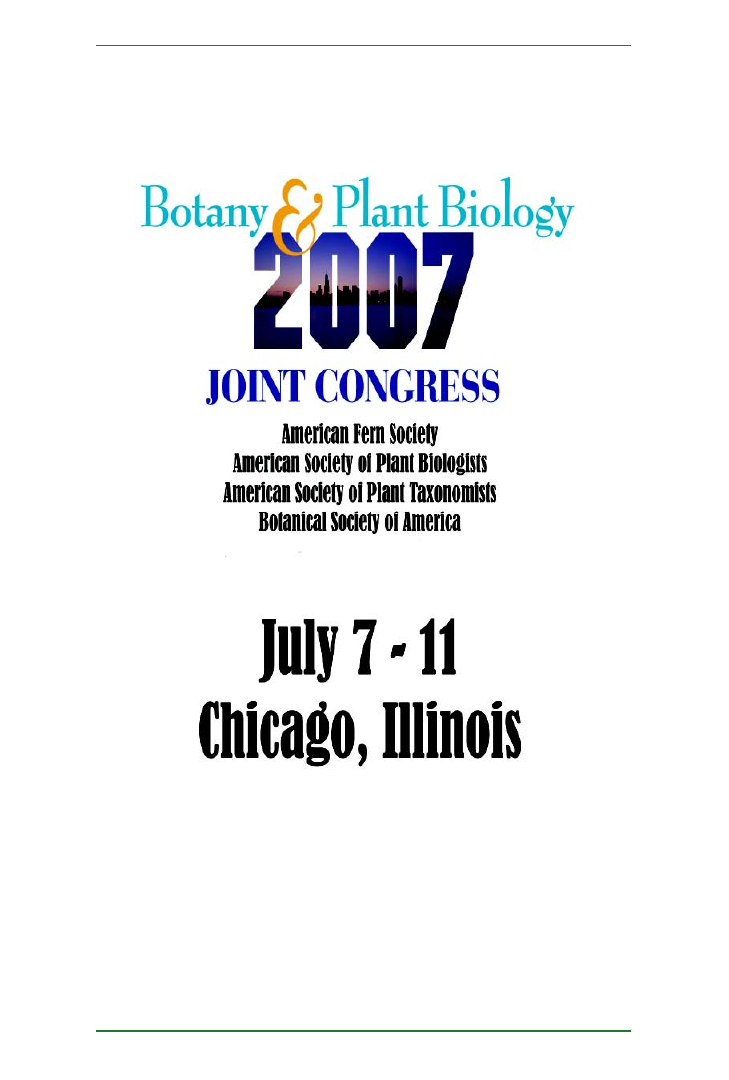
8 8
Plant Science Bulletin 53(2) 2007